#Modern warships release date
Explore tagged Tumblr posts
Note
Thank you for letting me vent! These warships are draining. If I see a pro Elriel post, I just mind my business. I know I'm not going to change their mind, nor do I want to. They are free to ship whoever they please.
But I do see a silver lining in all this. Over the year's things have gotten worse for them and it's not looking promising. I believe that is why they are getting more aggressive. What I mean is, when they do get SJM's attention, it never goes in their favor. For example:
Breads and roses, they swore this was El/riel confirmatio, prior to release and well, it was NOT. But in her HOSAB interview, she explained she was thinking what would be a warm welcome for Bryce, who thought she was in hell. Nothing more.
Gwyn's age, another theory that blew up in their face. SJM's not only shut it down, her face said it all. It is still one of my fave interviews.
ACOSF, before it's release El/riels dedicated so many posts and theories firmly believing this would be it for them, because it made sense right? Elain was closest to Nesta, Azriel to Cassian. This was the perfect opportunity to set them up, but SJM went an entirely different direction, and the two characters with least presence were Elain and Lucien. Watching their melt down was fascinating on twitter when the book was out, especially when the Italians who got an advance release date were going on about the chemistry between Az and a priestess, this was before the bonus chapter was even available. So if these readers, who had no idea of the bonus could pick up those crumbs, says a-lot about who's reading comprehension is off. Also, it is well known a ton of Elriels only skimmed ACOSF, I've seen tweets saying they do not want to read a book with that b*tch Gwyn. Just because one refuses to read something, does not change the outcome.
And that bonus chapter, why did a certain big pro elriel account rewrite the chapter and deleted Gwyn's part and tried to pass it off as published work? Did she think it was going to sway readers to el/riel, that was by far one of the dumbest things I've ever seen. If the bonus is not as important as they claim, why did they rewrite it? Waiting for them to make that make sense.
When SJM was promoting TOG, someone asked about Elain and Azriel and those in attendance shared her response on Twitter and they were crying and screaming on twitter when it was revealed she sees them as siblings - I know it is kinda weird that she did have them almost kiss BUT she actually did not have them kiss, so they could very well form a close subbing like bond later on, in the way Aelin does with Dorian, and they did in fact kiss.
Then fan during her Sept live who asked about Gwyn and the light singer theory. Her response was "not to sound mean but..." when anyone says "not to sound mean" it is the polite way of trying not to make you feel inferior for being wrong, but you are wrong. She even stated "another conspiracy theory" and kindly changed the topic. She did not fall for that question.
Lastly, I'm tired of seeing el/riels attack SJM's friends. Personally, I find it a win that her friends are anti elriels, does it mean I believe they know anything for a fact? I doubt it, but still, I know it makes el/riels so mad to see one of SJM's best friends vocalize she does not see Elain and Az as endgame anymore on her podcast.
Oh and when she was asked about modern vacations, she wasn't even asked about Elucien, yet she blurted it out and included them. El/riel's were not happy about it.
There are no interviews supporting Az and Elain the way there is for Elucien and where things stand in ACOSF it is not promising at all.
I think you're right. With more people coming to the conclusion that E/riel isn't happening it's caused them to get defensive. As far as Bread and Roses. I don't think SJM would give anything away if it was a clue that Elain was living in the townhouse but I am certain it wasn't a clue that E/riel was living together. If the next ACOTAR book picks up after CC3 that means the book would start with Elain and Az having kissed, had sex, fallen in love and moved in together off page. How does that make any sense? Why would you even want them for them? I also find it amusing that their arguments all end with "we have proof that Elain wanted to kiss Az!" after SF while they conveniently leave off the fact that Az told Elain that THEY WERE A MISTAKE. Do they honestly believe SJM would have left E/riels last interaction like that only to have her turn around and pretend like none of that happened at the start of the next book? That as a reader we're supposed to believe they just "talked it out" when we weren't even present for that conversation? They aren't paying attention to the kind of author SJM is if they really think that's what went down.
And SJM did have a million chances to push the narrative of an E/riel endgame but what she did instead is make it a point to tell us how different they are, how they haven't had any real progression in their emotional intimacy (even though Elain was open to getting to know Az), how Elain's sisters don't really consider her a close friend and how the IC doesn't really include her in important decisions. It really doesn't matter what happened two books back when this is the direction she's now headed. I so wish someone had a link to that interview, the one where she announced they were siblings. I've heard about it from a lot of people who remember it as you do but no one saved a link to it. I would LOVE to have that to post and share 😂 And it's not all that weird that she had them almost kiss or that they shared an attraction at one point when you consider Cassian and Mor. We know that Cassian was attracted to Mor and she found him somewhat appealing because they slept together. He admits that in ACOMAF, Mor was somewhere between friend and lover. Then in SF he tells us Mor has become family, his sister. So if that can happen then why can't the same be said for Elain and Az? Especially after they realize they were never really interested in one another for the right reasons anyway? The interview question about Gwyn and lightsingers is a whole big mess. I don't think SJM was even responding to Gwyn being an lightsinger or not because while the girl thought she was being sneaky on suggesting that Gwyn was a lightsinger, the actual question was "if lightsingers have a "beast" form and shadowsingers are the counterpart, do they also have a "beast" form?" and SJM laughed at conspiracy theories while giving an A+ for careful reading. So it answers nothing but also further confuses everything because she laughed at the theories while also complimenting their careful reading. It's a very typical SJM response, telling us nothing while also giving us something that both sides can claim as proof. Regardless though, what would it REALLY matter if Gwyn were a lightsinger (and that's not even saying she is)? But Rhys can mist people and enter their minds to do his bidding. Exactly why would Gwyn being a lightsinger automatically mean that removes her as a LI for Az. Az TORTURES people and doesn't blink at the thought of killing allies. Do they really think he'd be scared off by someone with a dark power? Just like not all daemati are bad, I think we can assume that not all lightsingers are bad (especially if they're only a quarter lightsinger). It could easily be a misunderstood power. And that's not even saying Gwyn is one, I'm just arguing that even if she were it wouldn't change the fact that she can still use something that's considered a dark power to protect the innocent. Just as Rhys does, just as Az does. At the end of the day, I can guarantee SJM is disgusted by the side of her fandom that threatens, bullies and harasses. It's amazing how E/riels that are guilty of it can't understand that.
9 notes
·
View notes
Text
Modern warships release date

#MODERN WARSHIPS RELEASE DATE HOW TO#
#MODERN WARSHIPS RELEASE DATE MOD APK#
#MODERN WARSHIPS RELEASE DATE UPDATE#
#MODERN WARSHIPS RELEASE DATE ANDROID#
All game models are designed to exact specifications and resemble real ships. You will take command of a modern warship. The most powerful contemporary battleships are waiting for you! Modern Warships is a realistic online action game where you can fight with your buddies. As a result, you should bookmark this page because it will always have the most up-to-date list of MODERN WARSHIPS Promo Codes. We understand how challenging it is to keep track of all the social media profiles for new codes. According to them, the best places to find new codes are Reddit, YouTube, Discord, Twitter and Twitch. The developers typically release new codes on special occasions such as community events, partnerships, anniversaries, or during the holiday season.
#MODERN WARSHIPS RELEASE DATE HOW TO#
Participate in weekly tournaments with in-game prizes.The following is the most recent list of MODERN WARSHIPS Codes: MODERN WARSHIPS CODE REWARDS 30000SUBSX Redeem this MODERN WARSHIPS promo code for exclusive rewards (Added on July 14th, 2022) MWDISCORD1ANNIVERSARY Use this MODERN WARSHIPS code for exclusive rewards (Added on July 12th, 2022) 20000SUBSX Redeem this MODERN WARSHIPS promo code for exclusive rewards WAS555BB5431 Use this promo MODERN WARSHIPS code for 2,000 Gold, 10,000,000 Dollars, 500 Upgrades and TMF 155 (155 MM) BANANIVERSARY Redeem this MODERN WARSHIPS promo code for 500 Gold ANN1VER5ARY Use this MODERN WARSHIPS code for 2,000 Gold, 10,000,000 Dollars and 500 Upgrades 83VB4UIY5687 Redeem this MODERN WARSHIPS promo code for 5,000,000 Dollars 2GD77W66E2Q Use this MODERN WARSHIPS code for 2,000 Gold 10000SUBSX Redeem this MODERN WARSHIPS promo code for 500 Gold TUI756BBV21 Use this MODERN WARSHIPS code for 500 Upgrades WEARESORRY Redeem this MODERN WARSHIPS promo code for 1,000 Gold How To Find New MODERN WARSHIPS Promo CodesĪre you finding it hard to get a new list of MODERN WARSHIPS Promo Codes?
#MODERN WARSHIPS RELEASE DATE ANDROID#
Top-notch graphics on Android with detailed ship models and effects – and optimized for a broad range of devices. Customize your warship with different weapons: missiles, guns, grenade launchers, and torpedo tubes – more than 200 weapon types wait for your command.īeautiful and realistic. Ships, submarines, carrier-based aircraft from different countries are at your command, each with its own distinctive gameplay. Choose your battleship from over 30 available models, made according to the drawings and real characteristics. Prove your commanding skills in fierce naval battles with players from all over the world. Legendary and new games from Wargaming for PC, iOS, Android, Xbox and Playstation. Contents 1 Gameplay 2 Release 3 Reception 3. A catalogue of games produced by the leading game developer in the CIS. And you'll be able to pilot deck helicopters and fighter jets! The PlayStation 4 and Xbox One console versions, titled World of Warships: Legends, followed in 2019 and were released on the PlayStation 5 and Xbox Series X/S in April 2021. The game has a wide range of weapons, including missiles, machine guns, rockets, and many more. All game models are made strictly according to the drawings and look like real ships. You'll become the captain of a modern battleship. The mightiest modern fighting ships are waiting for you! Fight with your friends in the realistic online action game Modern Warships.
#MODERN WARSHIPS RELEASE DATE MOD APK#
MODERN WARSHIPS Mod Apk All Ships Unlocked.
#MODERN WARSHIPS RELEASE DATE UPDATE#
Amazing graphics and simple controls: Players will feel great gaming experience via swift and simple controls.Ĭommand your warship in epic online sea battles Commander, show these rookies whos the real sea wolf Big update 0.45.5 is released. Various mighty warships and over 200 weapons: Log-in to receive daily free bonus and get more weapons. Online PVP sea battles: Experience the unique sea war. The shooter game, a marine PVP mode, where you control modern warships to battle against enemies.

0 notes
Text
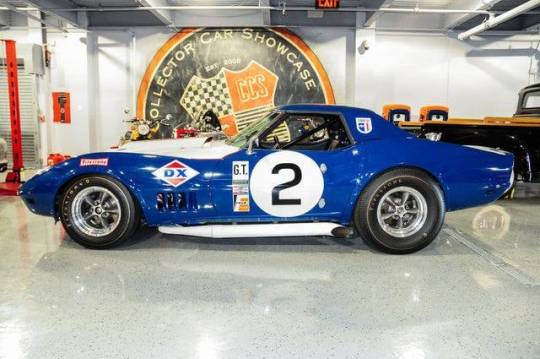
5 Things You Probably Didn't Know About The Corvette
On January 17, 1953, a prototype Chevrolet Corvette made its debut at the Motorama auto show in New York City. Here are five things you probably didn’t know about this iconic American muscle car...
1) The Name Corvette Came From A Warship The Corvette was a naval vessel that was small and fast and used throughout the 1800s and 1900s. In America, these smaller vessels were known as sloops and were employed during the War of 1812 at the Great Lakes and the Atlantic Ocean against more powerful British vessels. With a single tier of guns, the warships still remain popular with modern Navies to this day, with the ships now having a better design and more armor.
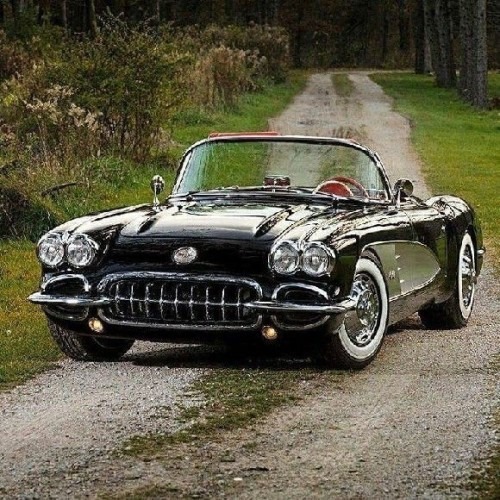
2) The Company Had To Change The Original Logo The Chevy Corvette's logo is an iconic part of the car. The Corvette’s first logo featured a checkered flag crossed with the American flag. While it looked good, there was a major problem. The company learned that using the American flag commercially on a product is actually illegal and had to be changed. Only four days before the car debuted, Chevrolet replaced the design with the checkered flag, which is still used today.
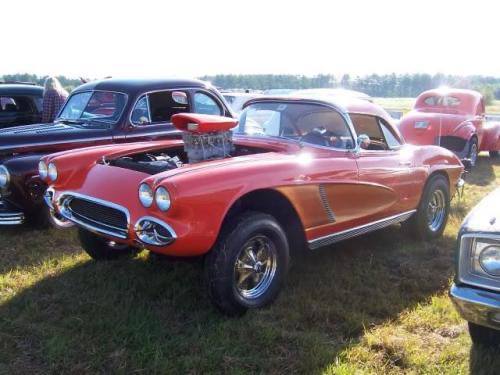
3) There Is Only One 1983 Model Chevrolet ran into problems with their 1983 Corvette, and as a result, no Corvettes were released that year. Although forty-three Corvettes were manufactured in 1983, all but one of them ended up being destroyed, with that final car now displayed in Bowling Green, Kentucky, at the National Corvette Museum.

4) It Is The Official Car Of Kentucky In 2010, the Chevrolet Corvette was named as Kentucky’s official sports car. This may not be much of a surprise, as the last Corvette factory in the country happens to be located in Bowling Green, Kentucky. The factory at Bowling Green gets consistent business and is a staple of Kentucky now, with people knowing about the location from far and wide.

5) The Fastest Corvette Isn't The Newest Corvette is not only a sharp-looking sports car, but it's often sought out by those who want speed in a vehicle. Although many people probably believe the newer models are faster because of advancements in technology, it isn’t true. To date, the fastest Corvette Stingray ever made was back in 1968 with the LT-2 with a top speed of 200 mph.
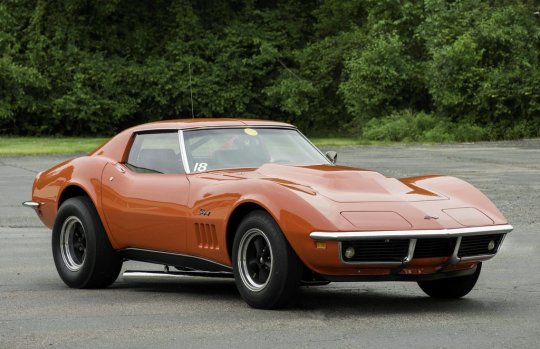
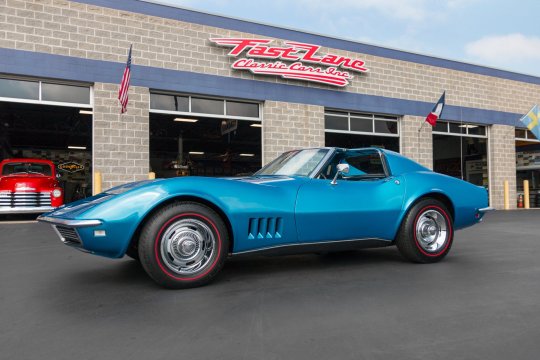

#corvette#general motors#chevrolet#cars#car#muscle car#american muscle#chevy#stingray#corvette stingray
111 notes
·
View notes
Text
Detroit: Become Human - Chronology and timeline of events... (CANON)
The chronology and timeline of events ( https://detroit-become-human.fandom.com/wiki/Chronology ) in the world of Detroit: Become Human.
pre-1960
1915: Birth of Arnold Brook.
1917: Zlatko Andronikov's family flees the revolution in Russia.
1960s
1963: Birth of Carl Manfred (July 13).
1970s
1978: Birth of Michael Brinkley (January 24), Amanda Stern (May 14).
1980s
1980: Birth of Gordon Penwick (June 10).
1982: Birth of Dennis Ward (June 11), Jeffrey Fowler (August 8).
1983: Birth of Christopher Gray (June 18).
1985: Birth of Hank Anderson (September 6), Cristina Warren (September 15).
1987: Birth of Jonah Graham (December 9).
1988: Birth of Joseph Sheldon (August 14), Gary Kayes (December 3).
1989: Birth of Derek Myers (May 7), Ben Collins (September 12).
1990s
1991: Birth of Zlatko Andronikov (September 21).
1992: Birth of Douglas Mitchell (August 10).
1993: Birth of Rose Chapman (March 31).
1994: Birth of Captain Allen (December 2).
1995: Birth of Edward Dempsey (February 8), Richard Perkins (July 13), Todd Williams (September 21).
1998:
1999: Birth of Isaac Falone (March 10), Elizabeth Wilson (March 25), John Phillips (October 11).
Death of Arnold Brook.[1]
Birth of Chris Roberts (May 16).
2000s
2000: Birth of Michael Webb (September 9).
2001: Birth of Jimmy Peterson (February 1), Caroline Phillips (May 23).
2002: Birth of Elijah Kamski (July 17), Gavin Reed (October 7).
2005: Birth of Pedro Aabdar (January 25), Rosanna Cartland (December 12).
2008: Birth of Carlos Ortiz (October 27).
2009: Birth of Nathan Clark (August 18), Chris Miller (September 30).
2010s
2010: Birth of Leo Manfred (March 21), Joss Douglas (October 24).
2012: Birth of Samuel McCray (April 10).
2013: Birth of Adam Chapman (August 5).
2018: Elijah Kamski founds CyberLife, creates first androids.
2020s
2021: Release of RT600 "Chloe".
2022: RT600 Chloe first android to pass the Turing test.
2024:
2027: CyberLife sells 1 millionth android.
2028:
2028or 2029: United States pass the Android Act.
2029: Hank Anderson promoted to the rank of lieutenant (reported on August 22).
Release of ST200 "Chloe", first industrially produced android.
CyberLife leased a disused warehouse. (Extras Gallery)
CyberLife starts the commercial production of androids.
KNC's interview with Chloe (April 25).
Release of JB100 OR Andy (12-2027).
Death of Amanda Stern (February 23).
Elijah Kamski named Century magazine's "Man of the Century". Later, Kamski resigns as CEO and leaves CyberLife.
Red Ice Task Force dismantles a Red Ice network (reported on February 3).
Birth of Emma Phillips (September 2).
Release of EM400 (2028), Jerry (06-2028).
Birth of Cole Anderson (September 23).
Release of PC200 and PM700.
2030s
2030:
2031:
2032: Release of AX400, Kara (04-2032).
2033:
2034:
2035:
2036:
2037: Rose Chapman starts helping deviants.
2038: the year Detroit: Become Human takes place.
CyberLife reaches market valuation of $850bn.
Release of TR400 OR Luther (01-2030), HK400 OR Carlos' Android (05-2031), URS12 Android Bear (10-2030).
Androids introduced into the United States military and Michigan law enforcement. Red Ice Task Force seizes boat with nearly 1t Red Ice (reported on November 23).
Release of Ralph (/WR600?) and PJ500 (2031), Josh (11-2031).
Birth of Sumo (April 2031).
Release of JB300 336 445 581 (/JB300?) (05-2033), YK500, Alice (07-2033).
Carlos Ortiz spent several stays in a psychiatric hospital in 2033.
Release of PL600 (2034), Simon (02-2034).
April 2034 Season Finals Detroit's Champions Take An Early Lead (Basketball Magazine poster around Hank's Desk)
Release of "Traci"s WR400 and HR400 (2035), North (10-2035).
Death of Cole Anderson (October 11)[8].
Detroit Gears basketball Playoffs (Seen at Hank's desk)
Cristina Warren elected President of the United States.
Carlos Ortiz spent several stays in a psychiatric hospital in 2036.
Release of KL900 OR Lucy, Rupert (possibly plus WB200?).
Reported missing: Simon (February 16), Rupert (October 11).
Death of Rose Chapman's husband (estimated, "died 2 years ago" in 2038[9]).
2038
The year 2038 is the temporal setting of Detroit: Become Human.
global population 10 billion.[10]
January-July
Edit
January
February
The first DPD case file about deviants ("dates back nine months")[11]
March
April
May
June
July
August
RK800 "Connor" released (08-2038).
Birth of Damian Miller ("three months ago" in November).
Aug 15th: Chapter "The Hostage".
around 7:30 PM: Daniel takes Emma Phillips hostage.
Death of John Phillips (estimated 07:29 PM), Officer Antony Deckart (estimated 08:03 PM), and another officer (found dead in the pool). Officer M. Wilson is wounded by Daniel, death optional.
CyberLife sends RK800 Connor as a hostage negotiator. ITM televises the hostage situation.
08:29 PM: Chapter "The Hostage" begins. Connor arrives at the Phillips apartment.
08:30 PM: DPD reports that a deviant android is involved. (ITM report)
September
09/14: An android waiter (AV500 #234 777 821) in Fast Coney Dogs attacks Charles Bell and escapes.
October
10/04: Gordon Lopez's AL series android disappears. North deviates at a customer's home and escapes.
10/05: Eden Club manager Floyd Mills reports to the police that North is missing.
10/06: North arrives in Jericho (North has been in Jericho "4 weeks, 3 days, 11 hours" on Nov 6 after 5 PM).
around 10/17: Carlos Ortiz killed by Carlos' Android. (Based on his body being dead for 19 days on Nov 5th)
10/22: An android (AP700 #480 913 802) attacks her owner Sarah Cornwal, the house, and escapes.
November
Friday Nov 5th: Chapters: Shades of Color, The Opening, A New Home, The Painter, Partners, Stormy Night, Broken, Fugitives
CyberLife zoo opens in Detroit.
Several Russian warships have taken position in the Barents Sea since Saturday October 30th. (CTN news)
09:38 AM: Chapter "Shades of Color" begins. Markus arrives in Greektown to pick up Carl's paint from Bellini Paints.
09:58 AM: Chapter "The Painter" begins. Markus arrives back at Carl Manfred's House.
03:24 PM: Chapter "The Opening" begins. Todd Williams picks up Kara at Android Zone.
04:53 PM: Chapter "A New Home" begins. Todd and Kara arrive at Todd Williams' house.
"around 8" (PM or AM): Landlord calls police because he found Carlos Ortiz's corpse.
09:14 PM: Chapter "Stormy Night" begins. Dinner in the Williams house.
09:42 PM: Chapter "Broken" begins. Markus and Carl arrive home from the opening of Carl Manfred's retrospective at the Museum of Modern Art.
10:58 PM: Chapter "Fugitives" begins. Kara and Alice to get off the bus in Camden.
11:21 PM: Chapter "Partners" begins. Connor arrives at Jimmy's Bar to pick up Hank Anderson.
Saturday Nov 6th: Chapters:
The Interrogation, From the Dead, Waiting for Hank..., On the Run, Jericho, The Nest, Time to Decide, Zlatko, Russian Roulette, Spare Parts, The Eden Club
During the night: Russian carrier and American patrol boat reported to have exchanged warning shots in Arctic, no casualties. (~CTN news[11])
KNC reports on the first artificial intelligence to write a book.
CTN reports that a CyberLife prototype detective android is assisting the DPD. (~CTN news[11][15])
President Cristina Warren makes speech to Congress, demanding that Russian troops withdraw from the Arctic region. (~CTN news[8])
N/A: Severe hurricanes blight Mid-West, dozens killed. (seen under the scrolling header during Waiting for Hank.) (~CTN news[8])
12:41 AM: Chapter "The Interrogation" begins. Hank interrogates Carlos' Android.
03:34 AM: Chapter "From the Dead" begins. Markus reboots in Solid Waste Landfill.
08:42 AM: Todd Williams' dead body is found by a friend and reported to the police. (If killed by Alice or Kara)
09:56 AM: Chapter "Waiting for Hank..." begins. Connor talks to Amanda. Then arrives at DPD Central Station.
10:25 AM: Chapter "On the Run" begins. Kara wakes in Camden.
03:02 PM: Chapter "The Nest" begins. Hank eats at Chicken Feed.
04:30 PM: Chapter "Jericho" begins. Markus travels to Ferndale Station.
06:24 PM (estimated[16]): Death of Michael Graham at Eden Club.
05:13 PM: Chapter "Time to Decide" begins. Markus meets Jericho androids.
07:45 PM: Chapter "Zlatko" begins. Kara and Alice arrive at Zlatko Andronikov's House.
07:51 PM: Chapter "Russian Roulette" begins. Connor talks to Amanda. Then visits Hank Anderson's home.
08:01 PM: Chapter "Spare Parts" begins. Jericho androids raid CyberLife Warehouse and Docks.
08:17 PM: Chapter "The Eden Club" begins. Connor and Hank arrive at the Eden Club.
Sunday Nov 7th:
Chapters: The Pirates' Cove, The Bridge, The Stratford Tower
01:02 AM: Chapter "The Pirates' Cove" begins. Kara's group travels by car.
01:19 AM: Chapter "The Bridge" begins. Connor and Hank in Riverside Park.
09:24 AM: Chapter "The Stratford Tower" begins. Markus sits on a street bench and gets an idea.
Monday Nov 8th:
Chapters: The Stratford Tower cont., Public Enemy, Midnight Train
01:30 PM: Chapter "The Stratford Tower" cont. Markus infiltrates the Stratford Tower.
01:59 PM: Markus is recording the message in Stratford Tower (Connor' "Pupil Reflection" scan is timestamped "13:59:54").
04:06 PM: Chapter "Public Enemy" begins. Connor talks to Amanda. Then Connor and Hank arrive at Stratford Tower Floor 79.
05:10 PM: Chapter "Midnight Train" begins. Kara's group arrives at Rose's Farm.
Tuesday Nov 9th:
Chapters: Capitol Park, Meet Kamski, Freedom March, Last Chance, Connor, Crossroads
01:51 AM: Chapter "Capitol Park" begins. Jericho androids discuss Stratford broadcast.
02:00 AM: Jericho android teams attack the five CyberLife stores in Detroit simultaneously. Markus and North arrive at Capitol Park 10 minutes previous.
11:17 AM: Chapter "Meet Kamski" begins. Hank (+/- Connor) arrives at Elijah Kamski's house.
12:04 PM: Chapter "Freedom March" begins. Markus on roof, reflecting.
04:13 PM: Chapter "Last Chance, Connor" begins. Connor talks to Amanda. At DPD, Connor has to find Jericho.
N/A: Military androids removed from service(~CTN news), resulting in armed forces losing 2/3 of effective personnel. Androids are ordered to be turned over to the authorities, to be delivered to the nearest police station or army barracks, to be put in camps. The lack of androids shuts down services and utilities such as hospitals, schools, water, electricity, networks. (~KNC news[19]) Detroit is under curfew.
09:34 PM: Chapter "Crossroads" begins. Kara's group is driving to find Jericho.
10:45 PM: FBI and military raid on Jericho (~Warren press announcement)
Wednesday Nov 10th:
Chapters: Night of the Soul
06:00 AM: national curfew declared (~Warren press announcement)
Chapter "Night of the Soul" begins.
04:17 PM: Markus visits Carl's grave. (Pay Respects)
07:31 PM: Markus visits Carl's house. (Welcome Home) Then Markus in church (Markus on Sacred Ground). OR Jericho androids in church without Markus. (Connor/North on Sacred Ground)
07:31 PM or N/A: Connor speaks to Amanda (Thin Ice), visits Hank (Hank's House).
N/A: Android leader gives speech in undiscovered Jericho. (Markus/North Among the People)
09:24 PM: President Cristina Warren press announcement on Jericho raid, curfew etc. (Battle for Detroit)
Thursday Nov 11th:
Chapters: Battle for Detroit (events from multiple paths)
N/A: The U.S. Army has set up temporary camps in most major cities (Los Angeles, Chicago, Houston, Boston, San Francisco) to gather and destroy androids. (KNC News report, which is heard in Kamski's house if everyone died)
"at/since dawn": Androids take to the streets, either in peaceful demonstration (Markus Demonstration) OR fighting to liberate camps (Markus Revolution).
10:48 PM: Connor arrives at CyberLife Tower. (Connor at the CyberLife Tower)
10:51 PM: Kara's group in West Side Industrial on the way to Bus Terminal. (Kara Leaving Detroit)
10:56 PM: Androids march down Woodward Avenue onto Hart Plaza (Markus Demonstration/Revolution/North)
11:01 PM:
11:02 PM: Kara's group reaches Bus Terminal. (Kara Leaving Detroit, Risky Checkpoint)
11:06 PM: Kara's group enters Enclosure. (Kara Captured)
11:07 PM:
11:08 PM:
11:15 PM: Kara's group reaches Bus Terminal. (Kara Leaving Detroit, Safer Detour)
11:15-30 PM: Last bus from Detroit Bus Terminal departs to Canada Border. Cross-border bus service is suspended afterwards.
11:16 PM: Hart Plaza barricade is attacked. (Markus Demonstration)
11:26 PM:
11:30 PM: Kara's group arrives at US-Canada Border. (Kara Leaving Detroit)
11:36 PM: Kara's group enters Canada. (Kara Leaving Detroit)
11:57 PM: Kara's group arrives at banks of Detroit River, Canada. (Kara Leaving Detroit)
presumably before midnight: President Cristina Warren gives speech (Battle for Detroit).
Connor arrives at Floor -49. (Connor at the CyberLife Tower) OR Connor on Hart Plaza rooftop. (Connor's Last Mission)
Androids at Hart Plaza launch attack. (Revolution)
Connor vs Connor-60. (Connor at the CyberLife Tower)
Hart Plaza final assault, Markus vs Connor, vs tank. (Revolution)
Androids in Hart Plaza barricade. Perkins offers deal. (Markus Demonstration)
Kara's group facing destruction in Hart Plaza camp. (Kara Captured)
Hart Plaza androids arrested, Markus killed (Markus Demonstration, surrender)
Kara's group arrives at banks of Detroit River, Delray. (Kara Leaving Detroit)
Friday Nov 12th:
Chapters: Battle for Detroit cont.
12:01 AM: Hart Plaza and CyberLife Tower android groups meet. Android leader gives speech. OR Machine Connor checks on Markus's corpse, after the latter's surrender to Perkins.
07:37 AM: Kara's group wakes in Solid Waste Landfill. (Kara Captured)
645 notes
·
View notes
Text
Events 1.30
1018 – Poland and the Holy Roman Empire conclude the Peace of Bautzen. 1287 – King Wareru founds the Hanthawaddy Kingdom, and proclaims independence from the Pagan Kingdom. 1607 – An estimated 200 square miles (51,800 ha) along the coasts of the Bristol Channel and Severn Estuary in England are destroyed by massive flooding, resulting in an estimated 2,000 deaths. 1648 – Eighty Years' War: The Treaty of Münster and Osnabrück is signed, ending the conflict between the Netherlands and Spain. 1649 – Charles I of England is executed in Whitehall, London. 1661 – Oliver Cromwell, Lord Protector of the Commonwealth of England, is ritually executed more than two years after his death, on the 12th anniversary of the execution of the monarch he himself deposed. 1703 – The Forty-seven rōnin, under the command of Ōishi Kuranosuke, avenge the death of their master, by killing Kira Yoshinaka. 1789 – Tây Sơn forces emerge victorious against Qing armies and liberate the capital Thăng Long. 1806 – The original Lower Trenton Bridge (also called the Trenton Makes the World Takes Bridge), which spans the Delaware River between Morrisville, Pennsylvania and Trenton, New Jersey, is opened. 1820 – Edward Bransfield sights the Trinity Peninsula and claims the discovery of Antarctica. 1826 – The Menai Suspension Bridge, considered the world's first modern suspension bridge, connecting the Isle of Anglesey to the north West coast of Wales, is opened. 1835 – In the first assassination attempt against a President of the United States, Richard Lawrence attempts to shoot president Andrew Jackson, but fails and is subdued by a crowd, including several congressmen as well as Jackson himself. 1847 – Yerba Buena, California is renamed San Francisco, California. 1858 – The first Hallé concert is given in Manchester, England, marking the official founding of The Hallé orchestra as a full-time, professional orchestra. 1862 – The first American ironclad warship, the USS Monitor is launched. 1889 – Archduke Crown Prince Rudolf of Austria, heir to the Austro-Hungarian crown, is found dead with his mistress Baroness Mary Vetsera in the Mayerling. 1902 – The first Anglo-Japanese Alliance is signed in London. 1908 – Indian pacifist and leader Mohandas Karamchand Gandhi is released from prison by Jan C. Smuts after being tried and sentenced to two months in jail earlier in the month. 1911 – The destroyer USS Terry makes the first airplane rescue at sea saving the life of Douglas McCurdy ten miles from Havana, Cuba. 1920 – Japanese carmaker Mazda is founded, initially as a cork-producing company. 1925 – The Government of Turkey expels Patriarch Constantine VI from Istanbul. 1930 – The Politburo of the Communist Party of the Soviet Union orders that a million prosperous peasant families be driven off their farms. 1933 – Adolf Hitler's rise to power: Hitler takes office as the Chancellor of Germany. 1942 – World War II: Japanese forces invade the island of Ambon in the Dutch East Indies. Some 300 captured Allied troops are killed after the surrender. One-quarter of the remaining POWs remain alive at the end of the war. 1944 – World War II: The Battle of Cisterna, part of Operation Shingle, begins in central Italy. 1945 – World War II: The Wilhelm Gustloff, overfilled with German refugees, sinks in the Baltic Sea after being torpedoed by a Soviet submarine, killing approximately 9,500 people. 1945 – World War II: Raid at Cabanatuan: One hundred and twenty-six American Rangers and Filipino resistance fighters liberate over 500 Allied prisoners from the Japanese-controlled Cabanatuan POW camp. 1948 – British South American Airways' Tudor IV Star Tiger disappears over the Bermuda Triangle. 1948 – Following the assassination of Mahatma Gandhi in his home compound, India's prime minister, Jawaharlal Nehru, broadcasts to the nation, saying "The light has gone out of our lives". The date of the assassination becomes observed as "Martyrs' Day" in India. 1956 – In the United States, Civil Rights Movement leader Martin Luther King Jr.'s home is bombed in retaliation for the Montgomery bus boycott. 1959 – The forces of the Sultanate of Muscat occupy the last strongholds of the Imamate of Oman, Saiq and Shuraijah, marking the end of Jebel Akhdar War in Oman. 1959 – MS Hans Hedtoft, specifically designed to operate in icebound seas, strikes an iceberg on her maiden voyage and sinks, killing all 95 aboard. 1960 – The African National Party is founded in Chad, through the merger of traditionalist parties. 1964 – In a bloodless coup, General Nguyễn Khánh overthrows General Dương Văn Minh's military junta in South Vietnam. 1968 – Vietnam War: Tet Offensive launch by forces of the Viet Cong and North Vietnamese Army against South Vietnam, the United States, and their allies. 1969 – The Beatles' last public performance, on the roof of Apple Records in London. The impromptu concert is broken up by the police. 1972 – The Troubles: Bloody Sunday: British paratroopers open fire on anti-internment marchers in Derry, Northern Ireland, killing 13 people; another person later dies of injuries sustained. 1972 – Pakistan leaves the Commonwealth of Nations in protest of its recognition of breakaway Bangladesh. 1974 – Pan Am Flight 806 crashes near Pago Pago International Airport in American Samoa, killing 97. 1975 – The Monitor National Marine Sanctuary is established as the first United States National Marine Sanctuary. 1979 – A Varig Boeing 707-323C freighter, flown by the same commander as Flight 820, disappears over the Pacific Ocean 30 minutes after taking off from Tokyo. 1982 – Richard Skrenta writes the first PC virus code, which is 400 lines long and disguised as an Apple boot program called "Elk Cloner". 1989 – The American embassy in Kabul, Afghanistan is closed. 1995 – Hydroxycarbamide becomes the first approved preventive treatment for sickle cell disease. 2000 – Kenya Airways Flight 431 crashes into the Atlantic Ocean off the coast of Ivory Coast, killing 169. 2013 – Naro-1 becomes the first carrier rocket launched by South Korea.
0 notes
Text
Mã Cheat Game Age Of Empire 2

All Age of Empires 2 cheats on one place. There are two things to keep in mind. First, we are huge fans of the AOE series, especially Age of Empires 2, and second, we do use cheats but only for fun. Bagi kalian yang sudah bermain game cukup lama pasti mengetahui game yang bernama Age of Empires 2 ini. Ya, Age of Empires 2 sendiri adalah seri kedua dari franchise Age of Empires. Seri pertamanya sendiri dirilis tepat pada tahun 1999 lalu. Age of Empires 2 sendiri adalah game membangun sebuah kerajaan yang sangat seru.
CHEAT ADD 50 BUSHI = add 50 samurai CHEAT ADD 50 SAMURAI = add 50 guards string 4 CHEAT ADD 50 GUN = add 50 musket guards string 4 North Korea (KOREANS): CHEAT ADD 50 HWARANG = add 50 guard shooters CHEAT ADD 50 FLAMING = add 50 ballistas Maya (MAYA): CHEAT ADD 50 BALAMOB=Add 50 Maya warriors CHEAT ADD 50 EAGLE= Add 50 Mayan Condor Warriors CHEAT ADD 50 RECOILLESS=Add 50 recoilless guns CHEAT ADD 50 DRAGON=Add 50 Dragon anti-tank missiles Mongolia (MONGOLS): CHEAT ADD 50 NOMAD=Add 50 nomads CHEAT ADD 50 STEPPE=Add 50 nomadic shooters CHEAT ADD 50 HORDE=Add 50 Mongolian shooters CHEAT ADD 50 GOLDEN=Add 50 Golden Armor Mongolian Archer String 4 Nubia (NUBIANS): CHEAT ADD 50 KUSHITE=Add 50 Kushit shooters String 4 CHEAT ADD 50 APEDEMAK=Add 50 Nubian shooters Rome (ROMANS): CHEAT ADD 50 LEGIONS=Add 50 Roman legions CHEAT ADD 50 CAESAR=Add 50 Caesar Warriors CHEAT ADD 50 PRAETORIAN=Add 50 Roman Guards Russia (RUSSIANS): CHEAT ADD 50 RUSINY=Add 50 Ross Lancers CHEAT ADD 50 COSSACK=Add 50 Cossacks CHEAT ADD 50 DON = add 50 guards Cossack cavalry CHEAT ADD 50 RED=Add 50 Red Army soldiers CHEAT ADD 50 KATYUSHA=Add 50 Katyusha rockets CHEAT ADD 50 SHOCK = add 50 Red Army assault infantry CHEAT ADD 50 T80=Add 50 T80 tanks String 4 Spain (SPANISH): CHEAT ADD 50 SCUTARI=Add 50 long shield infantry CHEAT ADD 50 TERCIOS=Add 50 conquerors Turkey (TURKS): CHEAT ADD 50 JANISSARIES=Add 50 janitors CHEAT ADD 50 BIMBARD = add 50 smoothbore guns CHEAT ADD 50 BASILICA=Add 50 Royal Smoothbore Cannon CHEAT ADD 50 CANNON=Add 50 cannons Finally, I add some general military intensive string 4 CHEAT ADD 50 ROCKET=Add 50 rockets CHEAT ADD 50 FLAMETHROW=Add 50 Flamethrowers This time I am supplementing the secrets of general arms. Everyone knows that there are eight different eras in the rise of the country. Therefore, the corresponding arms will be gradually upgraded with the advancement of the times. Below I will introduce most of the arms The cheats are published for everyone to exchange and correct For the era, A=ANCIENT AGE Ancient Times String 4 C=CLASSICAL AGE ME=MEDIEVAL AGE G=GUNPOWDER AGE Gunpowder Age E=ENLIGHTENMENT AGE INDUS=INDUSTRIAL AGE MO=MODERN AGE INFOR=INFORMATION AGE Each unit will be marked with the era, so I won’t translate it anymore. As for what it is, let’s see for yourself. CHEAT ADD 1 SENATE=Add a Senate (also built around the city to function) Below are the general arms of each period in the barracks (BARRACKS) (take 50 units as an example) There are four types of soldiers in the barracks, I will explain them one by one in order Throwing Soldiers CHEAT ADD 50 JAVELINEER Javelinman C string 4 CHEAT ADD 50 ARQUEBUSIERS Musketeer G CHEAT ADD 50 BAZOOKA Bazooka IMFOR Spearmen CHEAT ADD 50 PHALANX Phalanx C CHEAT ADD 50 PIKEMEN Pikemen ME CHEAT ADD 50 FUSILIERS Flintlocker E Archer Series CHEAT ADD 50 ARCHERS Archers C CHEAT ADD 50 CROSSMEN Crossbowmen ME CHEAT ADD 50 MUSKETEERS Mauser Bing E CHEAT ADD 50 RIFLEMEN Rifleman INDUS CHEAT ADD 50 INFANTRY Stormtrooper INFOR Pathfinder CHEAT ADD 50 SCOUT Scout A CHEAT ADD 50 EXPLORER Explorer ME CHEAT ADD 50 COMMANDO Assaulter INDUS CHEAT ADD 50 SPECIAL Special MO Then there is the cavalry barracks (STABLE) There are generally three types of cavalry 1 CHEAT ADD 50 LIGHT Hussar C CHEAT ADD 50 HUSSAR Cavalry E 2 String 4 CHEAT ADD 50 CATAPHRACT Armoured Cavalry C string 4 CHEAT ADD 50 KNIGHT Knight ME CHEAT ADD 50 CUIRASSIER Armored Cavalry E CHEAT ADD 50 TANK MO CHEAT ADD 50 MAIN main battle tank INFOR 3 CHEAT ADD 50 DRAGOON Heavy Cavalry G CHEAT ADD 50 CARABINEER Carbine Cavalry E CHEAT ADD 50 ARMORED armed cavalry INDUS Engineering Weapons Barracks (SIEGE) String 4 Generally there are two kinds CHEAT ADD 50 SUPPLY The cheats of the supply trucks of all ages. As the times advance, it will change its appearance without upgrading another kind CHEAT ADD 50 TREBUCHET Stone thrower ME CHEAT ADD 50 BOMBARD gun machine G string 4 CHEAT ADD 50 CANNON Concentrated Cannon E CHEAT ADD 50 ARTILLERY Cannon INDUS string 4 CHEAT ADD 50 HOWITZER Howitzer M The last is the shipyard There are generally four types, except fishing boats CHEAT ADD 50 FISH/FISHERMEN The secrets of fishing boats in all ages. As the times advance, it will change its appearance without upgrading 1 CHEAT ADD 50 TRIREME three-tier warship A CHEAT ADD 50 GALLEY C CHEAT ADD 50 CARRACK armed ship ME CHEAT ADD 50 FRIGATE G 2 CHEAT ADD 50 BARK Small sailboat A CHEAT ADD 50 DROMON fast ship C CHEAT ADD 50 CARAVEL light ship ME CHEAT ADD 50 CORVETTE Guarding Sword G CHEAT ADD 50 SLOOP Single sailboat E CHEAT ADD 50 DESTROYER destroyer INDUS CHEAT ADD 50 CRUISER cruiser MO string 4 CHEAT ADD 50 MISSLE guided missile cruiser INFOR 3 CHEAT ADD 50 DREAD Terror Ship INDUS CHEAT ADD 50 BATTKESHIP battleship M 4 CHEAT ADD 50 FIRESHIP Fireship G CHEAT ADD 50 SUBMARINE SUBMARINE INDUS Repeat the cheats for other non-combatants CHEAT ADD 50 CITIZEN=add citizen string 4 CHEAT ADD 50 SPY=Add spy string 4 CHEAT ADD 50 GENERAL = Add General CHEAT ADD 7 SCHOLAR=Add scholars (usually add 7) CHEAT ADD 50 CAR = add caravan CHEAT ADD 50 MERCHANT=Add merchant Note: Although the player can add the number of troops in the game, it is best to grasp a certain degree, so as not to add too much, resulting in the game being too stuck or even crashing.
Pages:12
Cheat Codes
To enter the following cheats, you must press (Enter) anytime during gameplay. Next, type the letters to the left, and press (Enter).
CodeEffect
PEPPERONI PIZZA 1000 food bonus
COINAGE 1000 gold bonus
QUARRY 1000 stone bonus
WOODSTOCK 1000 wood bonus
UPSIDFLINTMOBILE Accelerates your Chariot Archers
DIEDIEDIE All enemy units die
BIGDADDY Black sports car with a rocket launcher
STEROIDS Buildings and units are created instantly
King Arthur Changes all birds into Dragons
PHOTON MAN Create a guy in a white suit with a quick-fire laser gun
E=MC2 TROOPER Creates a guy in a white suit with a slow- firing nuke gun
Big Momma Creates a White Sports Car
POW Creates baby with rocket launcher
Stormbilly Creates some sort of walker
GAIA Gives you control over nature (but lose control over your own civilization)
KILLX Kill player X
Cheats For Age Of Empires 2
HOYOHOYO Priests are faster and stronger
NO FOG Removes the fog of war
REVEAL MAP Reveals the map
MEDUSA Transforms villagers to Medusas
DARK RAIN Turns a Bowman into a Composite Bowman which turns into a tree when not moving
BIG BERTHA Turns Heavy Catapults into Big Berthas
BLACK RIDER Turns Horse Archers into Black Riders
FLYING DUTCHMAN Upgrade your Catapult Tiremes/Juggernauts into Flying Dutchmen
die die die Win the battle
HARI KARI You lose the game
RESIGN You resign
HOME RUN You win the game
ICBM Your Ballistas and Helepolis have a 99+1 range
JACK BE NIMBLE Your catapults and stone throwers fire villagers, cows, etc.
Achievements
Campaign Achievements
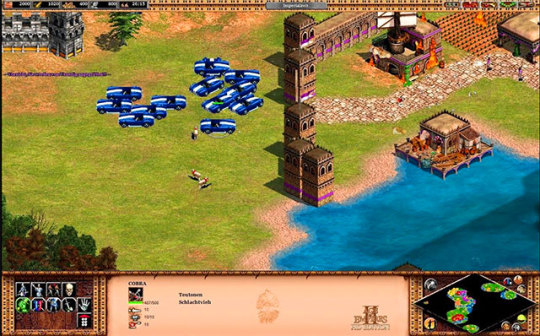
Roma Victrix – Complete the Rise of Rome campaign.
Vene, Vidi, Vici – Complete the Ave Caesar campaign.
Imperial Peace – Complete the Imperium Romana campaign.
The Elephant in the Rome – Complete the Enemies of Rome campaign.
Game of war cheat book. Punic Attack – Complete the first Punic War campaign.
Hittite Baby One More Time – Complete the Reign of the Hittites campaign.
Pharaoh – Complete the Ascent of Egypt learning campaign.
Smoking Ziggurats – Compete the Voices of Babylon campaign.
Epic – Complete the Glory of Greece campaign.
Big in Japan – Complete the Yamato Empires of the Rising Sun campaign.
Other Achievements
Homes? – Build 500 houses.
Towers of Babel – Build 50 Babylonian towers.
Rise and Wall – Build 789 Shang wall segments.
Not that I’m keeping count… – Defeat 1000 enemy units.
Hun, is that you? – Destroy 200 temples.
Heracles – Defeated a Lion (Alpha)
Age Of Empire 2 Cheat Code
Artemis – Hunt 250 animals.
Age Of Cheats
Parthian Shot – Train 500 horses.
21st Century – Train 21 Centurions.
Axe to Grind – Train 400 Axemen.
Cute Cats – Build 500 heavy catapults.
The Choson Ones – Create 1000 Choson Legions.
Dancing Chariots – Train 400 Assyrian Chariot Archers.
Minoan Compies – Train 100 Minoan Composite Bowman.
Release date january 5, 2020. https://renewja649.tumblr.com/post/655245136366895104/spongebob-ds-game-cheats.
Scytheseeing – Train 100 Egyptian Scythe Chariots.
Syntagma – Train 256 Macedonian Hoplites.
Wololo – Convert 1000 units.
Eye of Horus – Convert 20 units with Egyptian Priests.
Losing Your Religion – Convert an enemy Priest.
Atlas – Explore all areas of a single map.
Feet on the Ground – Win a random map without training any cavalry.
Eye in the Sky – Win a random map without training any archery units.
Related Posts:

0 notes
Text
Naval Armada coming to Linux as Free to Play

Naval Armada will bring the battle to Linux, Mac and Windows PC. Thanks to developer Extreme Developers. The multiplayer games is also going to release as Free to Play. Now listed on Steam. While following naval action. Naval Armada: World Warships is a PVP multiplayer action game "coming soon" to Steam. Where you choose battleships, navigate them and outwit the enemy. And it's due to release as free to play. Gameplay is very similar to that of the World of Warships game. But of course, this will have Linux support. So that players can take on an exciting sea MMORPG. Engaging in online battles and honing your PvP skills against other players. But Naval Armada also allows you to team up and play with friends. Hopefully, win some epic battles on torpedo boats. Such as destroyers, cruisers and battleships. You can expect to play 25 modern battleships. While you carefully arrange your ships on the Naval Armada battlefield. Then strike, using your arsenal and sink enemy vessels. Building your own game strategy to defeat opponents. Check out the trailer for an overview.
Naval Armada Release Trailer
youtube
As expected, there will be an in-game currency. This will offer a range of bonuses. Such as camouflage and graphics. Naval Armada will also have other upgrade features and characteristics. Due to release in a range of silver, gold and premium accounts. But the official website does not list these "characteristics". Or what is being offered with each account type yet. The FAQ and Knowledgebase are both "coming soon" still. But we have an overview of the features.
Features:
A great amount of warships!
Different classes of ships with different armament. From light guns to torpedoes and rockets!
Unique system of upgrades to each Naval Armada ship.
Various battle arenas from all corners of the world are waiting for you!
Modern 3D graphics.
User friendly controls which will be enjoyed both by newbie shooter players and harcore gameres.
Naval Armada MMORPG will have you fight with players from all over the world. So you can find out who is the best captain. But at this time, there is no release date. But the system specifications are looking very playable. Due to release on Linux, Mac and Windows PC. Check out the Steam page for further details.
#naval armada#strategy game#world warships#linux#gaming news#extreme developers#ubuntu#mac#windows#pc
0 notes
Text
Best New Science Fiction Books
https://ift.tt/2LtypGt
Here are the best new science fiction books in September 2019.
facebook
twitter
tumblr
There's so much to look forward to in our speculative fiction future. Here are some of the science fiction books we're most excited about and/or are currently consuming...
Join the Den of Geek Book Club!
Best New Science Fiction Books in July 2019

Wanderers by Chuck Wendig
Type: Novel Publisher: Del Rey Release date: 7/2/19
Shana wakes up one morning to discover her little sister in the grip of a strange malady. She appears to be sleepwalking. She cannot talk and cannot be woken up. And she is heading with inexorable determination to a destination that only she knows. But Shana and her sister are not alone. Soon they are joined by a flock of sleepwalkers from across America, on the same mysterious journey. And like Shana, there are other “shepherds” who follow the flock to protect their friends and family on the long dark road ahead.
For as the sleepwalking phenomenon awakens terror and violence in America, the real danger may not be the epidemic but the fear of it. With society collapsing all around them—and an ultraviolent militia threatening to exterminate them—the fate of the sleepwalkers depends on unraveling the mystery behind the epidemic. The terrifying secret will either tear the nation apart—or bring the survivors together to remake a shattered world.
Best New Science Fiction Books in June 2019

Fall; or, Dodge in Hell by Neal Stephenson
Type: Novel Publisher: William Morrow Release date: 6/4/19
In his youth, Richard “Dodge” Forthrast founded Corporation 9592, a gaming company that made him a multibillionaire. Now in his middle years, Dodge appreciates his comfortable, unencumbered life, managing his myriad business interests, and spending time with his beloved niece Zula and her young daughter, Sophia.
One beautiful autumn day, while he undergoes a routine medical procedure, something goes irrevocably wrong. Dodge is pronounced brain dead and put on life support, leaving his stunned family and close friends with difficult decisions. Long ago, when a much younger Dodge drew up his will, he directed that his body be given to a cryonics company now owned by enigmatic tech entrepreneur Elmo Shepherd. Legally bound to follow the directive despite their misgivings, Dodge’s family has his brain scanned and its data structures uploaded and stored in the cloud, until it can eventually be revived.
In the coming years, technology allows Dodge’s brain to be turned back on. It is an achievement that is nothing less than the disruption of death itself. An eternal afterlife—the Bitworld—is created, in which humans continue to exist as digital souls.
But this brave new immortal world is not the Utopia it might first seem . . .
Fall, or Dodge in Hell is pure, unadulterated fun: a grand drama of analog and digital, man and machine, angels and demons, gods and followers, the finite and the eternal. In this exhilarating epic, Neal Stephenson raises profound existential questions and touches on the revolutionary breakthroughs that are transforming our future. Combining the technological, philosophical, and spiritual in one grand myth, he delivers a mind-blowing speculative literary saga for the modern age.
Read Fall by Neal Stephenson
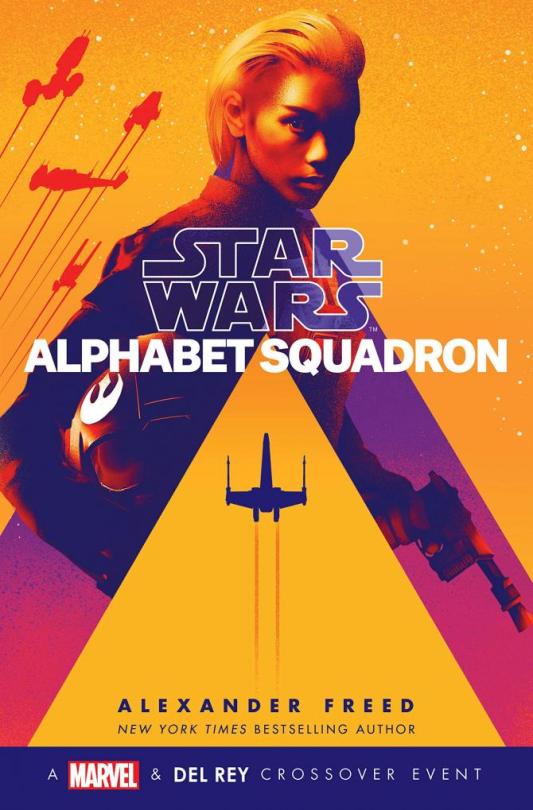
Alphabet Squadron by Alexander Freed
Type: Novel set in Star Wars universe Publisher: Del Rey Release date: 6/11/19
The Emperor is dead. His final weapon has been destroyed. The Imperial Army is in disarray. In the aftermath, Yrica Quell is just one of thousands of defectors from her former cause living in a deserters’ shantytown—until she is selected to join Alphabet Squadron. Cobbled together from an eclectic assortment of pilots and starfighters, the five members of Alphabet are tasked by New Republic general Hera Syndulla herself. Like Yrica, each is a talented pilot struggling to find their place in a changing galaxy. Their mission: to track down and destroy the mysterious Shadow Wing, a lethal force of TIE fighters exacting bloody, reckless vengeance in the twilight of their reign. The newly formed unit embodies the heart and soul of the Rebellion: ragtag, resourceful, scrappy, and emboldened by their most audacious victory in decades. But going from underdog rebels to celebrated heroes isn’t as easy as it seems, and their inner demons threaten them as much as their enemies among the stars. The wayward warriors of Alphabet Squadron will have to learn to fly together if they want to protect the new era of peace they’ve fought so hard to achieve.
Part of a Marvel and Del Rey crossover event, Alphabet Squadron is the counterpart to Marvel’s TIE Fighter miniseries, which follows the exploits of Shadow Wing as they scheme to thwart the New Republic.
Read Alphabet Squadron by Alexander Freed
Read more about Alphabet Squadron here.
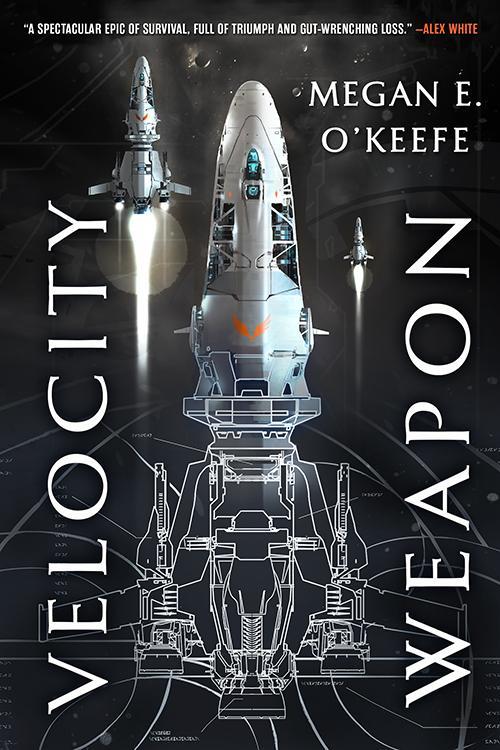
Velocity Weapon by Megan E. O'Keefe
Type: Book one in the Protectorate series Publisher: Orbit Release date: 6/11/19
Sanda and Biran Greeve were siblings destined for greatness. A high-flying sergeant, Sanda has the skills to take down any enemy combatant. Biran is a savvy politician who aims to use his new political position to prevent conflict from escalating to total destruction.
However, on a routine maneuver, Sanda loses consciousness when her gunship is blown out of the sky. Instead of finding herself in friendly hands, she awakens 230 years later on a deserted enemy warship controlled by an AI who calls himself Bero. The war is lost. The star system is dead. Ada Prime and its rival Icarion have wiped each other from the universe.
Now, separated by time and space, Sanda and Biran must fight to put things right.
Read Velocity Weapon by Megan E. O'Keefe

Empress of Forever by Max Gladstone
Type: Novel Publisher: Tor Books Release date: 6/18/19
A wildly successful innovator to rival Steve Jobs or Elon Musk, Vivian Liao is prone to radical thinking, quick decision-making, and reckless action. On the eve of her greatest achievement, she tries to outrun people who are trying to steal her success.
In the chilly darkness of a Boston server farm, Viv sets her ultimate plan into motion. A terrifying instant later, Vivian Liao is catapulted through space and time to a far future where she confronts a destiny stranger and more deadly than she could ever imagine.
The end of time is ruled by an ancient, powerful Empress who blesses or blasts entire planets with a single thought. Rebellion is literally impossible to consider--until Vivian Liao arrives. Trapped between the Pride―a ravening horde of sentient machines―and a fanatical sect of warrior monks who call themselves the Mirrorfaith, Viv must rally a strange group of allies to confront the Empress and find a way back to the world and life she left behind.
A magnificent work of vivid imagination and universe-spanning action, Empress of Forever is a feminist Guardians of the Galaxy crossed with Star Wars and spiced with the sensibility and spirit of Iain M. Banks and William Gibson.
Read Empress of Forever by Max Gladstone
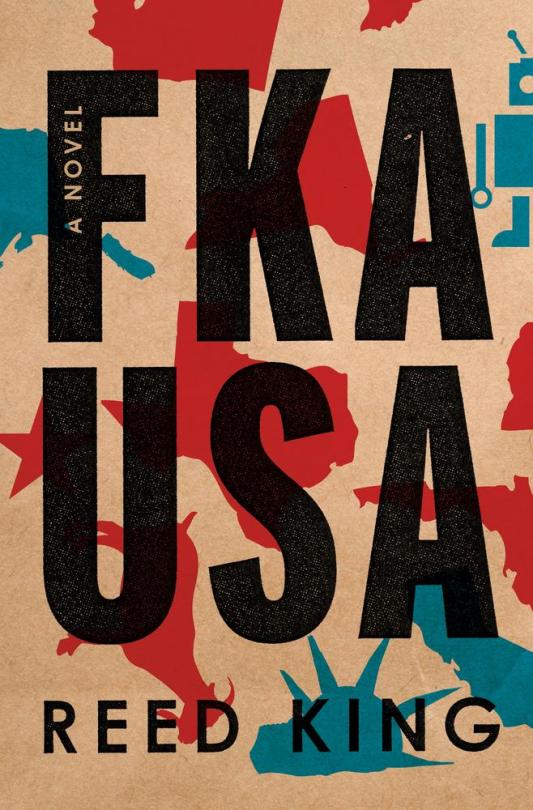
FKA USA by Reed King
Type: Novel Publisher: Flatiron Books Release date: 6/18/19
In Reed King’s wildly imaginative and possibly prescient debut, the United States has dissolved in the wake of environmental disasters and the catastrophic policies of its final president.
It is 2085, and Truckee Wallace, a factory worker in Crunchtown 407 (formerly Little Rock, Arkansas, before the secessions), has no grand ambitions besides maybe, possibly, losing his virginity someday.
But when Truckee is thrust unexpectedly into the spotlight he is tapped by the President for a sensitive political mission: to deliver a talking goat across the continent. The fate of the world depends upon it.
The problem is―Truckee’s not sure it’s worth it.
Joined on the road by an android who wants to be human and a former convict lobotomized in Texas, Truckee will navigate an environmentally depleted and lawless continent with devastating―and hilarious―parallels to our own, dodging body pickers and Elvis-worshippers and logo girls, body subbers, and VR addicts.
Elvis-willing, he may even lose his virginity.
FKA USA is the epic novel we’ve all been waiting for about the American end of times, with its unavoidable sense of being on the wrong end of the roller coaster ride. It is a masterwork of ambition, humor, and satire with the power to make us cry, despair, and laugh out loud all at once. It is a tour de force unlike anything else you will read this year.
Read FKA USA by Reed King
Read more about FKA USA here.

The Girl in Red by Christina Henry
Type: Novel Publisher: Berkley Release date: 6/18/19
It's not safe for anyone alone in the woods. There are predators that come out at night: critters and coyotes, snakes and wolves. But the woman in the red jacket has no choice. Not since the Crisis came, decimated the population, and sent those who survived fleeing into quarantine camps that serve as breeding grounds for death, destruction, and disease. She is just a woman trying not to get killed in a world that doesn't look anything like the one she grew up in, the one that was perfectly sane and normal and boring until three months ago.
There are worse threats in the woods than the things that stalk their prey at night. Sometimes, there are men. Men with dark desires, weak wills, and evil intents. Men in uniform with classified information, deadly secrets, and unforgiving orders. And sometimes, just sometimes, there's something worse than all of the horrible people and vicious beasts combined.
Red doesn't like to think of herself as a killer, but she isn't about to let herself get eaten up just because she is a woman alone in the woods....
Read The Girl in Red by Christina Henry
Read about Christina Henry's previous book, Lost Boy, here.
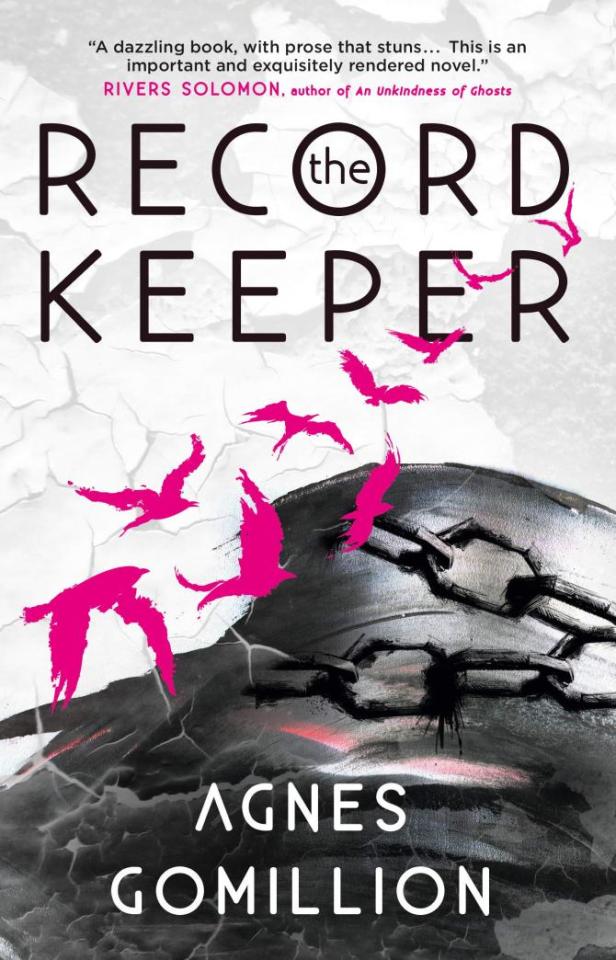
The Record Keeper by Agnes Gomillion
Type: Novel Publisher: Titan Books Release date: 6/18/19
After World War III, Earth is in ruins, and the final armies have come to a reluctant truce. Everyone must obey the law--in every way--or risk shattering the fragile peace and endangering the entire human race.
Arika Cobane is on the threshold of taking her place of privilege as a member of the Kongo elite after ten grueling years of training. But everything changes when a new student arrives speaking dangerous words of treason: What does peace matter if innocent lives are lost to maintain it? As Arika is exposed to new beliefs, she realizes that the laws she has dedicated herself to uphold are the root of her people's misery. If Arika is to liberate her people, she must unearth her fierce heart and discover the true meaning of freedom: finding the courage to live--or die--without fear.
Read The Record Keeper by Agnes Gomillion

The Girl Who Could Move Sh*t with Her Mind by Jackson Ford
Type: Novel Publisher: Orbit Release date: 6/18/19
Teagan Frost is having a hard time keeping it together. Sure, she's got telekinetic powers -- a skill that the government is all too happy to make use of, sending her on secret break-in missions that no ordinary human could carry out. But all she really wants to do is kick back, have a beer, and pretend she's normal for once.
But then a body turns up at the site of her last job -- murdered in a way that only someone like Teagan could have pulled off. She's got 24 hours to clear her name - and it's not just her life at stake. If she can't unravel the conspiracy in time, her hometown of Los Angeles will be in the crosshairs of an underground battle that's on the brink of exploding . . .
Read The Girl Who Could Move Sh*t with Her Mind by Jackson Ford

Hexarchate Stories by Yoon Ha Lee
Type: Short story collection set in the Machineries of Empire series Publisher: Solaris Release date: 6/25/19
From New York Times best-selling author Yoon Ha Lee. The essential short story collection set in the universe of the Hugo Award nominated Machineries of Empire series!
An ex-Kel art thief has to save the world from a galaxy-shattering prototype weapon...
A general outnumbered eight-to-one must outsmart his opponent...
A renegade returns from seclusion to bury an old comrade...
From the incredible imagination of Hugo- and Arthur C. Clarke-nominated author Yoon Ha Lee comes a collection of stories set in the world of the best-selling Ninefox Gambit. Showcasing Lee’s extraordinary imagination, this collection takes you to the very beginnings of the hexarchate’s history and reveals new never-before-seen stories.
Read Hexarchate Stories by Yoon Ha Lee
Best New Science Fiction Books in May 2019

Exhalation: Stories by Ted Chiang
Type: Short story collection Publisher: Knopf Release date: 5/7/19
From the acclaimed author of Stories of Your Life and Others—the basis for the Academy Award –nominated film Arrival—comes a groundbreaking new collection of short fiction: nine stunningly original, provocative, and poignant stories. These are tales that tackle some of humanity’s oldest questions along with new quandaries only Ted Chiang could imagine.
In “The Merchant and the Alchemist’s Gate,” a portal through time forces a fabric seller in ancient Baghdad to grapple with past mistakes and second chances. In “Exhalation,” an alien scientist makes a shocking discovery with ramifications that are literally universal. In “Anxiety Is the Dizziness of Freedom,” the ability to glimpse into alternate universes necessitates a radically new examination of the concepts of choice and free will.
Including stories being published for the first time as well as some of his rare and classic uncollected work, Exhalation is Ted Chiang at his best: profound, sympathetic—revelatory.
Read Exhalation: Stories by Ted Chiang

Light From Other Stars by Erika Swyler
Type: Standalone Publisher: Bloomsbury Publishing Release date: 5/7/19
From the author of national bestseller The Book of Speculation, a poignant, fantastical novel about the electric combination of ambition and wonder that keeps us reaching toward the heavens.
Eleven-year-old Nedda Papas is obsessed with becoming an astronaut. In 1986 in Easter, a small Florida Space Coast town, her dreams seem almost within reach--if she can just grow up fast enough. Theo, the scientist father she idolizes, is consumed by his own obsessions. Laid off from his job at NASA and still reeling from the loss of Nedda's newborn brother several years before, Theo turns to the dangerous dream of extending his living daughter's childhood just a little longer. The result is an invention that alters the fabric of time.
Amidst the chaos that erupts, Nedda must confront her father and his secrets, the ramifications of which will irrevocably change her life, her community, and the entire world. But she finds an unexpected ally in Betheen, the mother she's never quite understood, who surprises Nedda by seeing her more clearly than anyone else. Decades later, Nedda has achieved her long-held dream, and as she floats in antigravity, far from earth, she and her crewmates face a serious crisis. Nedda may hold the key to the solution, if she can come to terms with her past and the future that awaits her.
Light from Other Stars is about fathers and daughters, women and the forces that hold them back, and the cost of meaningful work. It questions how our lives have changed, what progress looks like, and what it really means to sacrifice for the greater good.
Read Light From Other Stars by Erika Swyler
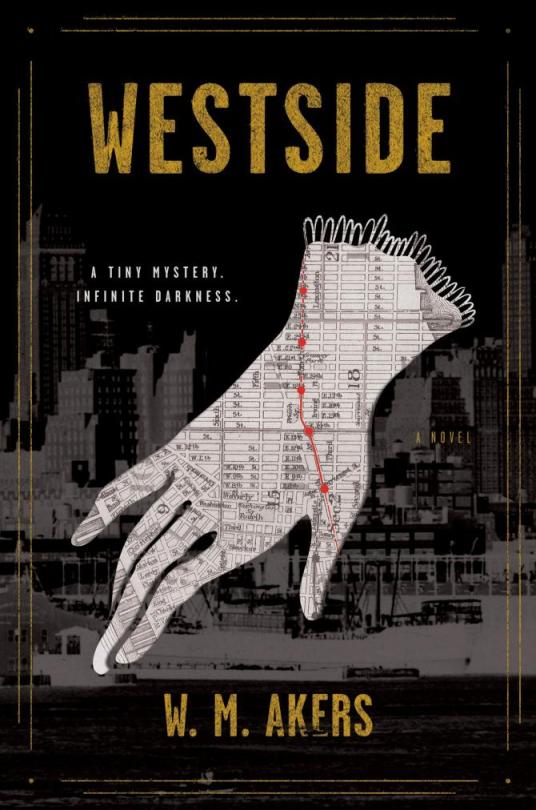
Westside: A Novel by W.M. Akers
Type: Standalone Publisher: Harper Voyager Release date: 5/7/19
New York is dying, and the one woman who can save it has smaller things on her mind.
A young detective who specializes in “tiny mysteries” finds herself at the center of a massive conspiracy in this beguiling historical fantasy set on Manhattan’s Westside—a peculiar and dangerous neighborhood home to strange magic and stranger residents—that blends the vivid atmosphere of Caleb Carr with the imaginative power of Neil Gaiman.
It’s 1921, and a thirteen-mile fence running the length of Broadway splits the island of Manhattan, separating the prosperous Eastside from the Westside—an overgrown wasteland whose hostility to modern technology gives it the flavor of old New York. Thousands have disappeared here, and the respectable have fled, leaving behind the killers, thieves, poets, painters, drunks, and those too poor or desperate to leave.
It is a hellish landscape, and Gilda Carr proudly calls it home.
Slightly built, but with a will of iron, Gilda follows in the footsteps of her late father, a police detective turned private eye. Unlike that larger-than-life man, Gilda solves tiny mysteries: the impossible puzzles that keep us awake at night; the small riddles that destroy us; the questions that spoil marriages, ruin friendships, and curdle joy. Those tiny cases distract her from her grief, and the one impossible question she knows she can’t answer: “How did my father die?”
Yet on Gilda’s Westside, tiny mysteries end in blood—even the case of a missing white leather glove. Mrs. Copeland, a well-to-do Eastside housewife, hires Gilda to find it before her irascible merchant husband learns it is gone. When Gilda witnesses Mr. Copeland’s murder at a Westside pier, she finds herself sinking into a mire of bootlegging, smuggling, corruption—and an evil too dark to face.
All she wants is to find one dainty ladies’ glove. She doesn’t want to know why this merchant was on the wrong side of town—or why he was murdered in cold blood. But as she begins to see the connection between his murder, her father’s death, and the darkness plaguing the Westside, she faces the hard truth: she must save her city or die with it.
Introducing a truly remarkable female detective, Westside is a mystery steeped in the supernatural and shot through with gunfights, rotgut whiskey, and sizzling Dixieland jazz. Full of dazzling color, delightful twists, and truly thrilling action, it announces the arrival of a wonderful new talent.
Read Westwide by W.M. Akers
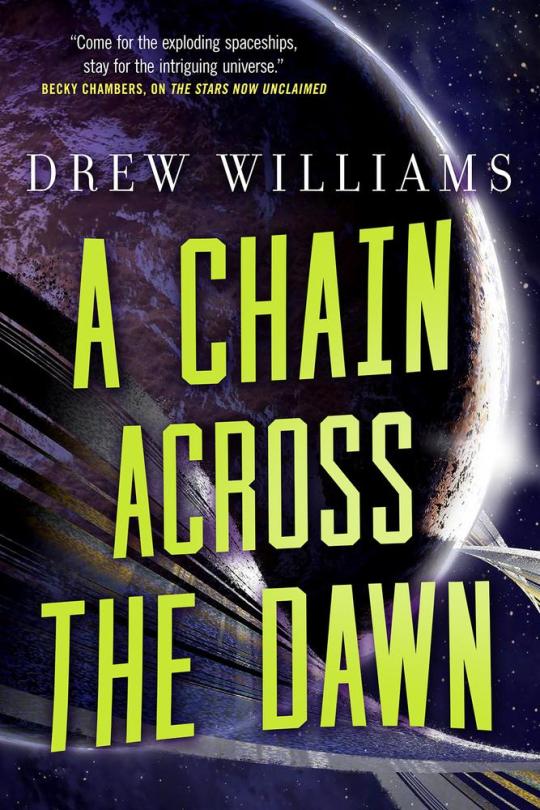
A Chain Across the Dawn by Drew Williams
Type: Second book in The Universe After series Publisher: Tor Books Release date: 5/7/19
It’s been three years since Esa left her backwater planet to join the ranks of the Justified. Together, she and fellow agent Jane Kamali have been traveling across the known universe, searching for children who share Esa’s supernatural gifts.
On a visit to a particularly remote planet, they learn that they’re not the only ones searching for gifted children. They find themselves on the tail of a mysterious being with impossible powers who will stop at nothing to get his hands on the very children that Esa and Jane are trying to save.
With their latest recruit in tow―a young Wulf boy named Sho―Esa and Jane must track their strange foe across the galaxy in search of answers. But the more they learn, the clearer it becomes―their enemy may be harder to defeat than they ever could have imagined.
Read A Chain Across the Dawn by Drew Williams
Read our review of the first book in the series here.

Children of Ruin by Adrian Tchaikovsky
Type: Second book in Children of Time series Publisher: Orbit Release date: 5/14/19
Thousands of years ago, Earth's terraforming program took to the stars. On the world they called Nod, scientists discovered alien life - but it was their mission to overwrite it with the memory of Earth. Then humanity's great empire fell, and the program's decisions were lost to time.
Aeons later, humanity and its new spider allies detected fragmentary radio signals between the stars. They dispatched an exploration vessel, hoping to find cousins from old Earth.
But those ancient terraformers woke something on Nod better left undisturbed.
Read Children of Ruin by Adrian Tchaikovsky

Her Silhouette, Drawn in Water by Vylar Kaftan
Type: Novella Publisher: Tor.com Release date: 5/21/19
All Bee has ever known is darkness.
She doesn’t remember the crime she committed that landed her in the cold, twisting caverns of the prison planet Colel-Cab with only fellow prisoner Chela for company. Chela says that they’re telepaths and mass-murderers; that they belong here, too dangerous to ever be free. Bee has no reason to doubt her―until she hears the voice of another telepath, one who has answers, and can open her eyes to an entirely different truth.
Read Her Silhouette, Drawn in Water by Vylar Kaftan
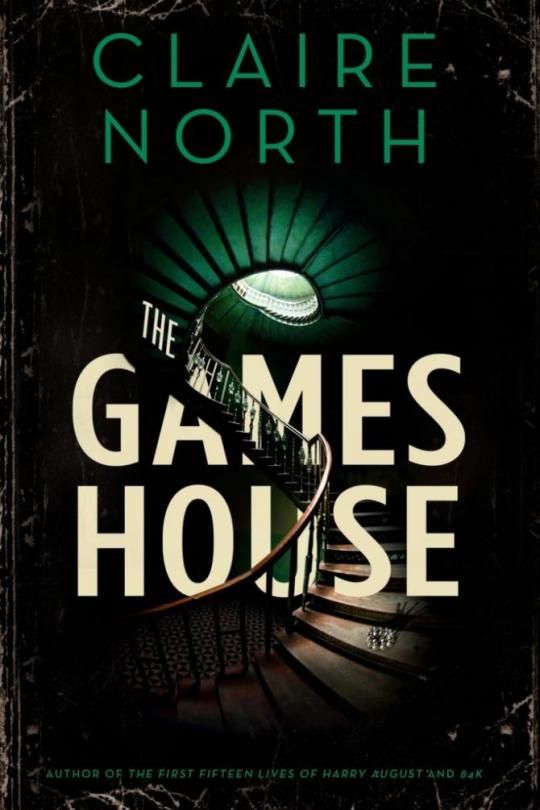
The Gameshouse by Claire North
Type: Trilogy of novellas Publisher: Orbit Release date: 5/28/19
The World Fantasy Award-winning author of The First Fifteen Lives of Harry Augustpresents a mesmerizing tale of a gambling house whose deadly games of chance and skill control the fate of empires.
Everyone has heard of the Gameshouse. But few know all its secrets...
It is the place where fortunes can be made and lost through chess, backgammon - every game under the sun.
But those whom fortune favors may be invited to compete in the higher league... a league where the games played are of politics and empires, of economics and kings. It is a league where Capture the Castle involves real castles, where hide and seek takes place on the scale of a continent.
Among those worthy of competing in the higher league, three unusually talented contestants play for the highest stakes of all...
Read The Gameshouse by Claire North
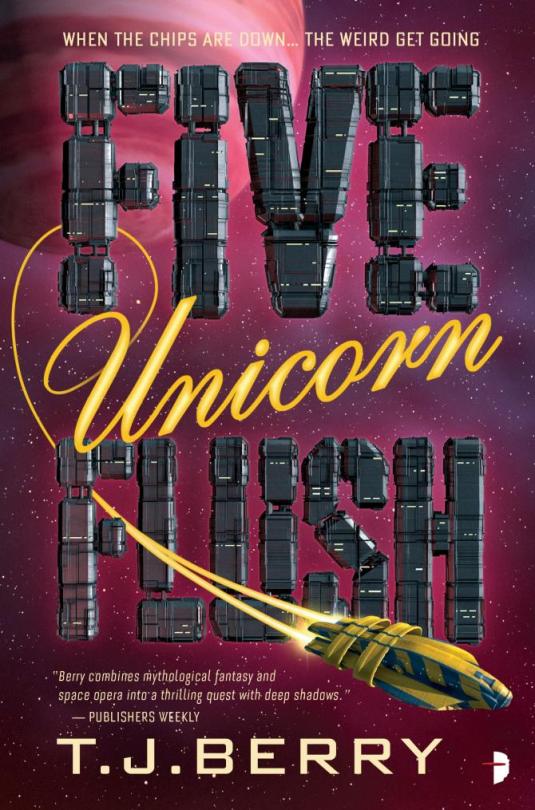
Five Unicorn Flush by TJ Berry
Type: Second book in The Reason series Publisher: Angry Robot Release date: 5/28/19
Only one woman with a magical parasite can unite the galaxy, in the mind-blowing SF sequel to Space Unicorn Blues
Reasonspace is in shambles after the disappearance of all magical creatures. Without faster-than-light travel, supply and communication routes have dried up, leaving humankind stranded and starving. Cowboy Jim and his complement of Reason soldiers search for the relocated Bala using the only surviving FTL drive. On their new utopian planet, the Bala are on the brink of civil war between those who want peace under old-fashioned unicorn rule and those who seek revenge on their human oppressors. Only Captain Jenny and her new brain parasite can stop the Reason plan to enslave the Bala again.
Read Five Unicorn Flush by TJ Berry
Best New Science Fiction Books in April 2019
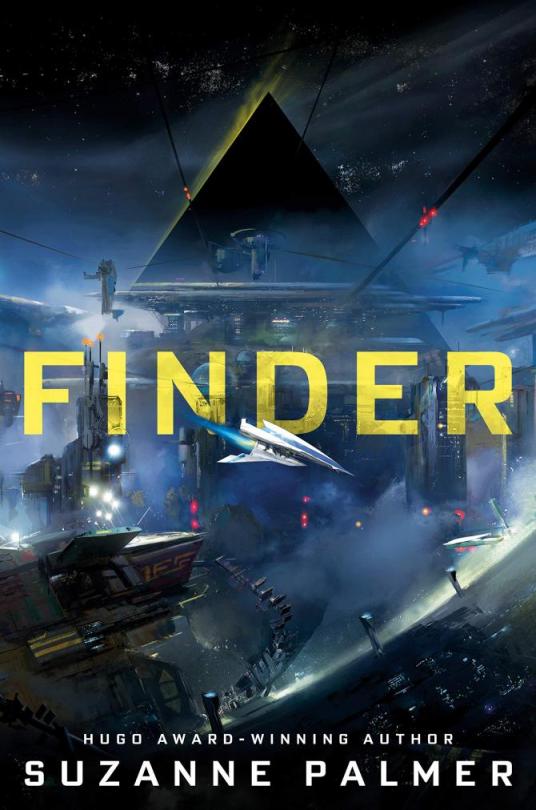
Finder by Suzanne Palmer
Type: Novel Publisher: DAW Release date: 4/2/19
From Hugo Award-winning debut author Suzanne Palmer comes an action-packed sci-fi caper starring Fergus Ferguson, interstellar repo man and professional finder Fergus Ferguson has been called a lot of names: thief, con artist, repo man. He prefers the term finder. His latest job should be simple. Find the spacecraft Venetia's Sword and steal it back from Arum Gilger, ex-nobleman turned power-hungry trade boss. He’ll slip in, decode the ship’s compromised AI security, and get out of town, Sword in hand.
Fergus locates both Gilger and the ship in the farthest corner of human-inhabited space, a backwater deep space colony called Cernee. But Fergus’ arrival at the colony is anything but simple. A cable car explosion launches Cernee into civil war, and Fergus must ally with Gilger’s enemies to navigate a field of space mines and a small army of hostile mercenaries. What was supposed to be a routine job evolves into negotiating a power struggle between factions. Even worse, Fergus has become increasingly—and inconveniently—invested in the lives of the locals. It doesn’t help that a dangerous alien species Fergus thought mythical prove unsettlingly real, and their ominous triangle ships keep following him around. Foolhardy. Eccentric. Reckless. Whatever he’s called, Fergus will need all the help he can get to take back the Sword and maybe save Cernee from destruction in the process.
Read Finder by Suzanne Palmer
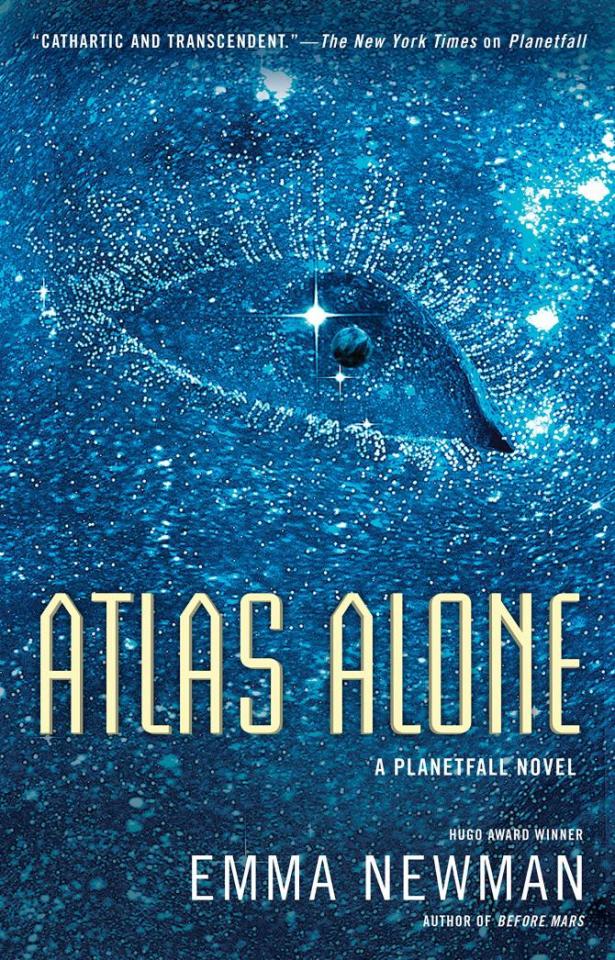
Atlas Alone by Emma Newman
Type: Book four in Planetfall series Publisher: Ace Release date: 4/16/19
Hugo Award winner Emma Newman returns to the captivating Planetfall universe with a novel about vengeance and the lengths to which one will go to save the future of humanity.
Six months after she left, Dee is struggling to manage her rage toward the people who ordered the nuclear strike that destroyed Earth. She’s trying to find those responsible, but she’s not getting very far alone.
A dedicated gamer, Dee is endeavoring to discover a mersive good enough to enable her to escape her trauma. When she is approached by a designer who asks her to play test his new game, she hopes it will be what she needs—but it isn’t like any mersive she’s played before. When a man suddenly dies in the real world, she realizes that at the same time in the game, she killed a character who bears a striking resemblance to the dead man—a man she discovers was one of those responsible for the death of millions on Earth.
Disturbed, but thinking it must be a coincidence, Dee continues the hunt for information. But when she finds out the plans for the future colony, she realizes that to save what is left of humanity, she might have to do something that risks what remains of her own.
Read Atlas Alone by Emma Newman
Read our review of Before Mars, the third book in the Planetfall series.

Winds of Marque: Blackwood & Virtue by Bennett R. Coles
Type: First book in series Publisher: HarperVoyager Release date: 4/16/19
The first novel in an exciting science fiction series—Master and Commander in space—a swashbuckling space adventure in which a crew of misfit individuals in the king’s navy are sent to dismantle a dangerous ring of pirate raiders.
In a dense star cluster, the solar winds blow fiercely. The star sailing ship HMSS Daring is running at full sheet with a letter of marque allowing them to capture enemy vessels involved in illegal trading. Sailing under a false flag to protect the ship and its mission, Daring’s crew must gather intelligence that will lead them to the pirates’ base.
Posing as traders, Daring’s dashing second-in-command Liam Blackwood and brilliant quartermaster Amelia Virtue infiltrate shady civilian merchant networks, believing one will lead them to their quarry.
But their mission is threatened from within their own ranks when Daring’s enigmatic captain makes a series of questionable choices, and rumblings of discontent start bubbling up from below decks, putting the crew on edge and destroying morale. On top of it all, Liam and Amelia must grapple with their growing feelings for each other.
Facing danger from unexpected quarters that could steer the expedition off course, Blackwood and Virtue must identify the real enemy threat and discover the truth about their commander—and their mission—before Daring falls prey to the very pirates she’s meant to be tracking.
Read Winds of Marque: Blackwood & Virtue by Bennett R. Coles

Master & Apprentice by Claudia Gray
Type: Tie-in novel Publisher: Del Rey Release date: 4/16/19
An unexpected offer threatens the bond between Qui-Gon Jinn and Obi-Wan Kenobi as the two Jedi navigate a dangerous new planet and an uncertain future in the first canon Star Wars novel to take place before the events of Star Wars: The Phantom Menace.
A Jedi must be a fearless warrior, a guardian of justice, and a scholar in the ways of the Force. But perhaps a Jedi’s most essential duty is to pass on what they have learned. Master Yoda trained Dooku; Dooku trained Qui-Gon Jinn; and now Qui-Gon has a Padawan of his own. But while Qui-Gon has faced all manner of threats and danger as a Jedi, nothing has ever scared him like the thought of failing his apprentice.
Obi-Wan Kenobi has deep respect for his Master, but struggles to understand him. Why must Qui-Gon so often disregard the laws that bind the Jedi? Why is Qui-Gon drawn to ancient Jedi prophecies instead of more practical concerns? And why wasn’t Obi-Wan told that Qui-Gon is considering an invitation to join the Jedi Council—knowing it would mean the end of their partnership? The simple answer scares him: Obi-Wan has failed his Master.
When Jedi Rael Averross, another former student of Dooku, requests their assistance with a political dispute, Jinn and Kenobi travel to the royal court of Pijal for what may be their final mission together. What should be a simple assignment quickly becomes clouded by deceit, and by visions of violent disaster that take hold in Qui-Gon’s mind. As Qui-Gon’s faith in prophecy grows, Obi-Wan’s faith in him is tested—just as a threat surfaces that will demand that Master and apprentice come together as never before, or be divided forever.
Read Master & Apprentice by Claudia Gray

A Boy and His Dog at the End of the World by C.A. Fletcher
Type: Novel Publisher: Orbit Release date: 4/23/19
When a beloved family dog is stolen, her owner sets out on a life-changing journey through the ruins of our world to bring her back in this fiercely compelling tale of survival, courage, and hope. Perfect for readers of Station Eleven and The Girl With All the Gifts.
My name's Griz. My childhood wasn't like yours. I've never had friends, and in my whole life I've not met enough people to play a game of football.
My parents told me how crowded the world used to be, but we were never lonely on our remote island. We had each other, and our dogs.
Then the thief came.
There may be no law left except what you make of it. But if you steal my dog, you can at least expect me to come after you.
Because if we aren't loyal to the things we love, what's the point?
Read A Boy and His Dog at the End of the World by C.A. Fletcher
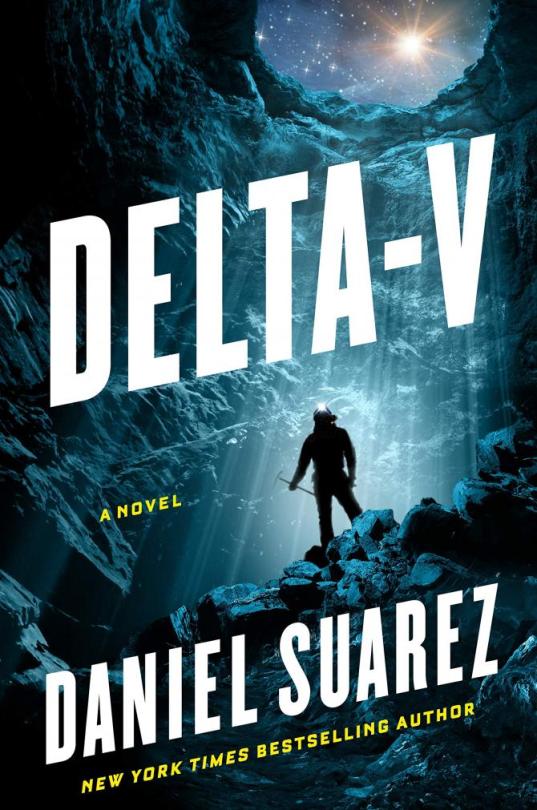
Delta-V by Daniel Suarez
Type: Novel Publisher: Dutton Release date: 4/23/19
The bestselling author of Daemon returns with a near-future technological thriller, in which a charismatic billionaire recruits a team of adventurers to launch the first deep space mining operation--a mission that could alter the trajectory of human civilization. When itinerant cave diver James Tighe receives an invitation to billionaire Nathan Joyce's private island, he thinks it must be a mistake. But Tighe's unique skill set makes him a prime candidate for Joyce's high-risk venture to mine a near-earth asteroid--with the goal of kick-starting an entire off-world economy. The potential rewards and personal risks are staggering, but the competition is fierce and the stakes couldn't be higher. Isolated and pushed beyond their breaking points, Tighe and his fellow twenty-first century adventurers--ex-soldiers, former astronauts, BASE jumpers, and mountain climbers--must rely on each other to survive not only the dangers of a multi-year expedition but the harsh realities of business in space. They're determined to transform humanity from an Earth-bound species to a space-faring one--or die trying.
Read Delta-V by Daniel Suarez
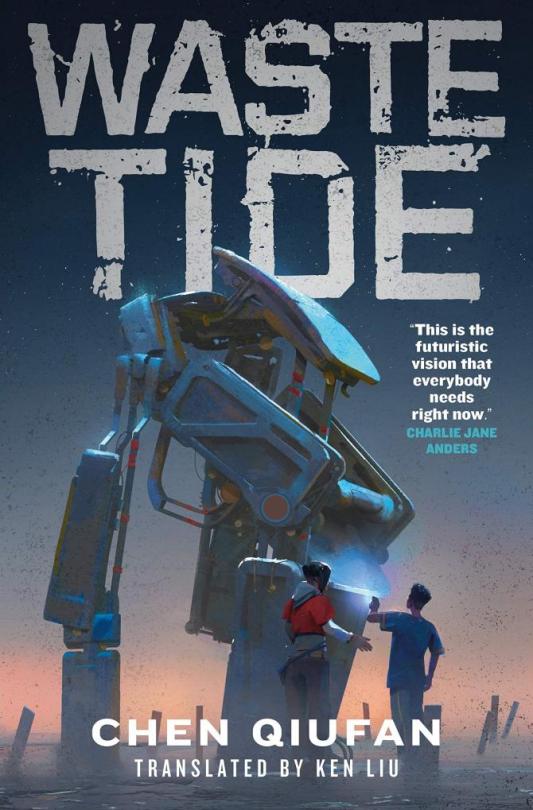
Waste Tide by Chen Quifan, translated by Ken Liu
Type: Novel Publisher: Tor Books Release date: 4/30/19
Award-winning author Chen Qiufan's Waste Tide is a thought-provoking vision of the future.
Translated by Ken Liu, who brought Cixin Liu's Hugo Award-winning The Three Body Problem to English-speaking readers.
Mimi is drowning in the world's trash.
She’s a waste worker on Silicon Isle, where electronics -- from cell phones and laptops to bots and bionic limbs ― are sent to be recycled. These amass in towering heaps, polluting every spare inch of land. On this island off the coast of China, the fruits of capitalism and consumer culture come to a toxic end.
Mimi and thousands of migrant waste workers like her are lured to Silicon Isle with the promise of steady work and a better life. They're the lifeblood of the island’s economy, but are at the mercy of those in power.
A storm is brewing, between ruthless local gangs, warring for control. Ecoterrorists, set on toppling the status quo. American investors, hungry for profit. And a Chinese-American interpreter, searching for his roots.
As these forces collide, a war erupts -- between the rich and the poor; between tradition and modern ambition; between humanity’s past and its future.
Mimi, and others like her, must decide if they will remain pawns in this war or change the rules of the game altogether.
Read Waste Tide by Chen Quifan, translated by Ken Liu
Best New Science Fiction Books in March 2019

Radicalized by Cory Doctorow
Type: Novella anthology Publisher: Tor Books Release date: 3/19/19
From New York Times bestselling author Cory Doctorow, Radicalized is four urgent SF novellas of America's present and future within one book
Told through one of the most on-pulse genre voices of our generation, Radicalized is a timely collection consisting of four SF novellas connected by social, technological, and economic visions of today and what America could be in the near, near future.
Unauthorized Bread is a tale of immigration, the toxicity of economic and technological stratification, and the young and downtrodden fighting against all odds to survive and prosper.
In Model Minority, a Superman-like figure attempts to rectifiy the corruption of the police forces he long erroneously thought protected the defenseless...only to find his efforts adversely affecting their victims.
Radicalized is a story of a darkweb-enforced violent uprising against insurance companies told from the perspective of a man desperate to secure funding for an experimental drug that could cure his wife's terminal cancer.
The fourth story, Masque of the Red Death, harkens back to Doctorow's Walkaway, taking on issues of survivalism versus community.
Read Radicalized by Cory Doctorow
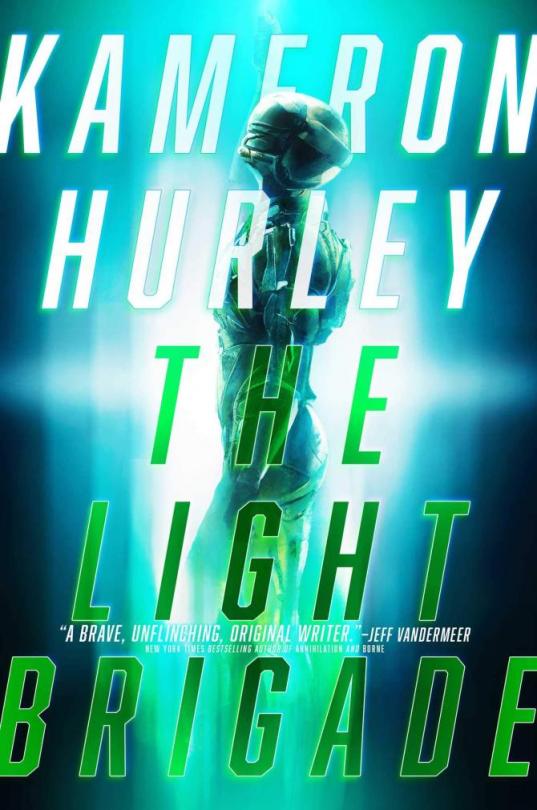
The Light Brigade by Kameron Hurley
Type: Novel Publisher: Gallery/Saga Press Release date: 3/19/19
The Light Brigade: it’s what soldiers fighting the war against Mars call the ones who come back…different. Grunts in the corporate corps get busted down into light to travel to and from interplanetary battlefronts. Everyone is changed by what the corps must do in order to break them down into light. Those who survive learn to stick to the mission brief—no matter what actually happens during combat.
Dietz, a fresh recruit in the infantry, begins to experience combat drops that don’t sync up with the platoon’s. And Dietz’s bad drops tell a story of the war that’s not at all what the corporate brass want the soldiers to think is going on.
Is Dietz really experiencing the war differently, or is it combat madness? Trying to untangle memory from mission brief and survive with sanity intact, Dietz is ready to become a hero—or maybe a villain; in war it’s hard to tell the difference.
A worthy successor to classic stories like Downbelow Station, Starship Troopers, and The Forever War, The Light Brigade is award-winning author Kameron Hurley’s gritty time-bending take on the future of war.
Read The Light Brigade by Kameron Hurley

Luna: New Moon Rising by Ian McDonald
Type: Third book in Luna series Publisher: Tor Books Release date: 3/19/19
The continuing saga of the Five Dragons, Ian McDonald's fast-paced, intricately plotted space opera pitched as Game of Thrones meets The Expanse
A hundred years in the future, a war wages between the Five Dragons—five families that control the Moon’s leading industrial companies. Each clan does everything in their power to claw their way to the top of the food chain—marriages of convenience, corporate espionage, kidnapping, and mass assassinations.
Through ingenious political manipulation and sheer force of will, Lucas Cortas rises from the ashes of corporate defeat and seizes control of the Moon. The only person who can stop him is a brilliant lunar lawyer, his sister, Ariel.
Witness the Dragons' final battle for absolute sovereignty in Ian McDonald's heart-stopping finale to the Luna trilogy.
Read Luna: New Moon Rising by Ian McDonald
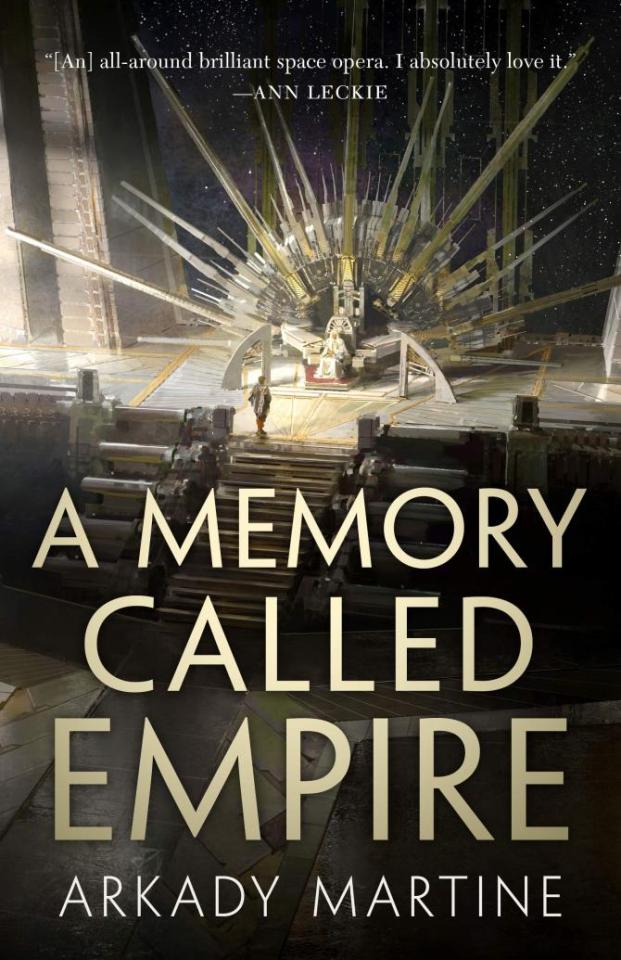
A Memory Called Empire by Arkady Martine
Type: First in a series Publisher: Tor Books Release date: 3/26/19
Ambassador Mahit Dzmare arrives in the center of the multi-system Teixcalaanli Empire only to discover that her predecessor, the previous ambassador from their small but fiercely independent mining Station, has died. But no one will admit that his death wasn't an accident—or that Mahit might be next to die, during a time of political instability in the highest echelons of the imperial court.
Now, Mahit must discover who is behind the murder, rescue herself, and save her Station from Teixcalaan's unceasing expansion—all while navigating an alien culture that is all too seductive, engaging in intrigues of her own, and hiding a deadly technological secret—one that might spell the end of her Station and her way of life—or rescue it from annihilation.
A fascinating space opera debut novel, Arkady Martine's A Memory Called Empire is an interstellar mystery adventure.
Read A Memory Called Empire by Arkady Martine
Read our review of A Memory Called Empire
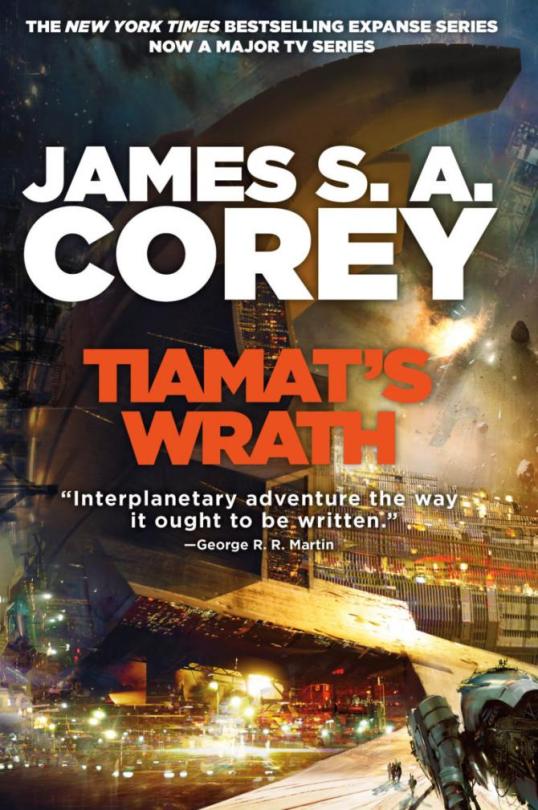
Tiamat's Wrath by James S.A. Corey
Type: Eighth book in The Expanse series Publisher: Orbit Release date: 3/26/19
The eighth book in the NYT bestselling Expanse series, Tiamat’s Wrath finds the crew of the Rocinante fighting an underground war against a nearly invulnerable authoritarian empire, with James Holden a prisoner of the enemy. Now a Prime Original series.
Thirteen hundred gates have opened to solar systems around the galaxy. But as humanity builds its interstellar empire in the alien ruins, the mysteries and threats grow deeper.
In the dead systems where gates lead to stranger things than alien planets, Elvi Okoye begins a desperate search to discover the nature of a genocide that happened before the first human beings existed, and to find weapons to fight a war against forces at the edge of the imaginable. But the price of that knowledge may be higher than she can pay.
At the heart of the empire, Teresa Duarte prepares to take on the burden of her father’s godlike ambition. The sociopathic scientist Paolo Cortázar and the Mephistophelian prisoner James Holden are only two of the dangers in a palace thick with intrigue, but Teresa has a mind of her own and secrets even her father the emperor doesn’t guess.
And throughout the wide human empire, the scattered crew of the Rocinante fights a brave rear-guard action against Duarte’s authoritarian regime. Memory of the old order falls away, and a future under Laconia’s eternal rule — and with it, a battle that humanity can only lose — seems more and more certain. Because against the terrors that lie between worlds, courage and ambition will not be enough…
Read Tiamat's Wrath by James S.A. Corey
Read our full review of Tiamat's Wrath here.
Best New Science Fiction Books in February 2019

The City in the Middle of the Night by Charlie Jane Anders
Type: Standalone novel Publisher: Tor Books Release date: 2/12/19
Um, please drop what you are doing and go read this novel from io9 co-founder Charlie Jane Anders. The second speculative fiction novel for the author, following 2016's wonderful All the Birds in the Sky, The City in the Middle of the Night is set on a tidally-locked planet (one side always faces the sun, the other... doesn't) where humanity has settled, living mostly in cities on the light side of the planet.
The novel follows two point-of-view characters: Sophie, a working class student living in the strict city of Xiosphant, and Mouth, a smuggler whose native nomadic culture has been completely wiped out. When Sophie is exiled from Xiosphant and left to die in the cold, darkness outside of the city, she is saved by the psychic, crocodile-like creatures native to the planet and viewed by the human population as dangerous beasts.
There's so much more to this tale of survival and revolution, and the messy, interpersonal relationships that complicate both. It's sure to be one of the best books of the year.
Read The City in the Middle of the Night by Charlie Jane Anders
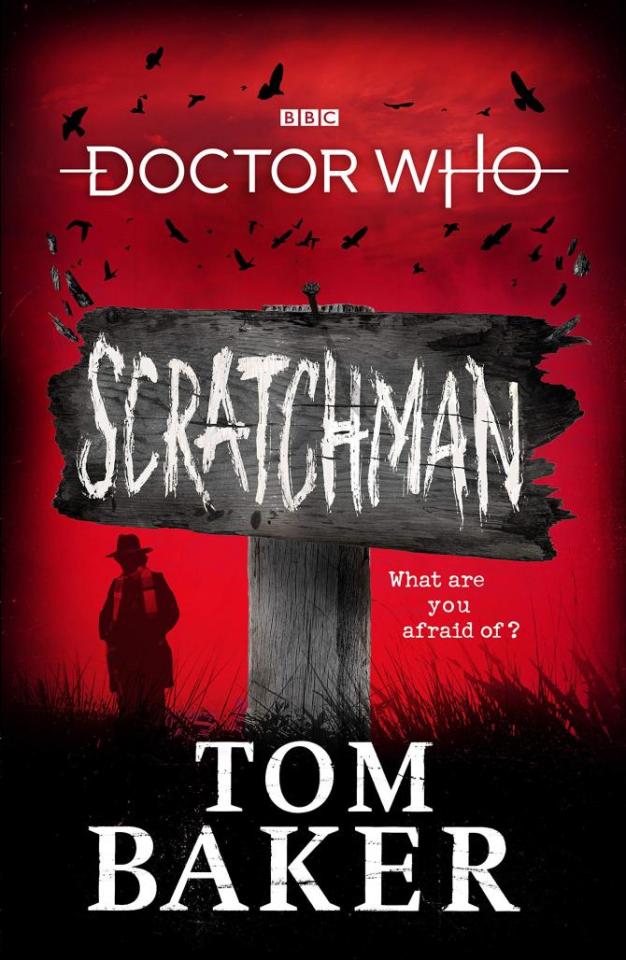
Doctor Who Meets Scratchman by Tom Baker
Type: Set in Doctor Who universe Publisher: Penguin Group UK Release date: 2/12/19
One of the best things about the Doctor Who universe is that it is endlessly expansive. It's been decades since Tom Baker played the iconic role, as the Fourth Doctor. Now, he's back in more ways than one, with Baker having penned a novel featuring his Doctor.
Originally imagined as a Doctor Who feature film in the 1970s, Baker's idea (which he co-wrote with James Goss) has been turned into a novel. The book follows the Doctor, as well as Companions Harry and Sarah Jane, as they arrive on a remote Scottish island. They're looking for a vacation, but what they find is much creepier: an isolated village under attack by scarecrows, a trap set for the Doctor by a devil known as the Scratchman.
Grab some jelly babies and sit down for another Who adventure!
Read Doctor Who Meets Scratchman by Tom Baker

Broken Stars: Contemporary Chinese Science Fiction in Translation
Type: Anthology Publisher: Tor Books Release date: 2/19/19
Explore the world of contemporary Chinese science fiction with this anthology from Ken Liu, the English language translator of Cixin Liu's Three-Body Problem, as well as author of books like The Paper Menagerie. The collection brings together 16 stories written by Chinese authors such as Xia Jia, Han Song, Baoshu, Hao Jingfang, Chen Quifan. The anthology gets some greater context with a collection of three essays about the current state of Chinese science fiction.
Read Broken Stars Edited by Ken Liu
Best New Science Fiction Books in January 2019
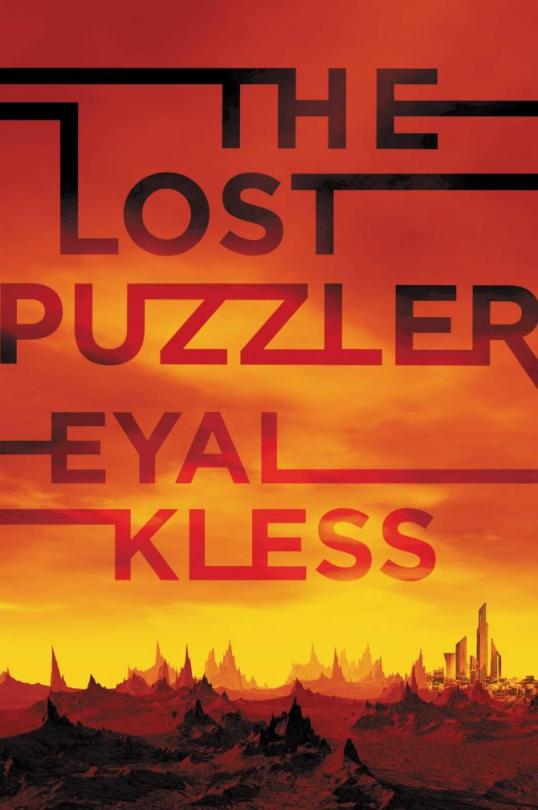
The Lost Puzzler by Eyal Kless
Type: Book one in a series Publisher: Harper Voyager Release date: 1/8/19
Set in a post-apocalyptic world, 100 years after a devastating event known as "The Catastrophe," The Lost Puzzler sees a lowly scribe from the Guild of Historians searching the puzzle-filled, post-apocalyptic world for a missing Puzzler who may be the key to restoring the fallen empire. This book was written by an internationally-acclaimed classical violinist, so that's pretty neat.
Read The Lost Puzzler by Eyal Kless
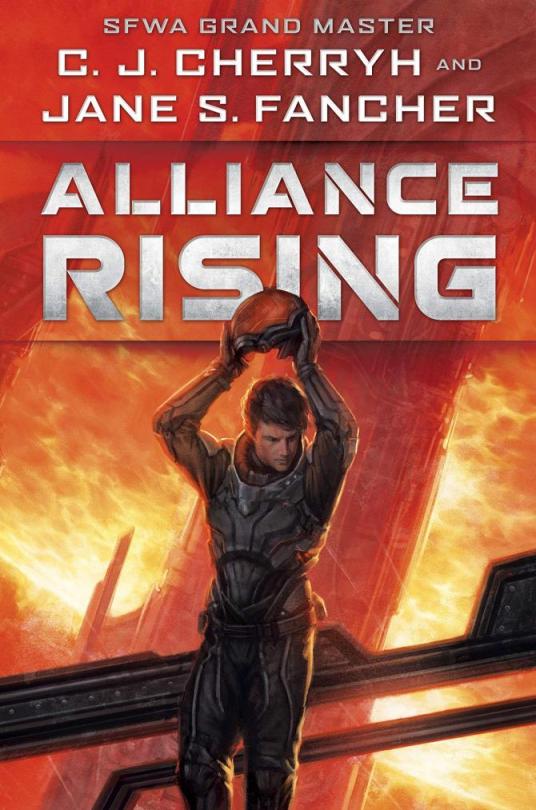
Alliance Rising by C.J. Cherryh & Jane S. Francher
Type: Set in Alliance-Union Universe Publisher: DAW Release date: 1/8/19
Political intrigue! Backwater space stations! Meet the latest installment in the Hugo-winning Company Wars series, the first new story set in the Alliance-Union universe in a very long time. Alliance Rising is set before the Company Wars, when the Merchanter Alliance is still forming, giving us a new perspective on this acclaimed fictional universe.
Read Alliance Rising by C.J. Cherryh and Jane S. Francher
What new speculative fiction books are on your radar? Let us know in the comments below or over at the Den of Geek Book Club!
Kayti Burt is a staff editor covering books, TV, movies, and fan culture at Den of Geek. Read more of her work here or follow her on Twitter @kaytiburt.
facebook
twitter
tumblr

The Lists Kayti Burt
Sep 11, 2019
Science Fiction Books
from Books https://ift.tt/2O2Ogxz
1 note
·
View note
Text
List of Crossplay games 2020
Forza Horizon cross play games
You have a PC, a friend a PS4 and your colleague an Xbox One. Playing online together is apparently not possible, everyone stays for himself. No! Some games support crossplay or cross-platform play. The online service and the connected infrastructure of the respective game does not matter on which platform you start a game. Everyone can come together in the online lobby and play a game together.
You can find out which games support crossplay and which platforms this applies to in our lists below.
Note: We avoid double lists. If a game offers crossplay for the four platforms W, X, Y and Z, we no longer count it in the separate list for the three platforms X, Y and Z. Of course, this also applies to other constellations. For this purpose, mobile titles are ignored, as is crossplay support between different PC launchers (e.g. Steam, Microsoft Store and Epic Games) and any support for crossplay with game streaming services.
Crossplay games: PC, PS4, Xbox One and Nintendo Switch
Games that work equally on all four current gaming platforms and can be connected to one another online are rare. In February 2019 there were three. The number of titles has increased significantly in the meantime and is now in double digits.
Apex Legends (from autumn)
Brawlhalla
Dauntless
Dead by Daylight (since mid-August)
Fortnite
Minecraft: Bedrock Edition
Paladins
Phantasy Star Online 2
Power Rangers: Battle for the Grid
Realm Royale
Rocket League (also gets cross-platform progress via Epic Games account in summer)
Rogue Company (Early Access)
Smite
Super Mega Baseball 2
Wargroove
PC, PS4 and Xbox One
Games that only offer crossplay on PC, PS4 and Xbox One are clearly in the minority compared to titles that also support the Switch in addition to the three platforms (see above).
Call of Duty: Black Ops Cold War (November 13th)
Call of Duty: Modern Warfare (2019)
Call of Duty Warzone
Need for speed heat
No Man’s Sky (Patch 2.52)
Rocket Arena
Spacelords
War Thunder – (after Starfighters update)
World War Z (after Dronemaster update from mid-July 2020)
Crossplay games: PC and PS5 and Xbox Series X Destiny 2 should also be mentioned, which will only connect to PS5 / PS4 and Xbox Series X / One Cross-Generation-Platform-Play at the end of 2020 and all consoles including PC in 2021.
Crossplay games: PC and PS4
The “PC and PS4” list, like the “PC and Xbox One” list, is much more extensive.
99Vidas
Atom Universe
Boundless
Brawlhalla
Chess Ultra
DC Universe Online
Dick Wilde 2
Disc jam
Dragon Quest X
Dragon’s Dogma Online
Eagle Flight
Fall Guys: Ultimate Knockout
Eve: Valkyre
Final Fantasy XIV: A Realm Reborn
Games of Glory
genesis
Genshin Impact (from September 28th)
Guns of Icarus: Alliance
Gwent: The Witcher Card Game
Hero victories
Hex
Helldivers
Hover
Invokers Tournament
Kabounce
Mantis Burn Racing
Overload
Pinball FX 3
Pox Nora
Ready Set Heroes
Rec Room
Siegecraft Commander
Space junkies
Sparc
Sports Bar VR
Star Trek: Bridge Crew
Street Fighter 5
Square Heroes
Super Dungeon Bros
Trailblazers
Tooth and Tail
Ultimate Chicken Pants
Weapons of Mythology: New Age
Werewolves Within
Crossplay games: PC and PS4 / PS5
Worms Rumble ( also PS5 )
PS4 and Xbox One
With PlayerUnknown’s Battlegrounds, there was actually only one title that allows crossplay only for PS4 and Xbox One. World of Warships: Legends was added at the end of 2019. More followed in 2020.
Black Desert
Hunt: Showdown (Patch 1.3)
PUBG
Warface: Breakout ( from Season 2 )
World of Tanks (with Update 5.0)
World of Warships: Legends
PS5 and Xbox Series X
” Overcooked! All You Can Eat ” has a special place here . This is a bundle of remasters of the previous two parts including DLC. Only the upcoming consoles are named as platforms.
Destiny 2 should also be mentioned, which will only connect to PS5 / PS4 and Xbox Series X / One Cross-Generation-Platform-Play at the end of 2020 and all consoles including PC in 2021.
Crossplay games: PS4 and Switch
On August 27th, Final Fantasy Crystal Chronicles Remastered will be the first crossplay game that only combines PS4 and Switch (in addition to Android and iOS).
PC, Xbox One and Switch
The titles in this list also belong in the following (PC and Xbox One). Switch owners can look forward to the games now listed.
Aragami
Chess Ultra
Crazy Justice
Hover
Killer Queen Black
Mantis Burn Racing
Minecraft: Bedrock Edition
NBA 2k Playgrounds
Neverwinter Nights (Enhanced Edition)
Next up hero
Paladins
Pinball FX 3
Siegecraft Commander
Trailblazers
Treasure Stack
Warborn
PC and Xbox One
Crossplay between PC and Xbox One overlaps in places with Play Anywhere games , in which you can load unlocked games on the Xbox account on the same account under Windows. Corresponding crossplay games include Forza Horizon 3 and 4, Forza Motorsport 7, Gears of War 4, Halo Wars 2 and more. These are all games:
Fortnite
Ark: Survival Evolved
Astroneer
Crackdown 3
Deep Rock Galactic (since August 24th for Insiders)
Fable Fortune
Final Fantasy XV
Forza Horizon 3
Forza Horizon 4
Forza Motorsport 7
Full Metal Furies
Gears of War 4
Gears 5
Gwent: The Witcher Card Game
Halo: The Master Chief Collection ( still 2020 )
Halo Wars 2
Killer instinct
Microsoft Flight Simulator (2020)
Overload
Phantom Dust
Riptide GP Renegade
Roblox
Rocket Arena
Sea of Thieves
Sniper Elite V2 Remastered
State of Decay 2
Zoo Tycoon: Ultimate Animal Collection
Crossplay: update history
On March 17th, 2020 we added Call of Duty Warzone (PC, PS4, Xbox One) and Black Desert (PS4, Xbox One) as single titles.
On March 25th, 2020 we added World War Z (PC and Xbox One). The developers have released a suitable patch that teaches the zombie shooter cross-platform play. Support for the PS4 should come later.
On June 17th, 2020 we added more titles or moved them to the list because, for example, a patch enables more crossplay platforms: Warborn, Dead by Daylight, No Man’s Sky, Final Fantasy Crysal Chronicles Remastered, Hunt Showdown, War Thunder and Need for speed heat.
On June 19th we added Apex Legends. A switch version will be available from autumn and the start of crossplay support at the same time.
On July 29th there were updates with and for Dead by Daylight, World War Z, World of Tanks, Warface: Breakout, Rogue Company, Worms Rumble, Rocket Arena and Overcooked! All you can eat. We have also intercepted the first crossplay announcements for the next-gen consoles – but due to the early date, the focus is still on the current generation.
On August 31st we recorded (Updates): Call of Duty: Black Ops Cold War, Dead by Daylight, Destiny 2, Rocket League, Halo: The Master Chief Collection, Wargroove, Genshin Impact and Deep Rock Galactic.
The post List of Crossplay games 2020 appeared first on Technoeager.
from WordPress https://ift.tt/3jsjmLa via IFTTT
0 notes
Text
[SF] Allied Assistance
Logline: A researcher finds a way to send modern technology to the Allied powers during the Second World War, effectively securing victory and saving lives, but also has repercussions beyond the war.
_______________________
Jason Reese, a research scientist working for the U.S. Army, is on the brink of a breakthrough. Jason has degrees from Harvard, Yale, and Brown, in the field of quantum physics. He works with a research and development team from a clandestine lab deep in the Nevada desert. Irene Tang, a Japanese graduate student from MIT, holds degrees in organic chemistry and quantum mechanics. There is also Aaron Massey, a budget guy who maintains expenditures under the supervision of the Army and serves as a contact with other branches of the military. Aaron has a Bachelor's degree from Arizona State. After serving in the Army, he was the number one insurance agent in Arizona for three straight years.
Jason's breakthrough, hopefully, would enable him to send things through time using a wormhole. The device is the size of the breadbasket. He delivered a letter via the wormhole last night. There was a message in return this morning, his great-grandfather, Wayne Reese, a Command Sergeant in the U.S. Army, responded, while serving in World War II. He had just lost several soldiers the night before, and he was concerned that they weren't going to make it out alive.
"Wow, that's incredible," Irene says, looking over Jason's shoulder.
"We could give some details to support them, we know how the war is going to end, we know what the German strategy was, giving him a few tips is only going to save lives," Aaron says, realizing the value of this technology.
"I don't know; we shouldn't play with the past, who knows what sort of effect it would have on us today. Besides, who knows what harm we've already caused," Jason says.
"Although we're all here. If there were any changes, they were so slight that we couldn't perceive them. What if you're dealing with a parallel universe, one that doesn't have any effect on the one we're living right now?" Irene speculates.
"She's right; if this device succeeds, it will transform the universe, you will go down in history as the greatest scientist in human history," Aaron says.
"How about a little test, your great-grandfather included the date, the 9th of March, 1942, we could very quickly lookup where his brigade was and give him some advice. If there's no difference in our universe, we'll know it's a parallel universe," agrees Irene.
Jason decides to go with Irene's idea; he researched the brigade of his great-grandfather and discovered that they were battling in France on that day. Sadly, he also found out that his great-grandfather was about to be killed in a machine-gun ambush in Calais. With full hindsight, Jason can guarantee that if his great-grandfather moves his brigade south of the area, they would be able to surprise the German forces.
Jason prepares the letter carefully, submits it through the wormhole, and it works! His great-grandfather took the south route, shocking the Germans, and won a vital battle. Jason felt proud; he had done something that wasn't in the history books before today.
"Look, we're linked to the U.S. Army, we can get them some top-of-the-line 2020 weapons, sit back and watch your grand-grandfather become a goddamn hero," Aaron entices. Jason says,
"Let's see what this wormhole can do ."
Aaron brings General Andrew Scarlett to the facility the following day. The general is very knowledgeable regarding the Second World War and is also in charge of the very substantial arsenal of 2020 weapons. The general asked Jason if he'd be able to construct a bigger wormhole, Jason said he'd be able to make one around the size of the garage door.
The general returns with all kinds of high-tech weapons that can fit inside a garage, Jason includes a letter for his great-grandfather, which consists of a few instructions about how to handle such modern advanced weapons.
The next week, Jason received a letter back, the latest guns performed beautifully, they moved Germany closer to its original border, something that took four years to do in the original timeline was achieved in a matter of five months using 2020 technologies.
But Aaron and the general were greedy; they wanted Jason to create an even larger wormhole, one in which they could bring tanks, warships, jetplanes, and much more comprehensive high-tech weapons.
"Don't forget, we still have to defeat Japan, imagine if we can achieve that without the A-bomb," the general says excitedly. Jason agrees and will construct a wormhole the size of a building in the middle of the desert. The general instantly submits a requisition for larger equipment.
Jason got another letter from his great-grandfather, they defeated Hitler in June 1942, and Japan is set to surrender by the end of the summer. Their strategy succeeded, the advanced technologies and the 80 years of development involved, gave the Allied forces a significant advantage over the Nazis of the 1940s.
Jason gets up the next morning, but he's not in his bed. Confused, he looks out the window, he's in London. He heads out and suddenly meets Irene and Aaron. London looks odd, there are American flags everywhere, Jason looks in the center of Trafalgar Square, and there's a massive statue of his great-grandfather, Emperor Wayne Reese? Jason, Irene, and Aaron are shocked by all the American patriotism. General Scarlet steps up behind them and pushes them into a building.
"We did it, America controls the world," says the general.
"What do you mean, why are we in Britain?" Jason questions.
"It's not Great Britain; it's America, it's all America, London is just the capital of the American colonies in Europe. After defeating the Japanese, we continued to colonize almost 90% of the world," explains the general.
"It's impossible, according to the letters with my great-grandfather, they were only in August, 1942," Jason tries to rationalize.
"What did you suppose would happen when the U.S. Army got hold of the 2020 weapons, they made more of them! They deployed satellites; they built the Internet, they established advanced surveillance technologies, years before it was invented in our timeline, what did you think, he was going to write you about all of it?" the general asks.
"How did this happen, we confirmed that it was a parallel universe; it wasn't our timeline!" Jason told Irene.
"Do we even know how parallel universes work? Maybe there was a way for timelines to merge, it's all theoretical," Irene speculates.
"Hey guys, listen to me, it's all going to be all right, this is the best of all worlds, all these nations are paying America to defend them, the planet is at peace, sit back and appreciate it," Aaron says as he marches away with the general.
When Jason walks through London, he finds that conditions are better, the buildings are cleaner, hardly any homeless, people seem happy under American rule. It wasn't until they entered a cafe to get breakfast that he realized, everything wasn't the same for everyone.
The barista at the counter takes one look at Irene, "We don't serve her kind here, the japs have their restaurants on the south side of the city, I'm sorry, that's the rules," says the barista.
Jason and Irene leave the coffee shop and conduct some analysis to see exactly how much of their timeline had changed; most people were living on a par with what was expected from the original timeline. However, life is harsh for citizens who fought American occupation or citizens from Axis nations. They exist under an authoritarian rule, do not have all the rights and liberties of the Allied countries, and do not exercise the same economic freedoms. A powerful military crushes uprisings with zero tolerance for acts of disobedience.
Jason and Irene are eager to undo what they have done; they travel back to the Nevada facility, which has been locked up and abandoned. The equipment is gone and such materials have been outlawed in America. Above all, Aaron and the general were aware of what was going on due to internet monitoring. Soldiers were dispatched to arrest Jason and Irene onsite.
Locked up for six months, they were sent to Germany upon release, and their American visas were stripped away. A dark and seedy place, rife with corruption, and military on every corner. Stuck in Germany, they become friends with several dissidents who want to see America crumble. Mistreatment gives Jason and Irene a new perspective on things; they become jaded.
"They have to be stopped!" Jason says, addressing a group of revolutionaries. Jason was obsessed with wormhole technology, and after his facility in Nevada was ruined, he remained determined to re-create the project. Living on the Axis side of the border rendered it difficult for him to access the necessary materials.
However, Jason holds a wormhole party, a maneuver once attempted by Stephen Hawking. If anyone in the future develops wormhole technology and wishes to escape the control of the U.S. government, come back to the 1st of January, 2021. He doesn't tell anyone or send out any invites until after the party has already taken place.
The 1st of January arrives, and it's mostly uneventful, but, at 10 p.m., a wormhole opens, and an army marches out. Jason's wormhole technology was already responsible for ending a World War; it's now going to be responsible for beginning one.
Jason's journey took him from a reluctant scientist who helped the Allied powers in World War II to harden revolutionary, with an army at his disposal, obsessed with destroying the world he helped to create. There are winners and losers in war; perspective is everything. The winners write the history books; the losers have to suffer the repercussions. Sometimes in the universe, things are meant to happen the way they happen, there's no improving on it. Jason rescued his great-grandfather from certain death, but through man's unpredictability, his great-grandfather went on to take over the world, the very thing he was trying to stop in the first place.
submitted by /u/patrickryan182 [link] [comments] via Blogger https://ift.tt/2X3eODm
0 notes
Text
Morning Mist #77
Announcements, Releases, Trailers
Overwatch 1 and 2 will eventually merge into a single client, Jeff Kaplan says
1001st Hyper Tower is out now, bloody good
Star Citizen shows off a new mission involving a hijacked 890 Jump spaceship
Kerbal Space Program 2 is grounded until after April 2020
Skybolt Zack is a rhythm-platformer that requires a mastery I can't give it
Bard McQuaid’s Pantheon gives a glimpse of its beautiful new world in its new trailer
Meteorfall: Krumit's Tale is tile-based roguelike deckbuilding, out now on early access
Looking for a new couch co-op game? Keep your eye on The Stretchers
Disney Tsum Tsum Festival Released
Milestones, Industry
PlayStation has no interest in following Xbox Game Pass' approach to first-party games
FFXIV Shadowbringers boosted Square Enix’s financials, Nexon sees 24% YOY revenue drop
WoW Classic and Call of Duty have led a better-than-expected quarter for Activision Blizzard
GTA 5 has sold five million copies since May, for a lifetime total of 115 million
New RPG from Threes creator sees Apple Arcade subscription hit 100 games milestone
Pokémon Sword and Shield launch event in Japan cancelled for "operational reasons"
Deals, Freeware
Weary from his travels, the kid looked at his iOS device, and saw that Bastion was free until the end of the year
Summon the old gods with this free eldritch clicking game
Nuclear Throne and Ruiner Free on Epic Games Store, The Messenger Next Week
American Truck Simulator is free to play this weekend
Explore The Elder Scrolls Online for free 'til next Wednesday
Payday 2 is free to play this weekend
These Nintendo Switch exclusives are now at their lowest ever prices
Buyer Beware: Nintendo Switch Black Friday Deal has a Nasty Surprise
Steam Armistice Sale Benefits War Child Armistice 2019
GameStop Pro Day Sale Is Live, Offers Huge Savings on Games, Consoles, and More
Corsair's updated HS60 Pro headset is just $40 from Best Buy
Logitech's G203 Prodigy mouse is just $21 right now
Information
Teamfight Tactics update introduces a new elemental system
World of Warships launches Midway movie tie-in events ahead of Veterans Day
Surviving EverQuest's Hard-as-nails Classic Servers
Ship of Heroes’ final character creator beta event is this morning – save your costumes!
Call of Duty: Modern Warfare has new maps and a new mode
Here's a peek at Rainbow Six Siege's upcoming gadgets
Fire Emblem: Three Houses' new patch is a big one, as you can feed this good dog
Monster Hunter World's Resident Evil 2 and Horizon Zero Dawn events dated and detailed
Dead Cells' 15th free update adds new biome, deadly birds, and more
Beat Saber gets six track Rocket-League-inspired music DLC
EVE Online will officially arrive to Korea on November 14
Etc
Rock band Alice in Chains threw a wicked AdventureQuest 3D concert
Red Dead Redemption 2 trainer lets you play as an eagle, wolf, or any other model in the game
EA FIFA staff personal Twitter accounts hacked as harassment gets even uglier
An ex-antivirus employee stole data for 68,000 customers and sold it to scammers
This Street Fighter II Arcade Machine Is A Knockout Punch
Razer begin “costly venture” to make a left-handed Naga mouse
Seagate is skipping the hard drive's funeral, plans to have 50TB HDDs in 2026
0 notes
Text
Get Your History Book Out: The Allies Bombed Hitler Back Into the Stone Age
Curtis LeMay, who departed Europe to direct the devastation from the air upon Japan, said, “As to worrying about the morality of what we were doing, nuts! I was a soldier, soldiers fight. If we made it through the day without exterminating too many of our own people, we thought we’d had a pretty good day.”Behind the strategy that governed the American air war in Europe during World War II lay events and ideas that dated back to World War I and the 1920s. The first strategic bombing raid in 1915 deployed not airplanes but German Zeppelins, rigid airships that dumped ordnance on the east coast of Great Britain. Two years later Germany’s Gotha bomber, a machine capable of a round trip from Belgian bases, struck at Folkestone, a port through which British soldiers embarked for the front. This raid killed 300 people, including 115 soldiers. The bomber had proven itself as a weapon against a military target.A few weeks later, 14 Gothas attacked London in the first fixed-wing assault upon civilians and their institutions. The dead and wounded totaled 600, and the raid wrought consternation among the public and the government. The British hastily summoned fighter units to gird the cities. To counter the defensive cordon, the Gothas flew night missions. With primitive navigational tools and no bombsights, the raiders drizzled explosives without any pretense of hitting military or industrial targets. Theoreticians of war now had a new factor to enter into equations: the terror of massive strikes upon workers producing the stuff of war.Recommended: This Is How China Would Invade Taiwan (And How to Stop It).Recommended: North Korea’s Most Lethal Weapon Isn’t Nukes. Recommended: 5 Worst Guns Ever Made.Brigadier General Billy Mitchell, who had only earned his wings in 1916, commanded the air force for General John J. Pershing and his American Expeditionary Force in France. Mitchell met Maj. Gen. Hugh M. Trenchard, commander of the Royal Flying Corps, who quickly persuaded the American that the “airplane is an offensive and not a defensive weapon.” Mitchell grasped the possibilities of taking the war behind the lines and plotted a huge raid that would blast German military and industrial targets in the autumn of 1918. A correspondent for the Associated Press wrote, “His navy of the air is to be expanded until no part of Germany is safe from the rain of bombs…. The work of the independent force is bombing munitions works, factories, cities and other important centers behind the German lines…. Eventually Berlin will know what an air raid means, and the whole great project is a direct answer to the German air attacks on helpless and unfortified British, French and Belgian cities.”World War I ended before Mitchell could demonstrate what his “navy of the air” might achieve, but he continued to expound his ideas. While accepting the need for control of the skies through destruction of the enemy air forces, he said, “It may be … the best strategy to damage and destroy property, and to kill and disable an enemy’s forces and resources at points far removed from the field of battle of either armies or navies.” Implicitly, Mitchell accepted war on civilians.In 1921 and 1923, Mitchell demonstrated that bombers could sink some anchored warships. The experiments confirmed that aircraft could destroy substantial stationary targets, but admirals scoffed that vessels under way could easily avoid the attacks. The Army dismissed the show as irrelevant for its vision of warfare, which was to slug it out with hostiles while capturing territory.While Mitchell and Trenchard promulgated their ideas of aerial offensives, a contemporary Italian, General Giulio Douhet, preached that modern war involved the entire society, including “the soldier carrying his rifle, the woman loading shells in a factory, the farmer growing his wheat, the scientists experimenting in the laboratory.” Douhet spoke not only of smashing wartime production but argued, “How could a country go on living and working, oppressed by the nightmare of imminent destruction.” He conceded that such a war without mercy eliminated considerations of morality.Americans partially bought into the Douhet’s theories. They buried the idea of indiscriminate raids that slaughtered nonmilitary people and emphasized hitting industrial production, transportation facilities, and military centers. Promoters of strategic bombing hypothesized that by destroying the goods of war and the will of the people to resist, conflicts could be shortened and the wholesale carnage of the World War I battlefield avoided.Mitchell’s outspoken demands for an independent air force ended his career, but acolytes like Henry “Hap” Arnold, Carl Spaatz, and Ira Eaker retained positions in the military hierarchy. They successfully promulgated the doctrine of strategic bombing, accurate targeting of enemy installations and facilities. Toward that end, in 1933 the War Department approved a prospectus for a plane capable of traveling at speeds in excess of 200 miles per hour and with a range of more than 2,000 miles. The new bomber could be used to defend either coast, but if deployed overseas it would require bases in England or sites like the Philippine Islands. Boeing produced the first model of the Boeing B-17 Flying Fortress, which roared through the sky at 232 mph during a 2,100-mile trip from Seattle to Dayton. The advocates of air power were delighted, but unfortunately the prototype crashed and burned on a test flight. Instead of ordering 65, the War Department scaled back to a mere 13.To carry out daylight precision bombing the Army adopted a tool ordered and then discarded by the Navy as unsuitable for dive-bombers: the Norden bombsight. In the crucial seconds over an objective, a bombardier manipulated the device to guide the plane as he lined up the target and then released the explosives.“I Can Shoot Those Things Down Very Easily.”Douhet also taught his disciples that heavily armed bombers in mass formations could operate by day against fighter defenses. The publicity on Boeing’s creation hailed the new airplane as a “Flying Fortress,” but it was hardly as impregnable as the name indicated. The first B-17s lacked armor plate to protect the crew, carried only five machine guns, and made no provision for a tail gunner. The B-17 faithful believed that was sufficient since, in their minds, the aircraft could attain altitudes beyond reach of interceptors. In the late 1930s, a hot shot fighter pilot, Lieutenant John Alison, confounded the assurance of promoters of the early B-17 when he convincingly demonstrated he could push his fighter close enough to the weaponless rear of a Flying Fortress and shoot it down. His feat, however, did not immediately persuade the bomber command to install a tail gun. Nobody in the Air Corps was going to listen to a pursuit pilot, a second lieutenant who claimed, “I can shoot those things down very easily.”The conviction that strategic bombers could operate unmolested by enemy aircraft influenced the development of U.S. fighters. Escorts to protect the big planes would be unnecessary, and the design for a fighter focused upon a machine that would protect the ground forces. Not until the Battle of Britain in 1940 and the appearance of the Messerschmitt Me-109 did the American experts realize that the speed and altitude of an enemy fighter challenged their assumptions about the invulnerability of the B-17. The standard American fighter, the Curtiss P-40 Tomahawk—a good gun platform, while speedy in a dive—had a limited ceiling and rate of climb. It would not be deployed in the European Theater.Desire for an interceptor with longer range and performance higher in the sky had belatedly resulted in the twin-engine Lockheed P-38 Lightning, and aeronautical engineers returned to their drawing boards to blueprint what would become the Republic P-47 Thunderbolt and the North American P-51 Mustang. At the same time manufacturers modified the big bombers, now including the Consolidated B-24 Liberator, which had slightly more range and bomb weight capacity than the B-17, adding better means to defend themselves: up to 12 .50-caliber machine guns, a tail gunner, and armor for the crew. When the enemy changed tactics during World War II and began head-on attacks, a chin turret would be added to give greater firepower forward.From the start of World War II, the British intended to follow Trenchard’s maxims on carrying the war to the industrial centers and the population of the foe. In May 1940, when the Royal Air Force attempted daylight strategic raids by its fleet of bombers, German ack-ack and interceptors killed more flyers than the enemy lost on the ground. B-17s purchased from the United States carried out a few daylight missions with dismal results and curdled RAF enthusiasm for the Flying Fortress. American analysts noted that the Brits insisted on operating above 30,000 feet, which overloaded the oxygen systems, froze weapons, and reduced airspeed, making the planes vulnerable to the Me-109s. The RAF B-17 missions relied on an inferior bombsight, and the maximum number of aircraft in formation was a mere four. The British, using their own bombers, switched to nighttime assaults, on industrial areas. They made no pretense of discriminating between residential neighborhoods and factories.The British tried to convince the Air Corps that it too should operate after dark. That would have negated the entire basis for the designs of the B-17 and B-24 and wasted the hundreds of hours training of bombardiers with the Norden device. Faith in daylight precision bombing thus remained intact as the United States entered World War II. There was no disagreement with the British on the purposes and potentials of air power. Maj. Gen. Ira Eaker, who headed the American bomber command in 1942, said, “After two months spent in understanding British Bomber Command, it is still believed than the original all-out air plan for the destruction of the German war effort by air action alone was feasible and sound and more economical than any other method available.” He did agree that since the resources then available were limited, a ground effort might be required.The Eighth Air Force opened for business in England in May 1942, but neither B-17s nor B-24s were available. Most of the handful of combat-ready heavyweights had been sent to the Philippines, where Japanese attacks destroyed many of them. As a result, when the Eighth inaugurated its campaign against the Axis powers on July 4, 1942, the mission had little resemblance to strategic bombing. The 15th Bombardment Squadron borrowed 12 A-20 twin-engine Bostons from the RAF, and only half of these were flown by U.S. crews. They struck at four airfields in Holland, flying at an extremely low level before unloading their bombs and strafing the base. They inflicted minor damage, and three were shot down.Not until some six weeks later did the Eighth launch a true daylight strategic bombing mission. On a beautifully sunlit day, a dozen B-17s from the 97th Bomb Group headed for the Rouen (France) railroad yards. Accompanied by RAF Spitfires, they encountered light flak and no serious interference from German fighters. All returned safely, leaving behind them, said Eaker, head of the Eighth Bomber Command who flew in the lead plane, “a great pall of smoke and sand.” General Henry “Hap” Arnold, the Air Corps commander, declared, “The attack on Rouen again verifies the soundness of our policy of the precision bombing of strategic objectives rather than the mass bombing of large, city size areas.”The Rouen raid achieved only nuisance value, and euphoria dissipated rapidly as the strategic bombing campaign intensified. Practice revealed substantial holes in theory. The Luftwaffe, manning high-performance Me-109s and Focke Wulf 190s, greeted marauders with a skill and savagery that tore huge holes in the fabric of the Eighth. Losses of from 10 to 20 percent frequently resulted from the deadly combination of flak and fighters. Air Corps analysts calculated that adequate self-defense required a minimum of 300 bombers, a figure difficult to achieve during the first 18 months of U.S. aerial combat in Europe. Nevertheless, the Americans strove to meet their responsibilities for round-the-clock assaults. The RAF, exclusively bombing at night, including an occasional thousand-plane raid, endured heavy losses of air crews to flak and night fighters. Post-mission photo analysis indicated their destruction of industrial works was far from commensurate with the casualties.By the spring of 1943, the Allied air command realized that there were not sufficient aircraft to hammer day and night the entire war industry of occupied Europe and Germany with precision. The RAF had no accuracy with its night raids, and the scattershot approach of the Eighth Bomber Command did not cripple production. Eaker, as commander of the Eighth’s Bomber Command, proposed a “Combined Bomber Offensive,” suggesting “it was better to cause a high degree of destruction in a few really essential industries than a small degree of destruction in many industries.”Toward this end, the U.S bomber command mounted an attack on Romania’s Ploesti oil fields and refineries using B-24s flying from fields in North Africa. To avoid detection and increase accuracy, the participants in Operation Tidal Wave flew at low level. The raiders inflicted modest harm. Ploesti had been functioning well below capacity, and it was a simple matter for production to recoup. The Tidal Wave bombers suffered horrendous losses: more than 300 killed, hundreds wounded or captured, 79 interned in Turkey. Just 33 of the 178 Liberators involved could be listed as fit for duty after the mission. No one could seriously propose any further low-level daylight attacks for the heavyweights.Because of the Luftwaffe’s success and with an eye to controlling the air when the time arrived for an invasion of Europe, in June 1943 the Allied high command created Operation Pointblank, announcing, “It has become essential to check the growth and to reduce the strength of the day and night fighter forces which the enemy can concentrate against us … first priority in the operation of British and American bombers … shall be accorded to the attack on German fighter forces and the industry upon which they depend.” German airbases and factories producing planes and essentials like ball bearings drew priority.General LeMay Calculated That Flak Gunners Needed to Fire 372 Rounds to Guarantee a Hit on a B-17The enemy met Pointblank with ferocity. In August 1943 a maximum effort that put up 300 bombers to strike Schweinfurt and Regensburg cost the Americans 60 planes—600 crewmen—shot down with many additional aircraft badly damaged. A basic problem lay in vulnerability to interceptors. Spitfires, with a range limited to 100 miles beyond the British coast, could not provide protection on longer missions. Bereft of escorts, the 10 or 12 .50-caliber machine guns of the B-17s and B-24s were not enough to fend off the swarms of Me-109s and FW-190s. Another weakness centered on use of the Norden bombsight, which required a clear view of the target and a steady hand. In the cloudless, peaceful skies over Texas, it might have been possible for a skilled operator in the boast of the times to put a bomb in a pickle barrel. But frequently over Europe heavy rain or snow, thick overcasts, and buffeting winds obscured or misled bombardiers. Even when the target was clearly visible, torrents of antiaircraft shells intimidated the men at the toggle switches and those in the cockpits. Bombs fell away prematurely, or the plane suddenly veered off because the pilot seized the controls and yanked the ship out of imminent danger.General Curtis LeMay, commander of the 305th Bomb Group, after analyzing the photo reconnaissance intelligence, decided a prime culprit for poor accuracy was failure to maintain a steady course. He decreed that none of his pilots could take evasive action over a target. He had calculated that flak gunners needed to fire 372 rounds to guarantee a hit on a B-17 in level flight. Whether his arithmetic was correct or not, LeMay sought to persuade his subordinates by announcing he would fly the lead aircraft on missions. In fact, the first ship over a target had a better chance for survival because antiaircraft personnel adjusted for range and speed as a flight passed. Disciplined behavior, however, added effectiveness, although no one could compensate for weather that obscured a target.LeMay also innovated a better defense for the big bombers. He insisted upon a tight, stepped-box formation that enabled gunners to provide mutual assistance. A bomb group could bring to bear from 200 to 600 machine guns on an attacker. His demands for more training by navigators and bombardiers and closed-in formations earned him his nickname of “Iron Ass,” but the 305th proved his point with more effective results and fewer losses.In contrast to LeMay’s carefully worked out stepped-box formations, inexperienced Brig. Gen. Nathan Bedford Forrest, newly installed as an air division commander, ordered the 95th Bomb Group to use a flattened formation, with aircraft wingtip to wingtip. Over Kiel, the Luftwaffe feasted upon the 95th, shooting down eight, including the bomber carrying Forrest. The disaster proved the efficacy of LeMay’s design.Pointblank failed to halt aircraft manufacture because the enemy had decentralized its critical industries. In particular, the Third Reich had arranged to import vital ball bearings from neutral Sweden. To inflict lasting damage required repeated raids on factories, and in 1943 the Air Corps lacked enough planes and crews. It was also during Pointblank that the initial desire to minimize civilian casualties by concentrating on military installations, manufacturing plants, and transportation hubs began to give way. Bomber command directed the crews on a mission against the rail junction at Munster to unload on the city center, hitting the town’s workers. According to one historian, the attack upon civilians “did not produce any moral qualms among the airmen; some cheered … their own sufferings had bred bitterness.”Throughout the last months of 1943, the U.S. bomber campaign staggered from the continued onslaughts of German fighters and the increasingly effective flak aided by improved German radar systems. Losses continued to soar above a prohibitive 10 percent. P-38 Lightnings and P-47 Thunderbolts with American pilots had replaced the Spitfires, but without drop tanks they could only venture as far as the Rhine River, leaving the big fellows exposed to the depredations of interceptors. At the beginning of 1944, newly arrived P-51 Mustangs equipped with Rolls Royce engines debuted and quickly won recognition as the best fighter in the theater.The tide turned with Big Week, starting February 20, 1944. The occasion introduced new features to the American effort. Lt. Gen. Jimmy Doolittle had replaced Eaker at the helm of the Eighth Air Force. Doolittle modified his predecessor’s policy that no fighters, the Little Friends, could ever leave the bombers to chase the enemy. Doolittle ordered the P-38s, P- 47s, and P-51s to attack the Luftwaffe on sight, provided they left some guardians to screen the Big Friends. The open season on German fighters was a product of an abundance of fighter squadrons and the development of fuel drop tanks that gave the Lightnings, Thunderbolts, and Mustangs hundreds of additional miles of flight distance. The Germans, in spite of the raids upon their industrial areas, were able to replace downed aircraft, but the predatory tactics of the Americans slashed the number of skilled, experienced pilots dueling with the Allied air arm. As the war progressed into 1944, the reservoir of capable German airmen suffered severe attrition.For the first day of Big Week, the Eighth Air Force, working with British Bomber Command and the U.S. Fifteenth Air Force operating from Italy, dispatched 880 Fortresses and Liberators along with 835 fighters deep inside Germany. The Eighth alone claimed 115 enemy fighters shot down. That may have been an exaggeration, but the ability to launch similar massive raids six times within seven days surely knocked the Luftwaffe back on its heels. The incessant battering of German cities and their people forced the Third Reich to withdraw some fighter squadrons from the Eastern Front and bring others back from France and the Low Countries to protect the home front. Similarly, antiaircraft batteries were redeployed from both fronts.With Operation Overlord, the invasion of Normandy, now planned for June, Allied strategy switched from attacks deep inside Germany and began to work over the defensive infrastructure along the French coast: rail lines, roads, bridges, tunnels, viaducts, and the communications network. While the bombers struck at German airfields and marshalling yards, the P-47, equipped with bombs, proved to be a great train buster and general interdiction tool. Gradually, many of the Thunderbolt squadrons transferred to the Ninth Air Force, which was more of a tactical support weapon, while the Eighth added P-51s to its rosters.On D-day, a thick, nearly impenetrable overcast of more than 10,000 Allied bombers and fighters hovered over the English Channel and the Normandy shoreline. The pre-D-day campaign had produced sensational results. At most two or three German planes dared to appear as the invaders struggled ashore. The Luftwaffe preferred to husband its assets rather than risk confrontation with the canopy of American bombers and fighters, along with numerous planes from the RAF.Fighter pilot Martin Low, in a P-38, said, “From June 6th until about 10 days later, we flew three missions a day, bombed and strafed anything that moved within 50 to a hundred miles of the coast, mostly trains.” The air attacks sharply curtailed movement of German reinforcements to help defend the beaches. Patrols like that mentioned by Low menaced daylight convoys or trains. One serious failure of the Allied air effort was the inability to destroy the blockhouses and emplacements that guarded the shores. Fearful of dropping bombs on friendly forces, the landing area missions were confined to drops a few miles beyond the beaches, and most of the bombs exploded harmlessly in empty fields.Lt. Gen. Fritz Bayerlein Reported That 70% of His Soldiers Were “Either Dead, Wounded, Crazed or Dazed.”Six weeks later, as the U.S. Third Army prepared to break out of Normandy toward the end of July 1944, it was exposed to the perils of high-altitude bombing aimed at tactical situations. Poor visibility prevented two-thirds of the scheduled 900 bombers to even reach the target near St. Lo, but 343 B-17s and B-24s unloaded on a poorly defined zone outlined by ground forces commander General Omar Bradley. Many of the bombs fell in no-man’s land between the opposing armies, but some exploded among GIs, killing 25 and wounding more than 60. A subsequent 1,500-plane attack that included fighter-bombers from the Ninth Air Force and the dreadnoughts of the Eighth devastated the Germans. Lt. Gen. Fritz Bayerlein of the Panzer Lehr Division said, “Artillery positions were wiped out, tanks overturned and buried, infantry positions flattened and all roads and tracks destroyed… The shock effect on the troops was indescribable. Some of my men went mad and rushed around in the open until they were cut down by splinters.” He reported 70 percent of his soldiers “either dead, wounded, crazed or dazed.” The aerial assault opened the gates for the St. Lo breakout.Campaigns like Overlord and the St. Lo mission mandated detours from the strategic bombing program. Similarly, when the first V-1 pilotless bombs struck London in June 1944, the British demanded immediate attacks to neutralize the launch installations near the French coast. Starting June 16, bombers with fighter escorts in what were called Noball raids hit several of the V-1 emplacements. By September, the advances into Normandy by the invaders eliminated the V-1 bases, but the more deadly V-2, a rocket-propelled explosive with a primitive guidance system fired from territory still held by the Third Reich, killed more than 9,000 Londoners. The Allies attempted to erase the source of the rockets with assaults on Peenemunde, where German rocket engineers using slave labor developed and then deployed the V-2.During the run-up to D-day, there had been one exception to the concentration on the defenses against the Allied invasion. After much debate about priorities for bombing campaigns, the British and Americans agreed to target oil, which was critical to the enemy war effort. Although the initial strike at Ploesti cost the Air Corps dearly, Allied planes pounded the Romanian fields and refineries regularly, reducing the flow to Germany. After the Soviet Red Army invaded Romania, driving the country to change sides and shut off the spigot, the Third Reich relied on its reserves and production of synthetics.Starting in May 1944, the Americans struck at depots and manufacturing sites for ersatz oil 127 times, while the RAF mounted 53 raids. Acutely aware of the threat to their lifeline, the Germans massed antiaircraft around the synthetic fuel installations. Tail gunner Eddie Picardo recalled one mission: “The flak was so thick it blotted out the sun. For a full 10 seconds it was like a total eclipse.” The ship next to his disappeared in a bright flash of fire. His plane returned home with basketball-sized holes in the fuselage.On a single day in October 1944, during the missions to Politz, Ruhland, Bohlen, and Rothensee, the Eighth Air Force counted 40 planes shot down, only 3 percent of the more than 1,400 on the raid, but still more than 358 air crew missing in action. Furthermore, 700 bombers reported damage. However, the campaign against synthetic petroleum paid off. The amount available to the Wehrmacht and the Luftwaffe fell to half the total needed. The Me-262 jet fighters were towed to runways by cows, recruits received ever fewer hours of flight instruction, and artillery literally depended on horsepower to move.As the strategic bombing campaign resumed in earnest after D-day, the Allied air forces attempted to extend their reach farther east. Diplomatic negotiations resulted in an agreement that U.S. bombers flying out of England could blast the most distant targets of the Third Reich and then continue several hundred miles to land at Soviet airbases. Refueled and rearmed, they could hit enemy installations on the way back to their home fields. The Soviets welcomed planes and crews. Unfortunately, their hospitality did not include the right for P-51s to fly protective patrols while the hosts threw a lavish banquet for their guests. A German reconnaissance plane discovered the sleek bombers sitting on the ground. A subsequent raid wrecked nearly 70 aircraft. The shuttle program fizzled out after a few more operations.“If You Saw London Like I Saw It, You Wouldn’t Have Any Remorse. I Don’t Know Anyone Who Was Remorseful.”With streams of bombers blasting targets even as far as Poland, there was talk of using the aircraft to halt the genocidal program at the Auschwitz concentration camp, either by targeting the buildings there or the rail lines that hauled the condemned to the gas chambers. The U.S. War Department opposed any diversion for that purpose as weakening “decisive operations elsewhere.” It was suggested that surely a handful of aircraft could have been spared from the thousand plane raids, but a detour that split off a few bombers would have denied them the protection of the massive formations. Furthermore, high-altitude strikes often missed small objectives like a rail line or bridge and the enemy could repair smashed tracks rather quickly. In any event, there was little political or military desire to attack the murder camps.While the British openly wreaked havoc on civilians, the United States claimed it restricted its bombing to war facilities. That may have been a guiding principle, but invariably American bombers killed or maimed noncombatants. In the turbulence of flak and enemy fighters, with targets obscured by weather, and due to navigation errors, ordnance frequently exploded well off the mark. A miss by only 500 yards could plant a bomb in a residential area, and there were instances in which the drop struck miles from the objective. Toward the end of the war, the U.S. air command accepted the RAF policy and struck Berlin and Dresden without any firm strategic goal.Few airmen cringed at the indiscriminate use of air power. Dave Nagel, an engineer and gunner with the 305th Bomb Group, said, “If you saw London like I saw it, you wouldn’t have any remorse. I don’t know anyone who was remorseful. We didn’t know whether an area was populated or not. We were supposed to be over a target, normally a factory, when we let the bombs go, but we assumed it was surrounded by civilians.”Curtis LeMay, who departed Europe to direct the devastation from the air upon Japan, said, “As to worrying about the morality of what we were doing, nuts! I was a soldier, soldiers fight. If we made it through the day without exterminating too many of our own people, we thought we’d had a pretty good day.”The advocates of strategic bombing and carrying the war to the civilian population had argued that these campaigns would bring the Third Reich to its knees without the need for brutal, bloody combat on the ground. They were wrong. By May 1945, the people of Germany may have lost their enthusiasm for Adolf Hitler’s regime and its wars, but they continued to carry on. It was only after the Allied armies with their superior manpower and firepower overran the German forces that surrender came.A post-V-E Day survey estimated that Germany lost less than 4 percent of its productive capacity, and even a devastated city like Hamburg recuperated to 80 percent of its output within a few weeks. That said, the air war contributed significantly to the eventual defeat of the enemy. Foremost, the raids on fuel depots and synthetic plants curtailed the Luftwaffe’s ability to train pilots and deploy their new jet fighters in sufficient numbers. The Allied ground forces operated without interference from the air. The attacks on fuel sources destroyed the vaunted mobility of German armor, and the battering of rail and road nets strangled supply lines.To be sure, the successes of the Soviet forces on the Eastern Front played a major role in weakening the ability to resist, but at the same time, the armies on the Western Front could not have advanced as swiftly without the strategic bombing campaigns.Acclaimed author Gerald Astor has written numerous books on the topic of World War II, including Voices of D-Day and The Mighty Eighth. He resides in Scarsdale, New York.This article originally appeared on Warfare History Network. Image: PXHere.(This article was first published last year.)
from Yahoo News - Latest News & Headlines
Curtis LeMay, who departed Europe to direct the devastation from the air upon Japan, said, “As to worrying about the morality of what we were doing, nuts! I was a soldier, soldiers fight. If we made it through the day without exterminating too many of our own people, we thought we’d had a pretty good day.”Behind the strategy that governed the American air war in Europe during World War II lay events and ideas that dated back to World War I and the 1920s. The first strategic bombing raid in 1915 deployed not airplanes but German Zeppelins, rigid airships that dumped ordnance on the east coast of Great Britain. Two years later Germany’s Gotha bomber, a machine capable of a round trip from Belgian bases, struck at Folkestone, a port through which British soldiers embarked for the front. This raid killed 300 people, including 115 soldiers. The bomber had proven itself as a weapon against a military target.A few weeks later, 14 Gothas attacked London in the first fixed-wing assault upon civilians and their institutions. The dead and wounded totaled 600, and the raid wrought consternation among the public and the government. The British hastily summoned fighter units to gird the cities. To counter the defensive cordon, the Gothas flew night missions. With primitive navigational tools and no bombsights, the raiders drizzled explosives without any pretense of hitting military or industrial targets. Theoreticians of war now had a new factor to enter into equations: the terror of massive strikes upon workers producing the stuff of war.Recommended: This Is How China Would Invade Taiwan (And How to Stop It).Recommended: North Korea’s Most Lethal Weapon Isn’t Nukes. Recommended: 5 Worst Guns Ever Made.Brigadier General Billy Mitchell, who had only earned his wings in 1916, commanded the air force for General John J. Pershing and his American Expeditionary Force in France. Mitchell met Maj. Gen. Hugh M. Trenchard, commander of the Royal Flying Corps, who quickly persuaded the American that the “airplane is an offensive and not a defensive weapon.” Mitchell grasped the possibilities of taking the war behind the lines and plotted a huge raid that would blast German military and industrial targets in the autumn of 1918. A correspondent for the Associated Press wrote, “His navy of the air is to be expanded until no part of Germany is safe from the rain of bombs…. The work of the independent force is bombing munitions works, factories, cities and other important centers behind the German lines…. Eventually Berlin will know what an air raid means, and the whole great project is a direct answer to the German air attacks on helpless and unfortified British, French and Belgian cities.”World War I ended before Mitchell could demonstrate what his “navy of the air” might achieve, but he continued to expound his ideas. While accepting the need for control of the skies through destruction of the enemy air forces, he said, “It may be … the best strategy to damage and destroy property, and to kill and disable an enemy’s forces and resources at points far removed from the field of battle of either armies or navies.” Implicitly, Mitchell accepted war on civilians.In 1921 and 1923, Mitchell demonstrated that bombers could sink some anchored warships. The experiments confirmed that aircraft could destroy substantial stationary targets, but admirals scoffed that vessels under way could easily avoid the attacks. The Army dismissed the show as irrelevant for its vision of warfare, which was to slug it out with hostiles while capturing territory.While Mitchell and Trenchard promulgated their ideas of aerial offensives, a contemporary Italian, General Giulio Douhet, preached that modern war involved the entire society, including “the soldier carrying his rifle, the woman loading shells in a factory, the farmer growing his wheat, the scientists experimenting in the laboratory.” Douhet spoke not only of smashing wartime production but argued, “How could a country go on living and working, oppressed by the nightmare of imminent destruction.” He conceded that such a war without mercy eliminated considerations of morality.Americans partially bought into the Douhet’s theories. They buried the idea of indiscriminate raids that slaughtered nonmilitary people and emphasized hitting industrial production, transportation facilities, and military centers. Promoters of strategic bombing hypothesized that by destroying the goods of war and the will of the people to resist, conflicts could be shortened and the wholesale carnage of the World War I battlefield avoided.Mitchell’s outspoken demands for an independent air force ended his career, but acolytes like Henry “Hap” Arnold, Carl Spaatz, and Ira Eaker retained positions in the military hierarchy. They successfully promulgated the doctrine of strategic bombing, accurate targeting of enemy installations and facilities. Toward that end, in 1933 the War Department approved a prospectus for a plane capable of traveling at speeds in excess of 200 miles per hour and with a range of more than 2,000 miles. The new bomber could be used to defend either coast, but if deployed overseas it would require bases in England or sites like the Philippine Islands. Boeing produced the first model of the Boeing B-17 Flying Fortress, which roared through the sky at 232 mph during a 2,100-mile trip from Seattle to Dayton. The advocates of air power were delighted, but unfortunately the prototype crashed and burned on a test flight. Instead of ordering 65, the War Department scaled back to a mere 13.To carry out daylight precision bombing the Army adopted a tool ordered and then discarded by the Navy as unsuitable for dive-bombers: the Norden bombsight. In the crucial seconds over an objective, a bombardier manipulated the device to guide the plane as he lined up the target and then released the explosives.“I Can Shoot Those Things Down Very Easily.”Douhet also taught his disciples that heavily armed bombers in mass formations could operate by day against fighter defenses. The publicity on Boeing’s creation hailed the new airplane as a “Flying Fortress,” but it was hardly as impregnable as the name indicated. The first B-17s lacked armor plate to protect the crew, carried only five machine guns, and made no provision for a tail gunner. The B-17 faithful believed that was sufficient since, in their minds, the aircraft could attain altitudes beyond reach of interceptors. In the late 1930s, a hot shot fighter pilot, Lieutenant John Alison, confounded the assurance of promoters of the early B-17 when he convincingly demonstrated he could push his fighter close enough to the weaponless rear of a Flying Fortress and shoot it down. His feat, however, did not immediately persuade the bomber command to install a tail gun. Nobody in the Air Corps was going to listen to a pursuit pilot, a second lieutenant who claimed, “I can shoot those things down very easily.”The conviction that strategic bombers could operate unmolested by enemy aircraft influenced the development of U.S. fighters. Escorts to protect the big planes would be unnecessary, and the design for a fighter focused upon a machine that would protect the ground forces. Not until the Battle of Britain in 1940 and the appearance of the Messerschmitt Me-109 did the American experts realize that the speed and altitude of an enemy fighter challenged their assumptions about the invulnerability of the B-17. The standard American fighter, the Curtiss P-40 Tomahawk—a good gun platform, while speedy in a dive—had a limited ceiling and rate of climb. It would not be deployed in the European Theater.Desire for an interceptor with longer range and performance higher in the sky had belatedly resulted in the twin-engine Lockheed P-38 Lightning, and aeronautical engineers returned to their drawing boards to blueprint what would become the Republic P-47 Thunderbolt and the North American P-51 Mustang. At the same time manufacturers modified the big bombers, now including the Consolidated B-24 Liberator, which had slightly more range and bomb weight capacity than the B-17, adding better means to defend themselves: up to 12 .50-caliber machine guns, a tail gunner, and armor for the crew. When the enemy changed tactics during World War II and began head-on attacks, a chin turret would be added to give greater firepower forward.From the start of World War II, the British intended to follow Trenchard’s maxims on carrying the war to the industrial centers and the population of the foe. In May 1940, when the Royal Air Force attempted daylight strategic raids by its fleet of bombers, German ack-ack and interceptors killed more flyers than the enemy lost on the ground. B-17s purchased from the United States carried out a few daylight missions with dismal results and curdled RAF enthusiasm for the Flying Fortress. American analysts noted that the Brits insisted on operating above 30,000 feet, which overloaded the oxygen systems, froze weapons, and reduced airspeed, making the planes vulnerable to the Me-109s. The RAF B-17 missions relied on an inferior bombsight, and the maximum number of aircraft in formation was a mere four. The British, using their own bombers, switched to nighttime assaults, on industrial areas. They made no pretense of discriminating between residential neighborhoods and factories.The British tried to convince the Air Corps that it too should operate after dark. That would have negated the entire basis for the designs of the B-17 and B-24 and wasted the hundreds of hours training of bombardiers with the Norden device. Faith in daylight precision bombing thus remained intact as the United States entered World War II. There was no disagreement with the British on the purposes and potentials of air power. Maj. Gen. Ira Eaker, who headed the American bomber command in 1942, said, “After two months spent in understanding British Bomber Command, it is still believed than the original all-out air plan for the destruction of the German war effort by air action alone was feasible and sound and more economical than any other method available.” He did agree that since the resources then available were limited, a ground effort might be required.The Eighth Air Force opened for business in England in May 1942, but neither B-17s nor B-24s were available. Most of the handful of combat-ready heavyweights had been sent to the Philippines, where Japanese attacks destroyed many of them. As a result, when the Eighth inaugurated its campaign against the Axis powers on July 4, 1942, the mission had little resemblance to strategic bombing. The 15th Bombardment Squadron borrowed 12 A-20 twin-engine Bostons from the RAF, and only half of these were flown by U.S. crews. They struck at four airfields in Holland, flying at an extremely low level before unloading their bombs and strafing the base. They inflicted minor damage, and three were shot down.Not until some six weeks later did the Eighth launch a true daylight strategic bombing mission. On a beautifully sunlit day, a dozen B-17s from the 97th Bomb Group headed for the Rouen (France) railroad yards. Accompanied by RAF Spitfires, they encountered light flak and no serious interference from German fighters. All returned safely, leaving behind them, said Eaker, head of the Eighth Bomber Command who flew in the lead plane, “a great pall of smoke and sand.” General Henry “Hap” Arnold, the Air Corps commander, declared, “The attack on Rouen again verifies the soundness of our policy of the precision bombing of strategic objectives rather than the mass bombing of large, city size areas.”The Rouen raid achieved only nuisance value, and euphoria dissipated rapidly as the strategic bombing campaign intensified. Practice revealed substantial holes in theory. The Luftwaffe, manning high-performance Me-109s and Focke Wulf 190s, greeted marauders with a skill and savagery that tore huge holes in the fabric of the Eighth. Losses of from 10 to 20 percent frequently resulted from the deadly combination of flak and fighters. Air Corps analysts calculated that adequate self-defense required a minimum of 300 bombers, a figure difficult to achieve during the first 18 months of U.S. aerial combat in Europe. Nevertheless, the Americans strove to meet their responsibilities for round-the-clock assaults. The RAF, exclusively bombing at night, including an occasional thousand-plane raid, endured heavy losses of air crews to flak and night fighters. Post-mission photo analysis indicated their destruction of industrial works was far from commensurate with the casualties.By the spring of 1943, the Allied air command realized that there were not sufficient aircraft to hammer day and night the entire war industry of occupied Europe and Germany with precision. The RAF had no accuracy with its night raids, and the scattershot approach of the Eighth Bomber Command did not cripple production. Eaker, as commander of the Eighth’s Bomber Command, proposed a “Combined Bomber Offensive,” suggesting “it was better to cause a high degree of destruction in a few really essential industries than a small degree of destruction in many industries.”Toward this end, the U.S bomber command mounted an attack on Romania’s Ploesti oil fields and refineries using B-24s flying from fields in North Africa. To avoid detection and increase accuracy, the participants in Operation Tidal Wave flew at low level. The raiders inflicted modest harm. Ploesti had been functioning well below capacity, and it was a simple matter for production to recoup. The Tidal Wave bombers suffered horrendous losses: more than 300 killed, hundreds wounded or captured, 79 interned in Turkey. Just 33 of the 178 Liberators involved could be listed as fit for duty after the mission. No one could seriously propose any further low-level daylight attacks for the heavyweights.Because of the Luftwaffe’s success and with an eye to controlling the air when the time arrived for an invasion of Europe, in June 1943 the Allied high command created Operation Pointblank, announcing, “It has become essential to check the growth and to reduce the strength of the day and night fighter forces which the enemy can concentrate against us … first priority in the operation of British and American bombers … shall be accorded to the attack on German fighter forces and the industry upon which they depend.” German airbases and factories producing planes and essentials like ball bearings drew priority.General LeMay Calculated That Flak Gunners Needed to Fire 372 Rounds to Guarantee a Hit on a B-17The enemy met Pointblank with ferocity. In August 1943 a maximum effort that put up 300 bombers to strike Schweinfurt and Regensburg cost the Americans 60 planes—600 crewmen—shot down with many additional aircraft badly damaged. A basic problem lay in vulnerability to interceptors. Spitfires, with a range limited to 100 miles beyond the British coast, could not provide protection on longer missions. Bereft of escorts, the 10 or 12 .50-caliber machine guns of the B-17s and B-24s were not enough to fend off the swarms of Me-109s and FW-190s. Another weakness centered on use of the Norden bombsight, which required a clear view of the target and a steady hand. In the cloudless, peaceful skies over Texas, it might have been possible for a skilled operator in the boast of the times to put a bomb in a pickle barrel. But frequently over Europe heavy rain or snow, thick overcasts, and buffeting winds obscured or misled bombardiers. Even when the target was clearly visible, torrents of antiaircraft shells intimidated the men at the toggle switches and those in the cockpits. Bombs fell away prematurely, or the plane suddenly veered off because the pilot seized the controls and yanked the ship out of imminent danger.General Curtis LeMay, commander of the 305th Bomb Group, after analyzing the photo reconnaissance intelligence, decided a prime culprit for poor accuracy was failure to maintain a steady course. He decreed that none of his pilots could take evasive action over a target. He had calculated that flak gunners needed to fire 372 rounds to guarantee a hit on a B-17 in level flight. Whether his arithmetic was correct or not, LeMay sought to persuade his subordinates by announcing he would fly the lead aircraft on missions. In fact, the first ship over a target had a better chance for survival because antiaircraft personnel adjusted for range and speed as a flight passed. Disciplined behavior, however, added effectiveness, although no one could compensate for weather that obscured a target.LeMay also innovated a better defense for the big bombers. He insisted upon a tight, stepped-box formation that enabled gunners to provide mutual assistance. A bomb group could bring to bear from 200 to 600 machine guns on an attacker. His demands for more training by navigators and bombardiers and closed-in formations earned him his nickname of “Iron Ass,” but the 305th proved his point with more effective results and fewer losses.In contrast to LeMay’s carefully worked out stepped-box formations, inexperienced Brig. Gen. Nathan Bedford Forrest, newly installed as an air division commander, ordered the 95th Bomb Group to use a flattened formation, with aircraft wingtip to wingtip. Over Kiel, the Luftwaffe feasted upon the 95th, shooting down eight, including the bomber carrying Forrest. The disaster proved the efficacy of LeMay’s design.Pointblank failed to halt aircraft manufacture because the enemy had decentralized its critical industries. In particular, the Third Reich had arranged to import vital ball bearings from neutral Sweden. To inflict lasting damage required repeated raids on factories, and in 1943 the Air Corps lacked enough planes and crews. It was also during Pointblank that the initial desire to minimize civilian casualties by concentrating on military installations, manufacturing plants, and transportation hubs began to give way. Bomber command directed the crews on a mission against the rail junction at Munster to unload on the city center, hitting the town’s workers. According to one historian, the attack upon civilians “did not produce any moral qualms among the airmen; some cheered … their own sufferings had bred bitterness.”Throughout the last months of 1943, the U.S. bomber campaign staggered from the continued onslaughts of German fighters and the increasingly effective flak aided by improved German radar systems. Losses continued to soar above a prohibitive 10 percent. P-38 Lightnings and P-47 Thunderbolts with American pilots had replaced the Spitfires, but without drop tanks they could only venture as far as the Rhine River, leaving the big fellows exposed to the depredations of interceptors. At the beginning of 1944, newly arrived P-51 Mustangs equipped with Rolls Royce engines debuted and quickly won recognition as the best fighter in the theater.The tide turned with Big Week, starting February 20, 1944. The occasion introduced new features to the American effort. Lt. Gen. Jimmy Doolittle had replaced Eaker at the helm of the Eighth Air Force. Doolittle modified his predecessor’s policy that no fighters, the Little Friends, could ever leave the bombers to chase the enemy. Doolittle ordered the P-38s, P- 47s, and P-51s to attack the Luftwaffe on sight, provided they left some guardians to screen the Big Friends. The open season on German fighters was a product of an abundance of fighter squadrons and the development of fuel drop tanks that gave the Lightnings, Thunderbolts, and Mustangs hundreds of additional miles of flight distance. The Germans, in spite of the raids upon their industrial areas, were able to replace downed aircraft, but the predatory tactics of the Americans slashed the number of skilled, experienced pilots dueling with the Allied air arm. As the war progressed into 1944, the reservoir of capable German airmen suffered severe attrition.For the first day of Big Week, the Eighth Air Force, working with British Bomber Command and the U.S. Fifteenth Air Force operating from Italy, dispatched 880 Fortresses and Liberators along with 835 fighters deep inside Germany. The Eighth alone claimed 115 enemy fighters shot down. That may have been an exaggeration, but the ability to launch similar massive raids six times within seven days surely knocked the Luftwaffe back on its heels. The incessant battering of German cities and their people forced the Third Reich to withdraw some fighter squadrons from the Eastern Front and bring others back from France and the Low Countries to protect the home front. Similarly, antiaircraft batteries were redeployed from both fronts.With Operation Overlord, the invasion of Normandy, now planned for June, Allied strategy switched from attacks deep inside Germany and began to work over the defensive infrastructure along the French coast: rail lines, roads, bridges, tunnels, viaducts, and the communications network. While the bombers struck at German airfields and marshalling yards, the P-47, equipped with bombs, proved to be a great train buster and general interdiction tool. Gradually, many of the Thunderbolt squadrons transferred to the Ninth Air Force, which was more of a tactical support weapon, while the Eighth added P-51s to its rosters.On D-day, a thick, nearly impenetrable overcast of more than 10,000 Allied bombers and fighters hovered over the English Channel and the Normandy shoreline. The pre-D-day campaign had produced sensational results. At most two or three German planes dared to appear as the invaders struggled ashore. The Luftwaffe preferred to husband its assets rather than risk confrontation with the canopy of American bombers and fighters, along with numerous planes from the RAF.Fighter pilot Martin Low, in a P-38, said, “From June 6th until about 10 days later, we flew three missions a day, bombed and strafed anything that moved within 50 to a hundred miles of the coast, mostly trains.” The air attacks sharply curtailed movement of German reinforcements to help defend the beaches. Patrols like that mentioned by Low menaced daylight convoys or trains. One serious failure of the Allied air effort was the inability to destroy the blockhouses and emplacements that guarded the shores. Fearful of dropping bombs on friendly forces, the landing area missions were confined to drops a few miles beyond the beaches, and most of the bombs exploded harmlessly in empty fields.Lt. Gen. Fritz Bayerlein Reported That 70% of His Soldiers Were “Either Dead, Wounded, Crazed or Dazed.”Six weeks later, as the U.S. Third Army prepared to break out of Normandy toward the end of July 1944, it was exposed to the perils of high-altitude bombing aimed at tactical situations. Poor visibility prevented two-thirds of the scheduled 900 bombers to even reach the target near St. Lo, but 343 B-17s and B-24s unloaded on a poorly defined zone outlined by ground forces commander General Omar Bradley. Many of the bombs fell in no-man’s land between the opposing armies, but some exploded among GIs, killing 25 and wounding more than 60. A subsequent 1,500-plane attack that included fighter-bombers from the Ninth Air Force and the dreadnoughts of the Eighth devastated the Germans. Lt. Gen. Fritz Bayerlein of the Panzer Lehr Division said, “Artillery positions were wiped out, tanks overturned and buried, infantry positions flattened and all roads and tracks destroyed… The shock effect on the troops was indescribable. Some of my men went mad and rushed around in the open until they were cut down by splinters.” He reported 70 percent of his soldiers “either dead, wounded, crazed or dazed.” The aerial assault opened the gates for the St. Lo breakout.Campaigns like Overlord and the St. Lo mission mandated detours from the strategic bombing program. Similarly, when the first V-1 pilotless bombs struck London in June 1944, the British demanded immediate attacks to neutralize the launch installations near the French coast. Starting June 16, bombers with fighter escorts in what were called Noball raids hit several of the V-1 emplacements. By September, the advances into Normandy by the invaders eliminated the V-1 bases, but the more deadly V-2, a rocket-propelled explosive with a primitive guidance system fired from territory still held by the Third Reich, killed more than 9,000 Londoners. The Allies attempted to erase the source of the rockets with assaults on Peenemunde, where German rocket engineers using slave labor developed and then deployed the V-2.During the run-up to D-day, there had been one exception to the concentration on the defenses against the Allied invasion. After much debate about priorities for bombing campaigns, the British and Americans agreed to target oil, which was critical to the enemy war effort. Although the initial strike at Ploesti cost the Air Corps dearly, Allied planes pounded the Romanian fields and refineries regularly, reducing the flow to Germany. After the Soviet Red Army invaded Romania, driving the country to change sides and shut off the spigot, the Third Reich relied on its reserves and production of synthetics.Starting in May 1944, the Americans struck at depots and manufacturing sites for ersatz oil 127 times, while the RAF mounted 53 raids. Acutely aware of the threat to their lifeline, the Germans massed antiaircraft around the synthetic fuel installations. Tail gunner Eddie Picardo recalled one mission: “The flak was so thick it blotted out the sun. For a full 10 seconds it was like a total eclipse.” The ship next to his disappeared in a bright flash of fire. His plane returned home with basketball-sized holes in the fuselage.On a single day in October 1944, during the missions to Politz, Ruhland, Bohlen, and Rothensee, the Eighth Air Force counted 40 planes shot down, only 3 percent of the more than 1,400 on the raid, but still more than 358 air crew missing in action. Furthermore, 700 bombers reported damage. However, the campaign against synthetic petroleum paid off. The amount available to the Wehrmacht and the Luftwaffe fell to half the total needed. The Me-262 jet fighters were towed to runways by cows, recruits received ever fewer hours of flight instruction, and artillery literally depended on horsepower to move.As the strategic bombing campaign resumed in earnest after D-day, the Allied air forces attempted to extend their reach farther east. Diplomatic negotiations resulted in an agreement that U.S. bombers flying out of England could blast the most distant targets of the Third Reich and then continue several hundred miles to land at Soviet airbases. Refueled and rearmed, they could hit enemy installations on the way back to their home fields. The Soviets welcomed planes and crews. Unfortunately, their hospitality did not include the right for P-51s to fly protective patrols while the hosts threw a lavish banquet for their guests. A German reconnaissance plane discovered the sleek bombers sitting on the ground. A subsequent raid wrecked nearly 70 aircraft. The shuttle program fizzled out after a few more operations.“If You Saw London Like I Saw It, You Wouldn’t Have Any Remorse. I Don’t Know Anyone Who Was Remorseful.”With streams of bombers blasting targets even as far as Poland, there was talk of using the aircraft to halt the genocidal program at the Auschwitz concentration camp, either by targeting the buildings there or the rail lines that hauled the condemned to the gas chambers. The U.S. War Department opposed any diversion for that purpose as weakening “decisive operations elsewhere.” It was suggested that surely a handful of aircraft could have been spared from the thousand plane raids, but a detour that split off a few bombers would have denied them the protection of the massive formations. Furthermore, high-altitude strikes often missed small objectives like a rail line or bridge and the enemy could repair smashed tracks rather quickly. In any event, there was little political or military desire to attack the murder camps.While the British openly wreaked havoc on civilians, the United States claimed it restricted its bombing to war facilities. That may have been a guiding principle, but invariably American bombers killed or maimed noncombatants. In the turbulence of flak and enemy fighters, with targets obscured by weather, and due to navigation errors, ordnance frequently exploded well off the mark. A miss by only 500 yards could plant a bomb in a residential area, and there were instances in which the drop struck miles from the objective. Toward the end of the war, the U.S. air command accepted the RAF policy and struck Berlin and Dresden without any firm strategic goal.Few airmen cringed at the indiscriminate use of air power. Dave Nagel, an engineer and gunner with the 305th Bomb Group, said, “If you saw London like I saw it, you wouldn’t have any remorse. I don’t know anyone who was remorseful. We didn’t know whether an area was populated or not. We were supposed to be over a target, normally a factory, when we let the bombs go, but we assumed it was surrounded by civilians.”Curtis LeMay, who departed Europe to direct the devastation from the air upon Japan, said, “As to worrying about the morality of what we were doing, nuts! I was a soldier, soldiers fight. If we made it through the day without exterminating too many of our own people, we thought we’d had a pretty good day.”The advocates of strategic bombing and carrying the war to the civilian population had argued that these campaigns would bring the Third Reich to its knees without the need for brutal, bloody combat on the ground. They were wrong. By May 1945, the people of Germany may have lost their enthusiasm for Adolf Hitler’s regime and its wars, but they continued to carry on. It was only after the Allied armies with their superior manpower and firepower overran the German forces that surrender came.A post-V-E Day survey estimated that Germany lost less than 4 percent of its productive capacity, and even a devastated city like Hamburg recuperated to 80 percent of its output within a few weeks. That said, the air war contributed significantly to the eventual defeat of the enemy. Foremost, the raids on fuel depots and synthetic plants curtailed the Luftwaffe’s ability to train pilots and deploy their new jet fighters in sufficient numbers. The Allied ground forces operated without interference from the air. The attacks on fuel sources destroyed the vaunted mobility of German armor, and the battering of rail and road nets strangled supply lines.To be sure, the successes of the Soviet forces on the Eastern Front played a major role in weakening the ability to resist, but at the same time, the armies on the Western Front could not have advanced as swiftly without the strategic bombing campaigns.Acclaimed author Gerald Astor has written numerous books on the topic of World War II, including Voices of D-Day and The Mighty Eighth. He resides in Scarsdale, New York.This article originally appeared on Warfare History Network. Image: PXHere.(This article was first published last year.)
August 24, 2019 at 03:00PM via IFTTT
0 notes
Text
IGN's Top 10 Free-To-Play Games on Steam
New Post has been published on https://gamerszone.tn/igns-top-10-free-to-play-games-on-steam/
IGN's Top 10 Free-To-Play Games on Steam
Gaming can put major stress on your wallet and even with seasonal Steam sales, it never feels like there’s enough money in the world to try out all the games we want. Luckily there are a ton out there that don’t cost anything! We’ve been digging into the Steam library and found ten exceptional free to play games currently available, so save your cash.
IGN’s Top 25 Modern PC Games
10. Brawlhalla
Initial release date: November 3, 2015
Brawlhalla could be described as Smash Bros lite. It’s a platform fighter that incorporates powerful weapons and gadget drops that change your playstyle according to the specific item. One minute you’ll be fighting with grenades, then the next you’ll be riding a rocket spear into someone’s face.
Play in ranked or casual matches that support 1v1, 4v4, and anywhere in between. There’s even an alternate party mode with completely different objectives to mix things up. The roster of 46 legends can be bought with earnable in-game currency in addition to real money, but there are always 8 legends available for free every week in rotation.
Aside from the cute sprite art and animations, every legend has different stats that help to make each feel unique. For example, my favorite Legend, Fait, has increased speed and strength but lowered dexterity and defense. Barraza, on the other hand, is more of a tank with slower movement but a high defense stat. Brawlhalla has something for everyone and might have you coming back with friends to play once you get your first taste of victory. – Stella Chung
9. Team Fortress 2
Initial release date: October 10, 2007
Team Fortress 2 is the grandaddy of hero shooters. But don’t play it for a history lesson. Play it because it’s fun, stylish, unique, and still boasts around 50,000 concurrent players every single day. Choose from nine of the most creative and fundamentally dissimilar classes ever crammed into the same first-person shooter to accomplish objectives with the rest of your ridiculous 16-player team.
Don convincing disguises, eat a sandwich and even drench your enemies in piss. If the brilliant core game modes are too fun for you then why not try the cooperative, wave-based Mann v.s Machine mode? And much like CS:GO, the TF2 community has taken it upon themselves to create even more wacky modes like prop hunt, surf, and trading servers where players argue over who has the most valuable hat. – James Duggan
8. War Thunder
Initial release date: November 1, 2012
War Thunder is an absolutely massive military vehicular combat game, featuring hundreds of vehicles from multiple eras and more than half a dozen nations. You’ll progress through the tech tree of your chosen nation’s arsenal of aircraft, tanks, or naval warships.
Choose your preferred arena, be it ground, land, or sea and queue into matches of up to 32 players. Good news if you’re a Mil-Sim buff: War Thunder offers realistic and simulation variants of the normal arcade mode that boast more realistic damage and flight models in addition to things like having to return to an airfield to reload. There’s certainly a lot of progression to work through, but even at low levels, there’s plenty of pretty fun to be had. – James Duggan
7. Paladins
Initial release date: September 15, 2016
Paladins is more than a little similar to Overwatch, but it does some interesting things of its own. What’s unique about Paladins is that it incorporates a card deck system for your champion that grants amplified attributes and enhanced or modified skills that allows you to build towards a specific playstyle.
All cards are free to use for all Champions which opens up customization to a higher degree. There are three major game modes: Siege (a capture the objective and push the payload type), Team Deathmatch (5v5), and Onslaught (a capture the point objective).
And of course, Paladins boasts a roster of 41 playable champions each with unique abilities. For example, my personal favorite, Seris, is a support character who directly heals teammates but is also able to hold her own in a fight since dealing damage heals her. My favorite ability of hers is that she can slip out of dicey situations with her Shadow Travel which grants immunity from damage for a limited amount of time. Matches aren’t absurdly long and getting kills feels super rewarding, especially if you’re trying a Champion you’ve never played before. – Stella Chung
6. DOTA Underlords
Initial release date: June 20, 2019
Dota Underlords is a Valve-created, standalone version of the popular “Auto Chess” mod for Dota 2. At a top-level, Underlords is a deckbuilding tactics game. And while it isn’t exactly easy to pick up at first, it becomes dangerously fun and addictive once you have a few games under your belt.
Each match pits eight players against one another to see who can build the best team of random units drafted from a shared pool. You’ll have to consider unit placement, synergies, stats, effects, your opponents’ strategies as well as properly manage your gold and experience in order to achieve victory. Every match is a brand new opportunity to try a new and fun build, which makes the prospect of playing just one more hard to refuse. – Miranda Sanchez
5. Smite
Initial release date: March 25, 2014
MOBAs can seem daunting to approach but Smite makes it easy to jump right into the thick of it. Most MOBAs are isometric point and click, but Smite is actually unique in that it’s played in third- person. Gods, the roster of playable characters, are deities, immortals, and mythical creatures from ancient mythology from all over the world.
You can play as Medusa, Ra, or even Cupid if you want. The classic game of Smite is a 5v5 but there are other game modes with different rules and objectives that you can choose from. My personal favorite is Joust, a 3v3 mode that’s on a one-lane map with the goal of destroying the enemy’s defenses and their Titan. Joust, along with a few other game modes, usually last about 15 minutes which makes it super fun and easy to hop into a match without worrying about spending a half-hour in one game. Smite is a fresh take on MOBAs and is beginner-friendly to players who might be unfamiliar to the genre. – Stella Chung
Initial release date: August 21, 2012
The Counter-Strike series has been the gold standard of competitive PC shooters for more than 20 years and the global eSports scene for CS:GO has been going strong since the Major Championships were founded in 2013. While CS:GO’s biggest draw is undoubtedly its core bomb defusal and hostage rescue game modes, it also has a plethora of other modes to choose from including the addicting gun game and a new battle royale that went live back in December.
In addition to the official game playlist, CS:GO allows the community to build private modded servers that allow for a variety of creative game types. Some of these custom servers help you with your aim, while others house surfing obstacle courses, and some even create bizarre story campaigns that you just have to experience for yourself. – Stella Chung
3. Warframe
Initial release date: March 25, 2013
From the outside looking in, Warframe can seem impenetrable. Half a decade of updates, system reworks, and ever-evolving stories have made it a complex game chock full of different mechanics to learn. While that can be intimidating at first, Warframe is so dang fun that it more than rewards the time you put into learning it.
Years of updates also mean it holds a well of content so deep you may not see the bottom even after hundreds of hours playing – all of which can be experienced entirely free, as Warframe has some of the most inviting free-to-play systems on this list. It’s a game that truly never stops getting better, and it’s well worth getting comfortable with so you can craft your own space ninja suits and bullet-jump through waves of enemies with the rest of us. – Tom Marks
2. Dota 2
Initial release date: July 9, 2013
Remember MOBAs? Though they are no longer front and center in the gaming trends spotlight, they’re still immensely popular, and Dota 2’s spot on this list is a testament to that. Dota 2 is a highly strategic MOBA with a reputation for its challenging mechanics. But, if you spend any time with it, you’ll see why people like myself have invested years in this game. Like most MOBAs, Dota 2 pits two teams of five against each other on a map divided up by three lanes.
The first team to destroy a key structure in the enemy’s base, called an Ancient (hence the name Defense of the Ancients), wins. All the matches may happen on one map with the objective the same each time, but the growing list of over 100 heroes and plenty of item combinations to go with them makes each match unique. Valve’s constant updates, some of which completely change the map and key mechanics, usually keep the meta fresh.
Dota 2 can be frustrating at times like with any living multiplayer game, but those narrow (or even crushing) wins make it worth it. Even better, it’s all completely free. All updates and all-new heroes. But if you get sucked in, you might find yourself buying cosmetics and its yearly The International Battle Pass that contributes to the event’s immense prize pool. That being said, if you’re are interested in playing, just be prepared to spend plenty of time learning Dota 2’s intricate systems and heroes. – Miranda Sanchez
1. Path of Exile
Initial release date: October 23, 2013
As of summer 2019, it’s fair to say that Path of Exile is the hands-down best ARPG on the market. In terms of post-launch support, developer Grinding Gear Games has candidly raised the bar for the genre. The most recent content update called Legion is Path of Exile’s 10th expansion.
The breadth of unique and replayable content at this point is absolutely massive with depth to match when it comes to character progression and loot. What’s more, all of this great content is free. Its monetization system is more altruistic and less intrusive than many $60 AAA games in 2019. If you’re looking for an ARPG with hundreds of hours of unique gameplay and no signs of slowing down its post-launch support in the near future then look no further than Path of Exile. – James Duggan
Source : IGN
0 notes
Photo

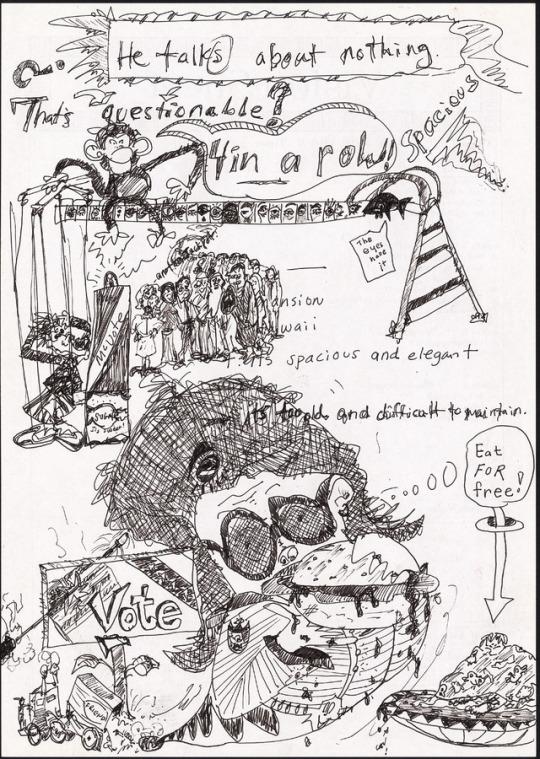
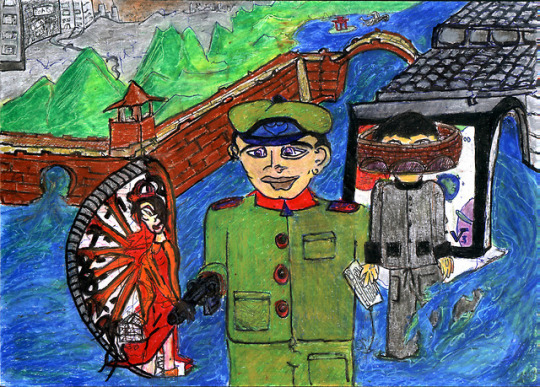



KNOT 4 PROPHET
By Michael M Clements
Open your mind and take this journey with me for a minute. I believe, like many artists, that when an artist creates, especially extemporaneously, they are channeling into an unknown place and time and connecting with a part of the time space continuum that we, as humans, have yet to fully understand. It’s a place where time is not linear; where clues, frequencies and vibrations from present, past and future exist as one in a nebulous caldron of ideas, thoughts and happenings which have all been released from our linear concept of time and thus exist as one, at the same point in non-time, like a living dream. I know this from experience. About 20-25 years ago, I had a stretch where I did a lot of extemporaneous drawings mostly on paper with pen, marker, oil crayon, highlighter and whatever else I had laying around. I had no training. This wasn’t for any reason or exhibition. In fact, I didn’t even know I was an artist them. I would just draw because I felt like I had to. It was before I worked in canvas and paints. Today it’s considered Outsider art. What it lacked in technicality it made up for in proficient prophecy. Over the years, the works have revealed themselves to be rather prophetic foretelling and producing images and scenarios that eventually came to pass, and many still to come I believe. In a Nostradamian way, they are cryptic and open for interpretation; but the connection to current events can not be denied. I knew none of this when I created them; at the time, I was merely channeling and tapping into this intangible cosmic universal mind (our better yet, “cloud”) to cull references and elusions from the ether. Finally, after several decades, I’ve begun curate some of the images for an exhibition entitled “Knot 4 Prophet”... now, if I could just decide on a date in the future...?
1. SWAN SONG, circ. 1996
Then... A blonde haired man, large—a centerpiece; looks solemnly on. His swan song is silenced by a vagina. There is a web. A sting. Deception. And a lot of disparate lines and images creating a frenetic and disjointed information pattern. Is that a cheese grater?
What’s come to pass... Well, hello Donald Trump. This tells your future too. When you are eventually silenced in your final swan song.
Today’s themes ... #trump #metoo #timesup
Artist, Michael M. Clements; Mixed media on paper, 8.5x11. Image by Genki Media® LLC. All rights reserved, 2018.
2. HE TALKS ABOUT NOTHING, 4 IN A ROW, 1994
Then... A political themed piece. Voters line up to a ballot box but a monkey pulls the strings. Meanwhile an authoritarian clad figure emerges from a dump truck called “friend” devouring all he can in an endless buffet called “Eat for Free.” A bullet pierces the US flag emblazoned with the word “Vote.” Words like “He talks about nothing,” “That’s questionable,” “Mansion,” “Hawaii,” “Its’ too old and difficult to maintain,” “Spacious and elegant.”
What’s come to pass... The monkey is Putin. He pulls the strings to the election resulting in an authoritarian leader that is devouring our state’s riches. Its all about the vote.
Today’s themes ...#russianbots #electionmeddling #nra #gunculture #authoritarianism #trumpism #corporategreed #votersuppression #democracy #uselections #fairelections
Artist, Michael M. Clements; Mixed media on paper, 8.5x11. Image by Genki Media® LLC. All rights reserved, 2018.
3. THE GREAT FLOOD, 2003
Then... This is the new China: government control and economic growth in a constant struggle against environmental breakdown and the great flood of information. A damn breaks and water floods the countryside. A man with a wall around his head stands with a keyboard in his hand; a PLA soldier stands next to him outwardly firm, yet inwardly conflicted. Forcing his weapon down is a women dressed in a Buddhist robe; she rips though the painting to remind us all that the ecological clock is ticking. The lush mountains of the idyllic China countryside are just a façade; behind them reality – strings of gray industrial centers covered in toxic air and POAD signs.
What’s come to pass... Remember this image was before the great internet wall of China was in full effect. I’d say, this represents China today— the battle between gov to censor its people. The fight for Tibet / spiritualism. One interesting note is that its the female embodiment of Buddhism that is pushing the central figure’s—representing the Chinese Communist party—gun down. Effectively disarming it. That, has yet to come to pass.
**Today’s themes ... **#china #statecensorship #digitalprivacy #riseofchina #chinesepollution
Artist, Michael M. Clements; Mixed media on paper, 8.5x11. Image by Genki Media® LLC. All rights reserved, 2018.
4. VOTE FREEDOM / THE FLAG IS BURNING, 1993
Then...A comment on America’s use of force to solve international issues. The flag is burning – the flag of freedom, the flag of culture, the flag of our global community. Between a stylized U.S. & Chinese flag and the outline of Africa lies a highway, representing the technological divide between the have and have-nots. In the centre, a warship and jet cascade carry bombs and freedom. To the right, a characterized Middle-eastern man has shot himself in the hand; he sits on top of the pillars of “oil,” “wood” and “food.”
**What’s come to pass... **This is more tied to Obama and the foreshadowing America’s first African American president. Words like “culture,” “society” and the use of a highway dividing the art work. I also, now see that the flag looks like a combination of US, Chinese and Confederate flag. There is a hand grabbing a pipe. Legalization? All the military references are as poignant 25 years later as they were then.
Today’s themes ... #obama #usmilitary #suburbia #middleeastturmoil #naturalresources
Artist, Michael M. Clements; Mixed media on paper, 8.5x11. Image by Genki Media® LLC. All rights reserved, 2018.
5.TECHNOLOGY TOO BIG, 1998
Then... An eerie premonition of both the events of 9/11 as well as the ongoing rise of AI. This was before smartphones. Before AI. Before google, facebook, etc; before the concept of the singularity. Originally meant to be a comment on the pace of technology and it affect on culture. A train barrels through a tunnel. In its headlights, two humans that look like germs. There is a piano with music being uploaded to a human brian. A human head on a computer chip. In the top right, a helicopter over a burning metropolitan sky line of New York and a man holding a gun in one hand and a bird of peace in the other...
What’s come to pass... with the burning sky line of New York and a man holding a gun in one hand and a bird of peace in the other… the piece has taken on a new dimension following 911, essentially its a prediction of 911 14 years early. But, this piece reverberates today. Technology continues to barrel forward. And AI is taking over. Eventually our brains and the computer chip as one—indeed this piece sees “the singularity.” This piece sees it all and more.
**Today’s themes ... **#911 #AI #computertakeover #thesingularity #technology #futurism #brainchips
Artist, Michael M. Clements; Mixed media on paper, 8.5x11. Image by Genki Media® LLC. All rights reserved, 2018.
6. BOY IN THE BALLOON, 2002
**Then... **A man reads a book, it resembles a bible, he holds a large peach balloon. Within that, a boy holds a red balloon, beside him, a cuckoo clock. Around them, hectic scenes of movement and modernity: An apartment building blasts to the sky, dinner falls from an upside down table, sharks circle an electric plug connected to a mouse. The man holds a needle – does he intend to pop his balloon or dive into the modern world? The man about to pop it all is reading a religious textbook.
**What’s come to pass... **A couple things. First the upside down table has a stock chart on it. This foreshadowed the stock market meltdown on 2008. Sharks in the water. Electricity in the water. All dangerous. Lethal. The peach, the ballon, they are both bubbles about to be burst. The biggest future shout out is the rocket. Humanity taking to space to live. The man about to pop it all is reading a religious textbook. How about the religious counteraction to all of this? The entire bubble bursting is being influenced while the man read scripture.
**Today’s themes ... **#stockcrash #stockmarketbubble #spaceexploration #humansinspace #religionandtechnology
Artist, Michael M. Clements; Mixed media on paper, 8.5x11. Image by Genki Media® LLC. All rights reserved, 2018.
0 notes
Text
NSS Report Card
(Volume 24-11)
By David Pugliese
After years of delays there is now some solid movement on the National Shipbuilding Procurement Strategy (NSPS).
The initiative, now referred to by the federal government as the National Shipbuilding Strategy or NSS, is the largest maritime building program since the Second World War and represents a massive amount of work for potentially large numbers of Canadian companies.
Irving Shipbuilding has been selected by the government to construct 21 combat vessels under the NSS, while Seaspan will build the non-combat vessel work package of 7 vessels in total.
The first-ever large vessel designed and built under the NSS — one of the Canadian Coast Guard’s Offshore Fisheries Science Vessels (OFSVs) — is expected to be launched in December by Seaspan’s Vancouver Shipyard. That ship is the Sir John Franklin.
An event to celebrate the launch will be held December 8, noted Tim Page, vice president of government relations for Seaspan Shipyards. A second as-yet-unnamed OFSV will be launched in April 2018 and the final one in November of that same year.
The Canadian Surface Combatant (CSC) project, also part of NSS, is moving forward, although arguably slower than first expected.
Bids for the ships, which will be eventually constructed at Irving Shipbuilding Inc. in Halifax, were submitted on November 30. The CSC is the largest, most complex procurement undertaken by the government, according to Public Services and Procurement Canada.
Bidding and construction have been delayed a number of times so far. At one point, construction of the vessels was supposed to start in 2018 but that milestone now seems to be a distant thought.
The ships being built will form the backbone of the Royal Canadian Navy. Fifteen are to be constructed.
Lisa Campbell, Assistant Deputy Minister for Defence and Marine Procurement at Public Services and Procurement Canada, said bids will be evaluated in early 2018 and the winner is to be determined later that year. Construction of vessels is expected to begin in the early 2020s, she added.
The cost of the program is almost $62-billion, according to a study released in June by the Parliamentary Budget Officer.
There is also work being done on the Joint Support Ship or JSS, another vessel to be built under NSS.
Seaspan is buying long-lead items for JSS as it prepares for the construction of the vessels. “We’re using a supply base that is as Canadian as it can be so the ship can be efficiently maintained over its lifecycle,” said Brian Carter, president of Seaspan Shipyards. “As we buy new pieces of equipment those are reflected in the design and detail. That is a large part of the effort.”
Canada selected the German Navy’s Berlin-class design for the JSS fleet.
Carter noted there are currently 1,200 employees at Vancouver Shipyards, where the non-combat vessels are being constructed. But he said that number would increase by another 300 once construction of the JSS fleet is underway.
In the meantime, there are about 200 Seaspan staff dedicated to the JSS program at this point.
The Department of National Defence has noted there has been a slight slippage in the delivery of the ships. In the 2014–2015 Departmental Performance Report, the target date for first delivery of the Joint Support Ships was in the last quarter of 2020.
As a result of challenges associated with completing the detailed design and organizing the entire supply chain, the JSS first delivery date slipped by a number of months to early 2021, DND has pointed out.
At the same time, the union representing workers at the Seaspan Shipyards is warning that some of those employees could be facing layoffs because of downtime in the federal government’s shipbuilding program.
There is expected to be a gap between the end of construction of the third and fourth federal government vessels.
Seaspan’s Page said the company is trying to drum up new work from the federal government and other commercial sources to deal with the gap.
“We do anticipate a production gap and while clearly not welcome, swings in a shipyard’s workforce is not unusual around the world,” Page explained. “We’re doing everything we can to mitigate that gap through work that we’re competitively and aggressively competing for in both the commercial and the government environments.”
At Irving, besides dealing with the bids on the Canadian Surface Combatant project, the company is preparing the first Arctic Offshore Patrol Ship (AOPS) for launch. That is expected to come sometime in 2018.
But Irving has also been dealing with growing anger in some quarters over its use of foreign workers on the NSS.
In February, news reports detailed how the union representing shipyard workers was upset that Irving was hiring outside of Canada for various positions. There was recruitment in Poland as well as a subcontract Irving had with the Spanish firm Gabadi LC, which involved Spanish carpenters being brought in to work on the AOPS in Halifax.
Irving responded that specific shipbuilding expertise did not exist in Canada and, under special circumstances, skilled workers had to be sought internationally. Union officials responded that they found it difficult to believe that no one in Canada could fill the needed positions on AOPS.
On October 20 the Halifax Chronicle Herald published a new article about union complaints that 27 ironworkers had been hired from Lithuania and Romania for NSS. Unifor Marine Workers Federation Local 1, which represents employees at the company’s Halifax shipyards, told the newspaper that Irving had not provided proper justification for the hiring of the foreign workers.
The issue is a thorny one since one of the main goals of the NSS is the creation of long-term shipbuilding jobs in Canada.
On the sidelines of the NSS, but very much having an effect on the strategy, is the interim auxiliary oiler replenishment (AOR) ship that has been built by Davie shipyards for the Royal Canadian Navy. MV Asterix was unveiled on July 20 and will soon be ready for RCN operations.
The $670-million project will provide the RCN for the first time since 2015 with its own capability to refuel and resupply its warships at sea. Since the retirement of its own aging resupply vessels (HMC Ships Protecteur and Preserver), Canada has leased the services of Chilean and Spanish navy supply ships at various times.
MV Asterix, known as a Resolve-class naval support ship, will be the largest naval platform in service with the RCN for the foreseeable future and will provide a wide range of functions from at-sea replenishment of fuels and cargo to aviation support, fleet medical support, and humanitarian and disaster relief, Davie officials point out. The project involved the conversion of a modern, European-built containership into an auxiliary oiler replenishment ship, a process that was accomplished in about 18 months.
The ship is expected to be deployed as early as the spring of 2018 to support RCN missions in the Pacific Ocean. In a November 4 editorial, the National Post newspaper called the project “a military procurement triumph.”
In 2011, when Irving and Seaspan were selected under the shipbuilding strategy to construct new federal government fleets, Davie was in financial trouble. But the firm is now back on its feet and wants a share of the action in federal shipbuilding.
Davie is looking for additional similar work and has proposed to convert another commercial ship as an RCN supply vessel, as well as provide an icebreaker and a humanitarian support ship. Such initiatives are seen by federal bureaucrats as a threat to NSS, but Davie argues that isn’t the case. In addition, the federal government has put out requests for information about smaller icebreakers. Davie has those vessels already to go, according to a Davie representative.
The company also has political support from some federal Quebec MPs and the Quebec government. On November 8, members of the National Assembly of Quebec unanimously passed a motion calling on the Trudeau government to amend what it was calling the faltering National Shipbuilding Strategy to include Quebec. Such a move would save 1,200 middle-class shipbuilding jobs, according to the politicians.
Not surprisingly, officials at Davie greeted the support with thanks. “The federal government is going to invest almost $100-billion over the next 20 to 30 years on its fleet renewal,” Alex Vicefield, chairman of Davie Shipbuilding, explained in a statement. “Quebec represents 50 per cent of Canada’s shipbuilding capacity and 23 per cent of Canada’s tax base, yet it is receiving less than one per cent of federal spending on shipbuilding.”
Vicefield said Quebec is at risk of losing a significant number of middle-class jobs due to what he called “bureaucratic intransigence and roadblocks within a broken procurement system, despite the clear and obvious need for Canada to urgently renew the entirety of its fleet.”
He noted that the federal government has acknowledged that its ship fleet is rusting out faster than it can be replaced. Davie argued that the National Shipbuilding Strategy is costing taxpayers too much and is slow to produce vessels.
Vicefield argues the shipbuilding strategy only covers a certain number and types of ships that would be built by Irving and Seaspan. But there are many more vessels that need to be constructed and that Davie should be given a chance to bid on those, company officials argue.
Sources close to Davie say the Quebec government and unions are trying to mobilize Quebec Liberal MPs to put pressure on their government to change the shipbuilding strategy.
But whether the Liberal government alters NSS to deal with concerns from Quebec and Davie remains to be seen.
0 notes
Text
In perspective: the loss of HMS Sheffield
35 years on from the sinking of HMS Sheffield by an Exocet missile, the full and un-redacted Board of Inquiry (BOI) findings have been made public. A heavy-handed piece by Ian Cobain in the Guardian heaps blame on the ship’s operations team and implies results of the inquiry was subject to a sinister cover up .
Mr Cobain’s article is reasonably well researched but the bare facts need to be seen in their full context before making accusations. Unless you were aboard HMS Sheffield between 14.00 and 14.04 on 4th May 1982, you can never know precisely what happened or what it felt like to be on the spot. Despite the supposedly reliable evidence of the board of enquiry now available, we should exercise caution when passing quick judgments on the actions of men on the frontline 35 years ago. Theoretically, the statements of fact recorded during the BOI should be accurate, but years later some of its contents are still contested by those who were there. What is certain is that there were failures at many levels that led to the destruction of Sheffield. Who should be blamed and to whether blame should be apportioned at all is a complex matter.
Something wrong with our bloody ships
In 1982 the RN was primarily an anti-submarine navy, much of its institutional focus was on the threat posed by the Soviets and in particular their submarines. The RN did, however, still regularly deploy outside of the NATO areas, HMS Sheffield had just spent 6 months in the Persian Gulf when she was sent to the Falklands. The ASW focus had resulted in a navy that retained a broad spectrum of capability, but the heavy investment in its critical nuclear submarines had contributed to a surface fleet that was inadequately armed and equipped.
The Type 42 destroyer was designed as an air defence ship and built to a tight budget resulting in a slightly compromised platform. The main Sea Dart system was usually very effective against medium and high altitude targets but the fire control radars did not have the ability to successfully track low-level targets. Although the sea-skimming missile threat was well understood and the RN possessed their own ship-launched Exocets, the entire Royal Navy fleet of the time lacked effective Close In Weapons Systems (CIWS). (The only exception were the new Type 22 frigates armed with very effective Sea Wolf). This was a glaring institutional failure that is hard to explain, especially as the Soviets had many potent anti-ship missiles. Space and funding constraints would not allow the fitting of the Sea Wolf missile on the Type 42 and the only back-up weapons were 2 manually-aimed 20mm Oerlikon cannons, dating from WWII. The Sea Dart was not always reliable and it seems extraordinary that a cheap second line of defence consisting of several modern 20 or 30mm cannon mounts had not been fitted. The Sheffield also lacked basic electronic jammers that could confuse missile radars. The best option would have been the Phalanx CIWS that had been in development since 1973 and was proven in service with the US Navy by 1980. Phalanx is entirely automated and would almost certainly have saved the Sheffield. It was hurriedly purchased by the RN and subsequently fitted to many surface ships, it is still in service today.
The only other potential defence against Exocet was the chaff launcher which fired clouds of aluminium strips that create false radar echoes to lure the missile away from the ship. Chaff was successfully and liberally used by the task force later in the war but relied on alert reactions, perfect timing and ship handling to place the ship away from the chaff cloud as it floated downwind.
There also existed many shortcomings in warship design and equipment fit that were quickly exposed by the Exocet strike. The use of formica panels were a hazard that created lethal flying shrapnel shards when subject to blast. Some escape hatches were found to be too small for men dressed in breathing apparatus. The Rover portable fire pumps were unreliable and there was inadequate fire-fighting equipment held onboard most ships. There was insufficient attention to the dangers of smoke in the design of ventilation and provision of fire curtains. Standard issue nylon clothing was found to have melted in contact with fire, severely exacerbating burns. The ship contained PVC cable insulation and foam furnishings that gave off toxic fumes in a fire.
No single individual can be held accountable for these decisions which are typical of a long period in a peacetime mentality where painful lessons learned in past conflicts fade from consciousness and funding pressures result in corners being cut.
Accusations
The BOI implied that despite the inadequacy of the ship’s equipment, Sheffield could have saved herself by being better prepared. It is clear the operations room was not functioning well when the missile was detected, 30 seconds before impact, but part of this was unfortunate timing.
The Captain was resting in his cabin at the time and “The anti-air warfare officer had left the ship’s operations room and was having a coffee in the wardroom while his assistant had left to visit the heads”. No one can be on duty 24/7 and everyone had to pace themselves and take breaks. Fatigue was a particular problem for commanders in the Falklands who could not fully relax for weeks on end. The timing of these absences was exceptionally unlucky but not an indicator of slackness. When hit, Sheffield was not at actions stations which requires the entire crew to be closed up, but in defence watches where half the crew are on watch while the other half rest.
The BOI did find that the Principal Warfare Officer did not react as he should have and the AA Officer was absent from the ops room for too long. Sister ship, HMS Glasgow detected the aircraft and Exocets and reacted better. In a further stroke of bad luck, at the exact moment of the attack, Sheffield was making a transmission on her SATCOM which blinded her UAA1, a masthead sensor which could detect electronic emissions from aircraft and missiles, further reducing potential warning time. As the Guardian reported with relish back in 2000, the Entendard aircraft were detected by radar operators on HMS Invincible, a full 19 minutes before the Exocet hit Sheffield. Plagued by a series of false contact reports in the preceding days, the senior officer on Invincible responsible for air defence of the whole task force classified the contact as “spurious” and no warnings were issued. It was not just a few men on Sheffield who were on a steep learning curve in the early part of the war.
The Guardian quotes the BOI as saying some of the crew were “bored and a little frustrated by inactivity”. This has been selectively quoted by the Guardian article – the BOI actually says in the preceding sentence “the atmosphere on board was tense but there was no evidence of complacency.” The easy victory at South Georgia and the simple sinking of the cruiser Belgrano had given rise to a perception back in the UK that the war would be “a walk-over”. This was not that case amongst the task force as is clear from the biography of Admiral Sandy Woodward. Sheffield’s CO, Captain Sam Salt was an experienced officer and a seasoned submariner. He was perhaps more concerned with the submarine threat over the air threat but this is was partly due to faulty intelligence assessments and confusion among some officers about whether the Argentine airforce was capable of air-air refuelling required to get within range. Virtually every personal account of the Falklands war notes the poor quality of intelligence about the Argentine intentions and order of battle that was provided to the task force from London.
The BOI reports that when the incoming missiles came into view, officers on the bridge were “mesmerised” by the sight and failed to broadcast a warning to the ship’s company. This is not consistent with accounts of survivors who say that Sub Lieutenant Clark who was on the bridge, saw the incoming Exocet and shouted “missile attack, hit the deck!” over the main broadcast.
In keeping with history
Conflicts throughout history are littered with examples of mistakes, particularly at the start of hostilities. The loss of HMS Sheffield was a horrible shock to the RN and was news around the world. But lessons were learned and procedures are changed rapidly. The painful experience gained probably saved others, it was no coincidence that later in the conflict HMS Glamorgan survived an Exocet hit. The ship was alert, detected the missile and made a pre-planned turn that prevented the missile from penetrating the hull and main missile magazine.
youtube
Aftermath
Admiral John Fieldhouse who commanded the Taskforce from Northwood and later became First Sea Lord, decided not to court-martial officers on Sheffield who were implicated by the board of enquiry. Fieldhouse was noted for his humanity and was one of the most outstanding officers the RN has had since WWII. There are those who would like to portray this as a “cover up” but people who may have made fatal mistakes in combat have to live with the consequences of their actions for the rest of their lives. There are men that are still suffering today from the effects of what they experienced onboard HMS Sheffield and many of the veterans are angry about the release of the BOI and the Guardian article which they call “misrepresentative” and an “insult to the heroes of that day”. The Guardian article also hardly mentions the many outstanding acts of courage by the ship’s company in trying to save their ship after she was hit, some of which are recorded in the BOI report.
Having won the war, it made more sense to focus on how things could be done better in future than hand out punishments for failure. Undoubtedly mistakes and errors made during the conflict were kept in-house. Some of those who suffered loss or injury may want to see specific individuals named and punished but as discussed, it was a collective failure. Airing the dirty washing in public may have achieved little, added to the suffering of the bereaved and detracted from what was an incredible achievement overall. Sister ship HMS Coventry was sunk later in the conflict despite being alert and ready. In every armed conflict mistakes are made, usually, it costs lives but this is the terrible nature of warfare. Hindsight is a wonderful thing but is it not a luxury anyone has in the moment. The RN did conduct extensive analysis what happened and the lessons from the Falklands led to drastic changes to warship design, training and concept of operations. Many of these lessons are still kept alive in the RN today, particularly by the globally-renowned Flag Officer Sea Training organisation.
Responsibility starts at the top
The Falklands War was ultimately a triumph for Mrs Thatcher, standing against tyranny and holding her nerve while others would have given in. However, it could be argued that it was the actions of her government that created the conditions for the war in the first place. John Nott’s 1981 Defence white paper planned to axe South Atlantic Patrol ship HMS Endurance, together with the Navy’s aircraft carriers and amphibious capability and was perceived as a green light by the Argentines. Numerous officers and diplomats had tried to warn the Foreign Office of exactly what could happen if British resolve to defend the Falklands was seen to be waning. The men who died on HMS Sheffield might perhaps still be with us if the Thatcher government had not planned those defence cuts.
The principal of armed deterrence remains every bit as relevant. Spending on a properly equipped navy now may ultimately save bloodshed and far greater loss in a future conflict. This principle was ultimately proven in the peaceful victory of the Cold War and politicians of today would do well to consider this.
Related articles
Revealed: catalogue of failings that sank Falklands warship HMS Sheffield (Guardian, Oct 2017)
PTSD fears aftershock report on HMS Sheffield sinking is revealed (Portsmouth News)
Officers dismissed radar warning of Exocet attack on HMS Sheffield (Guardian, Sept 2000)
Ordeal by Exocet (Book – Ian Inskip)
One Hundred Days (Book – Sandy Woodward)
from Save the Royal Navy http://www.savetheroyalnavy.org/in-perspective-the-loss-of-hms-sheffield/
0 notes